



















unique feed to improve production, health and fertility. The benefits of omega 3 all year round. high energy high oil content (Omega-3) high digestibility high protein Lintec is a specific variety of linseed, high in Omega-3 fatty acids, that has been specially processed to produce a unique feed for dairy cows. It is a sustainable high quality feed, suitable for all dairy production systems. For more information contact your local account manager or call: 0330 678 0982 info.uk@forfarmers.eu www.forfarmers.co.uk
38-47
SPECIAL DAIRY-TECH
TIP OF THE MONTH: Collaboration key to improve foot health – p16
26-27 January 2024 Volume 71 Issue 1
Dairy Summit
The
Pages
Pages 28-36 MAIZE
PREVIEW Handy advice ahead of the growing season Sneak peek of what you can expect from the event Pages 22-24 BULL PROOFS MILK PRICES Pages 52-54 Brand new entrant in genomic sires top list
Pages
World
Global industry is a diverse beast


Join the UK’s largest low carbon agriculture event. The best place to understand the present and the future of farming and land management.









TO FIND OUT MORE
Scan the QR code or visit lowcarbonagriculture.co.uk

Energy solutions | Farm technology solutions | Low emission vehicles | Business solutions Farmers, landowners and land managers 3,000+ Technology and service providers 150+ Informative presentations 100+ Days 2 Owned and produced by Powered by Founding partner In partnership with

Contacts

a word from the editor
Iwould like to start o by wishing a Happy New Year to you all. Last year was dominated once again by high costs of production, ooding events and business uncertainty, as farmers grappled with changes to support payments.
Many of these concerns will carry over into 2024, and there is much to speculate on in terms of milk prices, the continuing impact of weather extremes and the direction of travel in the world of politics.

It is widely thought that 2024 will be a General Election year, and like many of you I am sure, I will be eager to hear what all the political parties have to say about our industry.
It is vital food security is a top priority for the Government and it is more important than
ever that the party in power is able to support the country’s farmers and help grow the sector.
Arla’s price rise for January was welcome news and, while there are no signs of other dairy processors moving along a similar course just yet, it does breathe an air of positivity into the industry.
Maize special
In this edition, we look ahead to the 2024 maize growing season by highlighting some newer varieties and take a deep dive into di erent cultivation and establishment techniques.
Dairy-Tech is also on the horizon and I look forward to seeing some of you at this event. I am hoping that by then some of you will not need a boat in order to get o -farm.

3
Dairy Farmer, Unit 4, Fulwood Business Park, Caxton Road, Preston, Lancashire PR2 9NZ Origination by Farmers Guardian, Unit 4, Fulwood Business Park, Caxton Road, Preston, Lancashire PR2 9NZ. Printed by Precision Colour Printing, Halesfield 1, Stirchley, Telford TF7 4QQ. No responsibility can be accepted by Dairy Farmer for the opinions expressed by contributors. Editor Katie Jones 07786 856 439 katie.jones@agriconnect.com Content Editor/Designer Mike Begley 01772 799 405 mike.begley@agriconnect.com Picture Editor Marcello Garbagnoli 01772 799 445 marcello.garbagnoli@agriconnect.com Sales Director Stephanie Ryder 07917 271 987 stephanie.ryder@agriconnect.com Account Manager Mark Jackson 01322 449 624, mark.jackson@agriconnect.com Classified Advertisements 01772 799 400 fgclassified@agriconnect.com Advertising Production Justine Sumner 01772 799 437 Fax: 01772 796 747 justine.sumner@agriconnect.com Circulation and subscriptions 0330 333 0056 help@subscribe.farmers-guardian.com Subscription rates: UK £65 a year Europe: £85 World: £95 ISSN 1475-6994 © Farmers Guardian 2024 All rights reserved. No part of this publication may be reproduced or transmitted in any form or by any means, electronic or mechanical including photocopying, recording, or any information storage or retrieval system without the express prior written consent of the publisher. The contents of Dairy Farmer are subject to reproduction in information storage and retrieval systems.
JANUARY 2024
What’s inside?
New year che
Dairy farmers have welcomed some new year cheer from Arla with a jump in the price from January 1.
It means the co-operative will pay 39.18ppl for conventional and 46.50ppl for organic milk in January on a manufacturing litre, which it hoped would boost farmer confidence.
Arla Foods amba board director and Arla farmer Arthur Fearnall hailed a ‘good start to the new year’.
He said: “Retail sales continue to pick up after the turnaround in Q3 in 2023. Global commodity prices continue to recover as well. However, they are slightly weakened after seasonal demands are fulfilled.”
Dairy analyst Chris Walkland said that while he was anticipating a rise, he had not been expecting such a significant one, highlighting Arla was talking about an improved retail performance.


He said: “It is a very welcome surprise for Arla members. It puts them back at the top of the table.”
Bruce Mackie, NFU Scotland
Dairy offers better value for money
JDairy and meat products offer value for money against plant-based alternatives when looked at on the value of product nutrition.
On a percentage basis, the cost per kcal of a conventional diet was found to be 28% lower than that for the vegan basket.

10-12 On Farm 20-21
That was the message from an 18-month-long study commissioned by dairy consultancy firm Kite and AB Dairy, which compared two baskets of a random selection of vegan foods and brands alongside their conventional ‘twins’ from three supermarkets: Tesco, Sainsbury’s and Asda.
The calories (kcal) per 100g were recorded and the total in each pack was determined from the weight. The cost of each product then allowed the cost per kcal to be calculated.
Regarding how many kcal £1 would buy, a conventional basket would buy 340kcal and the vegan basket would buy 240kcal.
Cost
John Allen, founder of Kite Consultancy, said there was not a lot of talk about the cost of plant-based diets.
“We just hear about the environmental side of dairy and livestock and not the whole package,” he said, adding the study showed when buying calories dairy gave consumers ‘more bang for their buck’.
NEWS 4
8 DAIRY TALK Updates from Ifan Roberts and Gemma Smale-Rowland 10 ON FARM Forage foundation for dairy business 14 DAIRY MATTERS ‘New year, new gamekeeper in chief, new era for fairer milk supply chain power balance?’ 16 VET’S VIEW Collaboration on cows’ foot health pays off 18 YOUNGSTOCK A clear focus on winter calf health 20 WORLD DAIRYING Building a less labourintensive farming future in Germany 22 BREEDING Brand new entrant in genomic sires top list 26 WORLD DAIRY SUMMIT 28 MAIZE Handy advice ahead of the growing season 38 DAIRY-TECH PREVIEW Sneak peek of what you can expect from the event 48 MACHINERY Silence is golden with the Polaris Ranger Kinetic 52 MILK PRICES 56 MILK ANALYSIS 58 NEW PRODUCTS Round-up of products and updates hitting the market 62 GOOD EVANS ‘It isn’t the diagnosis that’s the problem, it’s access to the drugs’ 64 BUSINESS CLINIC Dairy land market still looking strong 66 RESEARCH Slurry trials help inform decisions JANUARY 2024 VOLUME 71 ISSUE 1
JANUARY 2024
World Dairying
Arla Foods amba board director and Arla farmer Arthur Fearnall hailed a ‘good start to the new year’.
er for Arla farmers Farming figures in New Year’s Honours List

milk committee chair, said it was ‘a great step forward’ and farmers should be pleased by the news.
He said: “The news was expected with improved market signals from countries such as New Zealand.”
Muller has confirmed its price will hold at 36.5ppl for February, with Saputo also holding at 36.5ppl. Barber’s cheesemakers announced a 1.03ppl rise from February, to 38.20ppl for the Barber’s standard litre.
Michael Oakes, NFU dairy board chair, said it was ‘long-awaited news’.
He said: “It is positive to see prices going up quicker, which is in correlation with other countries across the world.
“At a time when confidence among farmers was at an all-time low last year, this will give producers some positive outlook for their future.”
Pressure
He added it would put pressure on dairies to increase milk prices.
On other dairies not moving, Mr Walkland said Muller had offered a consistent price through 2023.

He said: “I do not think any Muller farmers should be complaining about their milk price.”
Looking forward, Mr Walkland said it was difficult to see what would happen in the next few months, but it was all about supply and demand.
EU milk production was down significantly and he also highlighted falling food inflation, with dairy retail prices down.
“That may well help demand,” he said.
rFor more on the latest milk price moves, see pages 52-54.

JIndustry leaders, agricultural community champions and even celebrity farmers were among those named in the King’s New Year’s Honours List.
Michael Eavis, founder of Glastonbury Festival and dairy farmer, received a knighthood for services to music and charity in this year’s list.
Chair of the sustainable farming group Linking Environment and Farming, Philip Wynn, has been made an OBE for services to farming and the environment.
Dennis Matheson, chair of the Welsh Tenant Farmers Association, was made an MBE.
Mental health
Adam Watson, a dairy farmer from Coleraine, Co Londonderry, was awarded a British Empire Medal for services to mental health in the farming community in Northern Ireland.
Andrew Arbuckle, trustee and fundraiser for the Royal Scottish Agricultural Benevolent Institution, was awarded an MBE for services to farming and to the community in Fife, while East Sussex-based John Simpson was honoured for services to agriculture and the community of Lewes.

AGRICULTURAL & INDUSTRIAL STEEL FRAMED BUILDINGS Livestock Housing, Crop Storage, Industrial & Commercial, Tip Troughs Schurr Cow Brushes BEDDING MACHINES Telephone: 01524 792247 e-mail: sales@rebuildings.co.uk www.rebuildings.co.uk Scrape, Sweep and Spread in one pass. Bedding Material and Labour saving. Reduce cell count and increase production. Prevent disease and maintain good animal Health. Self-loading models available. Simple to drive and manoeuvre. 1 or 3 wheel drive. ELECTRIC ASK FOR DETAILS NOW AVAILABLE NEW
NEWS 5
JANUARY 2024
Organic farmers urged to ‘hold their nerve’
Organic farmers are being urged to ‘hold their nerve’ with ‘better times ahead’ after a challenging time, with their premium squeezed and a milk price which, for most, did not reflect their high input costs.
There has been financial pressure across the UK dairy market over the last 12 months, but for some organic farmers there have been greater challenges with organic feed costs and availability, forcing some farmers to scale back on production.
The Soil Association’s organic sector adviser Adrian Steele urged retailers and processors to invest in the ‘long-term growth of organic’, adding his concern of hearing a number of farmers either switching to conventional or quitting altogether.
He said organic farmers were telling them incomes had fallen by 20-30%, but the price differential between organic and non-organic milk was increasingly ‘disproportionate’.
He said: “Something does not add up here. Clearly the processors, wholesalers and retailers need to
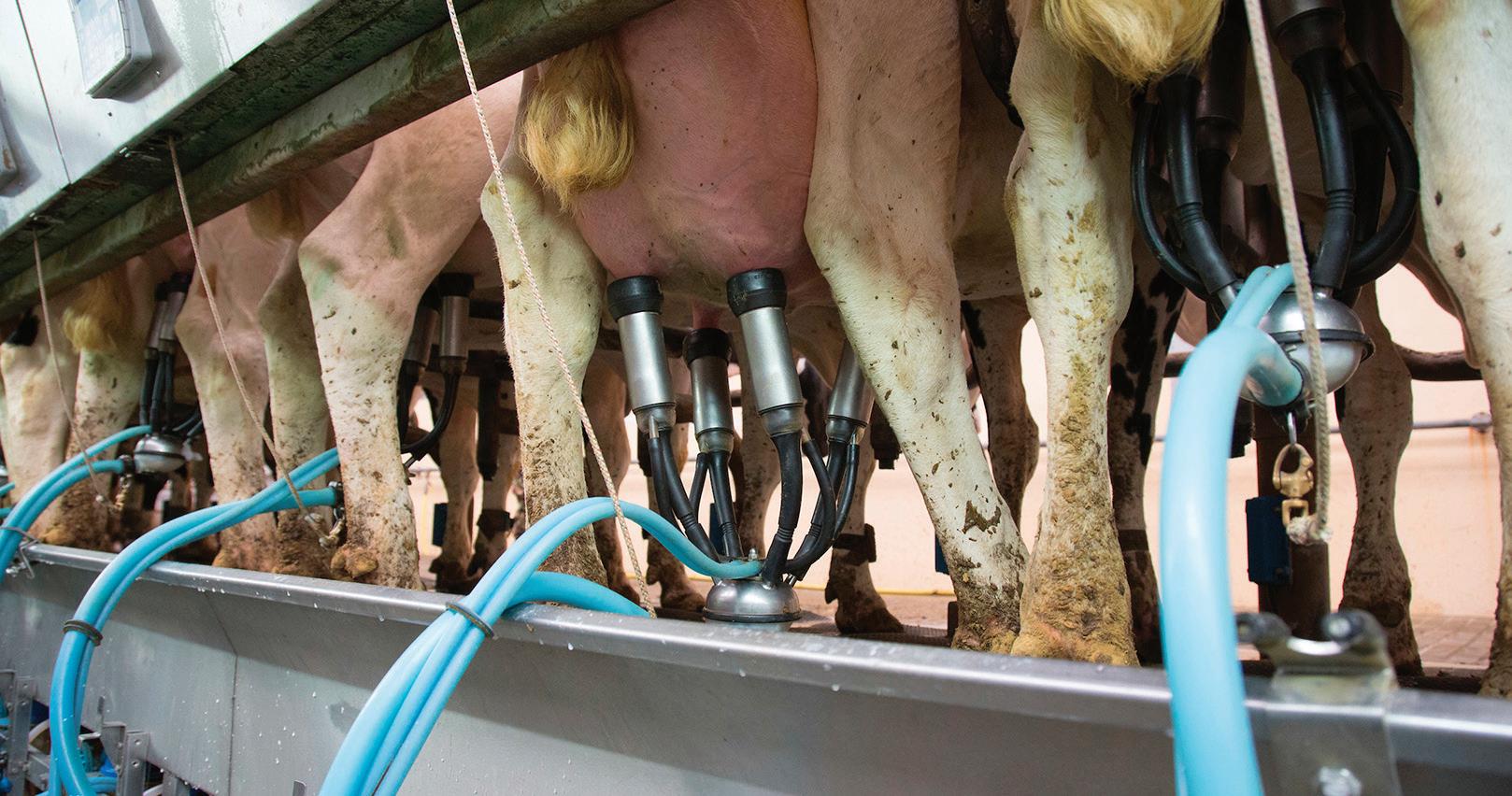
make a profit, but something in the supply chain economics is distorting the market and leaving many shoppers blind to the benefits of organic for the environment, animal welfare and nature.”
With consumers continuing to be price-sensitive, many organic farmers question how long the demand slump will continue for.
Dan Burdett, a Dairy Farmer Dairy Talk writer, looks after a 480cow dairy herd across two farms in
West Sussex, supplying milk to Arla as part of an autumn-calving system.
Messaging
Mr Burdett said messaging was key, arguing the focus should be on promoting organic as a system which does not use chemicals, but he admitted there were challenges around this.
Mr Burdett highlighted seasonality was also an issue for his milk price with a lot of milk
produced in spring, calling for organic to be pushed in spring.
Adam Westaway, an organic dairy farmer from South Molton, Devon, supplying Organic Herd, said 18 months ago he was deliberating whether to switch back to conventional.
However, he now felt the market was ‘starting to strengthen’. He called for collaboration between all sector representatives to drive the sector forward.
More options for SFI announced by Defra
JDubbed by the Defra team as ‘the biggest upgrade’ to the UK’s farming schemes since leaving the European Union, Defra Secretary Steve Barclay used his first Oxford Farming Conference speech to announce a series of updates. Funding uplifts, a streamlined single application process and additional support for the rollout of new technology were announced.
Defra said there would be a 10% increase in the average value
of agreements in the Sustainable Farming Incentive (SFI) and Countryside Stewardship schemes, driven by increased payment rates.
Profitability
But some in the industry questioned whether these payments were based solely on income forgone and whether farmers in reality could still run a ‘profitable farm business’ alongside environmental work. Defra also revealed 50 new
actions, which included support for uplands and grasslands, adding there would be premium payments for actions with the biggest environment impact, such as £1,242/ hectare (£503/acre) for connecting river and floodplain habitat and £765/ha (£310/acre) for nesting plots for lapwing.
Mr Barclay believed the implementation of such improvements would help to ‘strengthen supply chains and deliver the
Government’s commitment to produce at least 60% of the food we eat here in the UK’, adding the schemes were designed to work for all farm types and sizes, with thousands of farmers across England already taking part.
The question of whether SFI would ensure sustainable food production remained viable in England was something which concerned the NFU, with stakeholders worrying whether the focus was solely about meeting environmental targets.
NEWS 6
JANUARY 2024
Financial pressures have forced some organic farmers to scale back on production.

“Balancing mineral levels to meet requirements, without oversupply or undersupply, is important from an environmental and financial perspective – we call it Responsible Minerals.”

Alicia Wilson Ruminant Nutritionist
Trouw
Nutrition GB

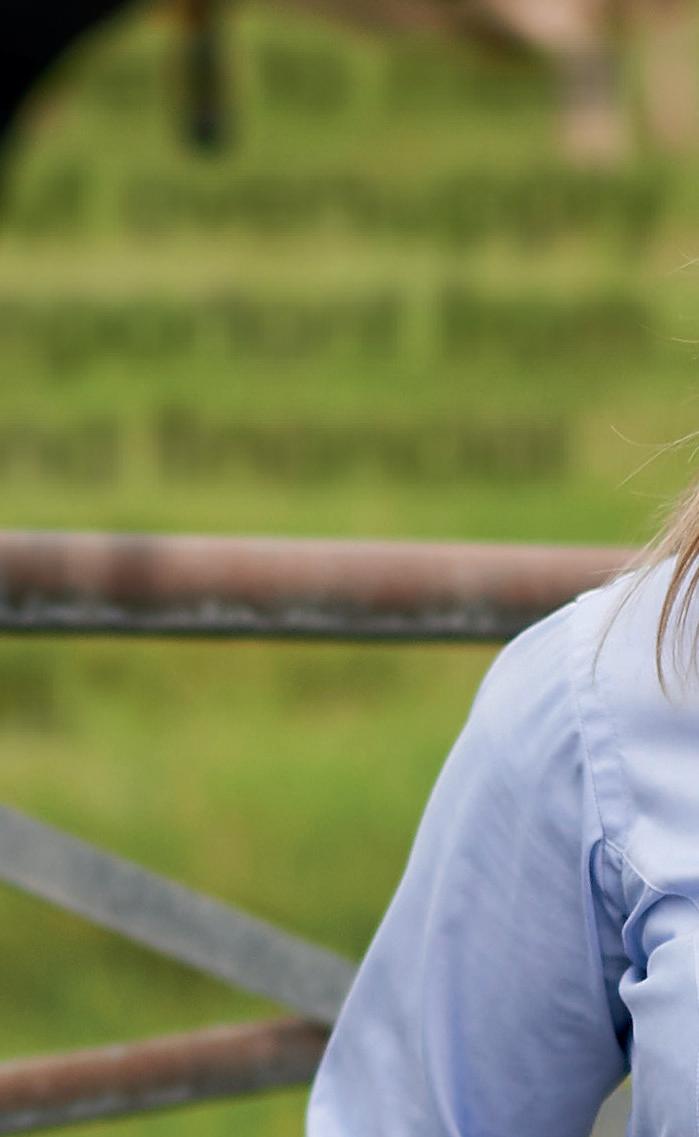
Includes HYDROXY TRACE MINERALS
• Improved fibre digestibility
• High relative bioavailability
• Healthier, more productive animals
For more information visit trouwnutrition.co.uk/maxcare
 Ifan Roberts
Ifan Roberts
DAIRYTalk
Ifan Roberts is herd manager at Houghton Lodge, Leicestershire, which is one of the farms managed by Evolution Farming. This farm runs more than 1,000 cows on a spring-calving system.
“ Since this time I have now leased cows to five different dairy businesses
Having figured out at a relatively young age that one day I wanted to have a dairy farm of my own, I knew that with very little capital to start off with this was going to be a real challenge.
Luckily, at 19 through working for a joint venture between my father and a local farmer, I learned about cow leasing. In this agreement my father was renumerated with a 10% return on capital, plus a depreciation fee for his cows as a basic payment, then he would receive a divisible surplus split at year end as his profit share.
I calculated that this was a reasonably viable proposition, but only if the cows had good longevity. If our annual replacement rate was 15% or below, then a small profit could be made from the leasing, but if it crept over 20%, we were at a loss.
In 2015, when cash was scarce but we were looking to grow numbers, I offered to sink my life savings into the cause and off I went to a dispersal sale at Beeston market and bought 12 cows.
My first cow rental cheque the following month came to a whopping £143, which did not feel overly exciting as a return for my £9,000 investment.
But I do remember calculating what my cheque would have looked like if I were to have 300 cows and thinking that would not be bad earnings with very little expenditure in a milk price downturn.
Rehoming panic
This agreement carried on for a couple of years and I steadily grew numbers until my father left the venture in 2017. This was my first experience of ‘cow rehoming panic’, where I was given just a couple of weeks to find my then 30 or so cows a new home.
Although this sounds like a negative aspect of cow leasing, I look back at this as the biggest turning point in my life to date.
At this time, I advertised the cows for lease on several Facebook groups, which led to me speaking to dairy farmers from all over the country, compiling a list of them and all of the pros and cons of the cows going to each farm, including geography, TB risk, system and even down to how enthusiastic the farmer sounded on the phone.
I then created a shortlist of three farmers and personally met each of them. This process led to a successful
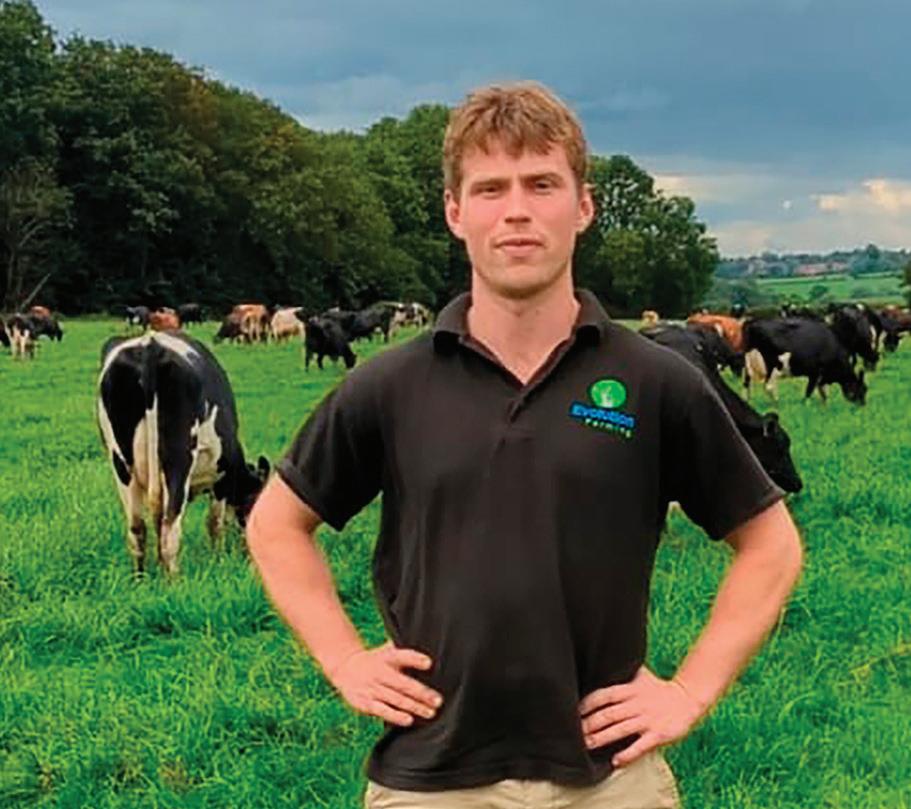
candidate for the cows and, even better, found me a job at Evolution Farming, where I have resided since. Since this time I have now leased cows to five different dairy businesses. There are a number of pros and cons.
On the pros it is a fantastic opportunity to secure your own dairy herd ready for a start-up if you make sound decisions and deal with good people, and is a great opportunity for a new entrant to dip their toe in operating a simple small business alongside another job.
It can also be a ‘win-win’ scenario for a farmer with limited capital needing more cows to bolster numbers.
On the side of the cons, one thing which is a constant in the dairy industry is milk price volatility. This can provide the leasee with several problems in a downturn and, in some extremes, leading to the farmer having to exit dairy, leaving the cows needing to be rehomed at short notice.
There is also TB and other health risks to consider, and for the safety of all of the parties involved and the cows, I would recommend that a proper lease agreement should be drawn up by a solicitor.
However, I would highly recommend this as an avenue to explore if you are in a situation like I was eight years ago. This has, after a great deal of hard work, stress and financial risk, allowed me to now own 300plus cows on lease, with a view to find my own opportunity in the near future if the correct one was to arise.
8
JANUARY 2024
Gemma Smale-Rowland
Fourth-generation farmer Gemma Smale-Rowland farms with her parents at North Petherwin, near Launceston, north Cornwall, where they milk 120 pedigree Holsteins under the Glebewin prefix. She established the Cornish Moo brand in 2018 and was one of the first farmers in the country to install an on-farm milk vending machine.
“ We also had a couple of weeks of increased calving numbers and five fresh cows was just what we needed on Christmas Day
As we sit back and reflect on 2023, once again the rollercoaster weather we experienced played a significant and challenging role across the farming sector.
And as I write this article on one of the first days of 2024, many of you will be suffering with extreme rainfall with many acres of land now underwater. These weather extremes look like something we will all have to expect to continue in the future.
Winter routine is in full swing. Cows are milking really well and milk quality is being maintained, as is cow body condition.
The Christmas period was challenging as we were hit with the dreaded flu bug, which has really knocked the team. It took all our effort just to get the work completed. We also had a couple of weeks of increased calving numbers and five fresh cows was just what we needed on Christmas Day.
TB testing took place at the end of September and we made a decision to sell as many of our beef stock as possible just to try and conserve the silage for cows and replacement heifers. This decision has been a godsend, even if we do still have three time as many stock as we need. This is probably a situation which will never change while I still farm alongside my parents.
Store lambs
With plenty of grass and warm weather in October, my husband, despite my protests, got slightly excited and it felt like there was a constant stream of lorries arriving with store lambs. This always fills me with joy, as dairy farming is the day job and sheep farming is an evening hobby.
However, at the start of December with the rain never stopping, it was not looking like such a great idea.
And now at the beginning of January, we are moving lambs every couple of days and constantly picking up and putting down electric fences. Even my husband is starting to look slightly tired of it all.
We had two loads booked to go for slaughter in early January. The first load went on January 2 and the other was meant to go two days later. However, the second load was cancelled, so we had the stress of finding grass to hold 200 fat lambs separate for another week.
I think I mentioned last year that our son had taken up a hobby of clay pigeon shooting and we have just completed his first 12 months of competing under Clay Pigeon

Shooting Association rules. He has had an incredible year, taking many junior championships, competing for England and coming second in an open competition.
He has another big year ahead and he is hoping to qualify to shoot for GB in the Czech Republic in June and has been talent spotted and now is on the Olympic pathway. Fingers crossed for the future.
Watching your children follow their dreams and achieve such great things is something very special.
I know it can be hard to pull yourself away from the daily grind of farming life, but if 2023 has shown me anything, it is that sometimes taking a break is the most important thing you can do. To this end, if everything goes to plan, we are hoping to try and get away for a short family break skiing in February.
I wish to thank you all for reading my articles over the last year. I thoroughly enjoy writing these pieces and get so much pleasure and joy from all your kind messages and comments, which reminds me how incredibly lucky I am to be a part of this wonderful industry.
I hope you all had a wonderful Christmas with far too much British Food and drink consumed. Let’s go and look forward to another exciting year in the British farming calendar, which I know you will all face with great strength and resilience.
However, it is not always easy and sometimes we need a little help and support. Through the tough times there are many wonderful organisations, such as Farming Community Network, We Are Farming Minds and many more who can offer help. Never be too proud to ask for help, as we are all in it together.
9 DAIRY TALK
JANUARY 2024
Amove by Pete and Richard Burbage to add a dairy unit to established contracting and beef suckler enterprises has raised more than a few eyebrows among customers and neighbours of Oak elds Farm, Northamptonshire. But the brothers say that pro tability has always been at the heart of what they do.
Richard says: “We had taken on another 40 hectares of land and needed it to make money. Dairying seemed like the logical next step, so we now have 120 milking cows alongside 300 breeding sucklers.”
Lely and Cowplan came up with the design for the new dairy unit a er plenty of debate between the two brothers.
Grazing
Richard says: “Grazing was an important element and we were keen that the slurry could go into our anaerobic digestion [AD] plant. But we also wanted the building to look good and present the right image.”
Automation was an early strand of the plans, says Richard.
“We had already invested in a robotic feeding system for the
Combining forage expertise with automation has proved the key for a new dairy unit in Northamptonshire. Jane Carley reports.
Forage foundation for dairy business
suckler herd as an alternative to buying a new feeder wagon and having the machinery and labour costs associated with it.”
Costs aside, Richard says they had already begun to appreciate other bene ts of robotic feeding with the beef herd.
He says: “It o ers improved stocking density, freshness of feed and control of the diet. Adding dairy cows would make be er use of the Lely Vector robots which otherwise stand idle from June to September when the beef ca le are all grazing.”
Cows are a mix of genetics including Friesian, Holstein, Norwegian Red and Montbeliarde, and forage is at the heart of all operations.
Grass and maize silage is made from the 400ha (988-acre) farm,
plus 75ha (185 acres) of cereals, which are part of the reseeding programme.
e plan is to graze the dairy ca le where possible, although Pete says they accept they will need to top up nutrients for milk production.
Passionate
He says: “We are passionate about grass – we used to think we knew how to make good silage, but having our own stock has really improved what we do and we think we can improve still further.”
Using Lely’s Grazeway automated gate system, soon to be installed, cows will be directed to set paddocks before and a er milking and there will be the ability


to run this system alongside feeding in the barn.
Richard says: “We will use a paddock system which can integrate with the robots, so paddock A and C could be grass and paddock B the grass-based diet fed by the robots. at is not something you could easily do with a feeder wagon.”
From October to March, the Vector robots, dubbed Ant and Dec, will feed both the beef and dairy ca le. Spring calvers and stores coming in at late summer to nish will also be fed by the robots. e Vector kitchen has been set up to easily feed the beef and dairy units and is located between the two.
Lely’s Andrew Wilson says the forage-based diets mean that adding the dairy unit could be achieved without changing the system.
He says: “To change the ration for di ering requirements, the feed is placed in a block in the kitchen and the data input into the Lely Horizon so ware.
Farm facts
rContracting business offers services for all aspects of forage production
rTwo robots have been specified, with a number of options included, such as the Lely Gravitor weighing floor, which monitors cow body weight at every milking
rCows are split into spring and autumn calving groups
rBusiness also includes 300 suckler cow herd using Salers genetics
JANUARY 2024 10
FARM
ON
Pete and Richard Burbage have developed a new 120-cow dairy unit in Northamptonshire alongside existing beef and contracting enterprises.


“ e Vector robots push the feed up and scan the heights of the feed at the feed fences every hour to ensure animals are fed the correct diet and amount of feed, based on intake.”
In a similar way, the feed height within the blocks in the feed kitchen is scanned to alert the operator when it runs out of a certain type of forage.
Richard says: “ is is particularly helpful in the ‘shoulder season’ when our focus is on the contracting business. We know the herd is being


Automation has been a key strand of the development; a pair of Lely Vector
fed consistently regardless of our workload, yet there is exibility.
“An example is where we have some round bales with spoilage. We adjust the parameters and they are not le to heat up, so there is much less waste. It is just so easy to make changes in small increments.”
Bene ts are already being seen in the herd.
Richard says: “Cows appear
very content, probably because they are not rushing to the feed fence when they see the wagon or being bullied away from the fence.
Feed spaces
“While the shed is being nished we have 72 feed spaces and 107 cows in-milk and there is never any competition for the feed fence.”
Milking through the two Lely









Faced with losing market share, Finance for Farms were able to help this farmer scale up his operations and fulfil demand by increasing dairy cows and milk output cost-effectively.
Scan the QR code to watch the video and learn more. Open
Discuss agricultural finance solutions for livestock, machinery, vehicles and more.
JANUARY 2024 11 Finance for business use customers only. All finance is subject to credit status, approval, terms and conditions. Finance for Farms is a trading name of Shire Leasing PLC who is authorised and regulated by the Financial Conduct Authority for certain types of consumer credit lending and credit related activities that are regulated under the Consumer Credit Act 1974 and by the Financial Services and Markets Act 2000.
www.financeforfarms.co.uk
01827 300 333 farmers@shireleasing.co.uk
phone
& scan
camera
Two Lely Astronaut A5 milking robots milk on ‘free cow traffic’ basis and the Burbages say that the data gathered by the robots is important to progress the herd’s performance.
feeding robots are shared with the beef unit.
ON FARM
Astronaut A5 milking robots started on March 17 with the construction process starting in October 2022.
Richard says: “We started calving on February 13 and had bought-in 10 cows. We had to get to 1,000 litres to get proper cooling in our 10,000-litre tank, so we fed milk to calves and put it into our AD plant initially.”
Robots are set up in a headto-head con guration using the free cow tra c concept, says Andrew.
Behind the robots there are two separation areas, one with cubicles and one with loose housing, so all cow needs can be met. A footbath will be positioned near the milking robots for easy footbathing.
Exploiting the data collected by the Astronaut milking robots o ers real value, Pete says.
“It is not just a ma er of having the data, but also being able to access it. We can easily look at how cows are performing when we are out in a eld away from home, waiting for a trailer, for example.”
Pete says the system has o ered the opportunity to upscale the business without taking on more labour.
Agritechnica
He says: “A defining moment was that we were both able to go to Agritechnica for the week along with our main herdsman, leaving my wife in charge. That sort of flexibility would not be possible with a parlour system.”

Slurry handling was another important consideration and a Lely Discovery 120 collector manure robot vacuums slurry from solid oors.
Manure is directed to short channels which feed into a 150cu.m storage tank, from where it will eventually be pumped straight into the farm’s AD plant, which produces electricity to power the dairy unit.
Pete says: “In addition to the calori c value of slurry, its water content is bene cial to the AD, reducing the quantity we have to supply.
“We will be able to control the dry ma er of material pumped to the AD or into our tower store and eventually it will reduce the amount
of maize we need as AD feedstock.”
Some 14 months into the build the nal touches are still being made – pipework for the slurry pumping system is being installed and calving boxes built.
A mezzanine area above the milking robots will be developed for meetings or to receive visitors, while a walkway over the cows will o er a bird’s-eye view.
e pair accept there are things they would have done di erently with hindsight.
Richard says: “While we have had great help from Cowplan and Lely, sometimes the advice we got on construction could have been be er. ere is lots of information






out there, but it is knowing who to go to and what questions to ask.” ere have also been some heart-stopping moments along the way, such as not being able to secure a milk contract and then lastminute delays before it was signed. e pair say they are ge ing on well with the Astronaut milking robots, although they have had to get used to the phone calls from the robots.
Richard says: “We get alerts for any issue and it is not always clear how serious it is. A sensor fault which shut down a robot the other day was simply a shred of silage that had got caught. It has prompted us to focus more on routine maintenance.”
With a target 9,000-litre average milk yield, Richard says the cows have performed really well.
“We are above where we wanted to be. Cows have se led in perfectly and some have surpassed our expectations.
“You have to bear in mind that they have done this against the background of us continuing to build around them.”
And Richard says the development of dairy unit has bene ted the beef side of the business too.
“Our sucklers handle well and are calm and quiet, but by considering the animal and its welfare in our development of the dairy unit, we have become be er beef farmers too.”
12
JANUARY 2024
Forage is at the centre of the business, including 3,500 hectares (8,649 acres) of contract work.
Richard and Pete Burbage.



Having the best genetics is great but knowing they’re BVDFree makes them GREATER © Neogen Corporation, 2023. Neogen and Igenity are registered trademarks of Neogen Corporation. All rights reserved. Igenity ® Genomic Technology, powered by Neogen® Follow us on: @ Neogen EMEA - Animal Safety & Genomics @ Neogen iEMEA For more information email us at neogengenomics@neogen.com or call us on + 44 (0) 1292 525 600 Igenity® Extra: Test for Genomics & BVD Together *Our lab is accredited for BVD eradication schemes in England and Scotland Extra Come and visit our team of experts at Dairy Tech Wednesday 7th February Stand Location: T64 Scan here for more
DAIRYMatters
‘New year, new gamekeeper in chief, new era for fairer milk
supply chain power balance?’
This month, former cowman and agrimarketing contractor Phil Christopher gives his thoughts on what the new chief executive at AHDB should be doing to support dairy farmers.
If something is going to keep pencils sharp when your future milk prices are set, it could be one of the dairy trade’s big beasts jumping ship to become your gamekeeper in chief at A(H)DB.
Before I go on, please be in no doubt where I am coming from here. Firstly, milk buyers will rarely, if ever, pay you more than the bare minimum they can get away with; and secondly, I want A(H)DB to thrive, but only by doing things which genuinely support you, its paying customers.
This Dairy Matters follows a recent Farming Matters page in Farmers Guardian, from which I am not going to repeat, apart from relevant stepping stones.
One such aspect is the knowledge transfer programme, for which 100% of levy payers share the cost, yet many fewer seem interested in making use of the gains.
It is not for the likes of me to speculate why this might be. But surely a much fairer way for all levy payers would be to drop all A(H)DB funding for events, activities, etc., to promote farm productivity improvement.
Since the Milk Marketing Board’s (MMB) Low Cost Production services in the 1970s, readers choosing to use and pay for independent advisory support has led to an impressive choice developing here.
 Phil Christopher
Phil Christopher
So how about A(H)DB making its intellectual property, which all you dairy farmers have paid for, available to all advisory services in return for decent value for money (or indeed money for value) fees?
With this in hand, advisers can charge only those farmers who opt to take advantage of this reliable research-based knowledge? Clearly, this should incentivise advisers to promote maximum uptake in order to maximise the number of farms on which productivity improvement is taking place and thereby their fees for the essential role they can play.
Matters of principle
For me, this and what follow are matters of principle. Dairy levy payers should not be expected to pay for service elements they choose not to use.
The next item will not be a surprise to regular readers, but the new factor in play is your incoming gamekeeper in chief. I believe Graham Wilkinson has the opportunity to help you change dairy farming for the better for decades to come. As a matter of courtesy, I have sent him an advance copy of this and suggested he contacts the editor if he wants to respond publicly.
But even if he agrees with the hypothesis that follows, he and A(H)DB colleagues cannot do it all for you.
Dairy Farmer readers will have to get involved in decent numbers; to be prepared for your loyalty to be tested; and to be sufficiently open-minded to regard some dairy farmers as rivals rather than allies.
As I write this mid-December, an FG front page headline shouts ‘TURNING POINT’. The subtitle ‘Production falls support markets’ signals a hopeful sign that ‘the end of 2023 could mark a turning point’, after a period of serious milk price pain.
Ultra reliable pundit Chris Walkland is quoted that milk production has ‘fallen off a cliff’ and the FG article gives credit to your new gamekeeper in chief’s former employer Arla, along with Barber’s and Saputo, for leading the way with some as yet modest milk price rises. One way of describing this scenario is unplanned,
14 JANUARY 2024

If a decent percentage of the top 50% of producers by volume were to lead the way, a small number of strong producer organisations could be formed, says Phil Christopher.

“ Please never say never, and remember that you read it here first. Over to you
uncoordinated and unreliable supply management in action. It must be deeply painful at your end of things.
Instead, what if your A(H)DB was to establish a business school to teach groups of like-minded dairy farmers how to legally plan and co-ordinate production at levels which would keep ex-farm milk supply in line with demand?
Framework
If this o ered assured supply volumes to milk processors in return for ‘psustainable’ milk prices for you in a legally created framework, we might just see the emergence of a supply chain genuinely working together, based on a fair balance of power.
Please note the choice of words here: it is long overdue that you regard A(H)DB as your organisation, rather than the imposition of a wicked step-parent; and the silent ‘p’ in psustainable stands for your ‘pro t’. is is not a Trojan Horse for re-inventing the MMBs.



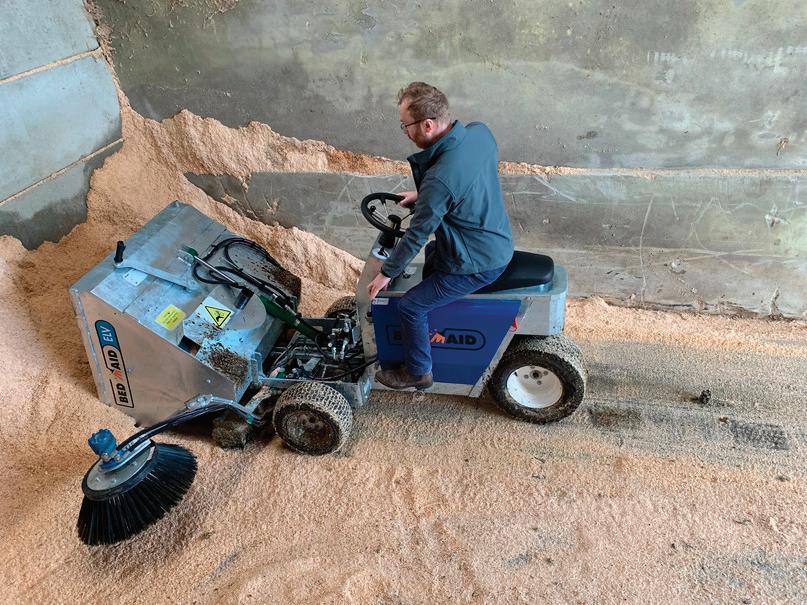

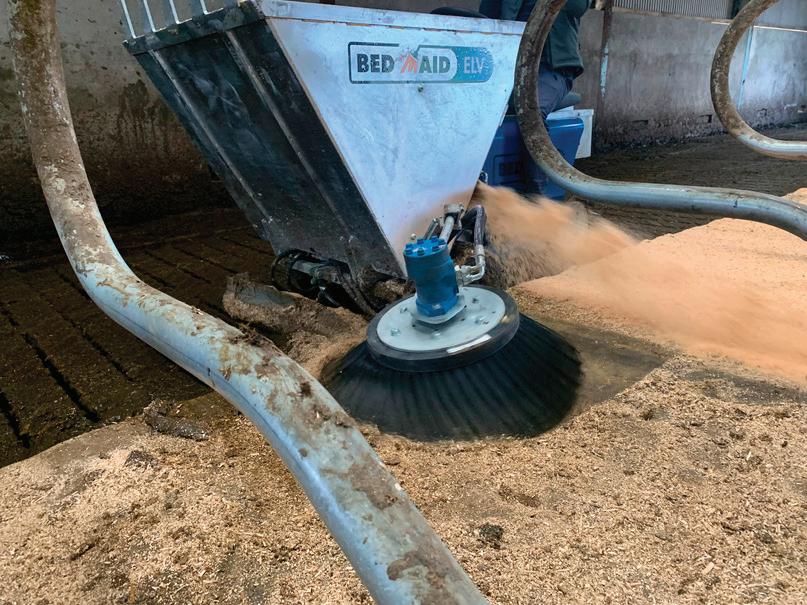





I suggest it would not require anything like 100% of dairy farms taking part, so the awkward sods can stay clear and throw mud from the sidelines.
As long as a decent percentage of the top 50% of producers by volume were to lead the way, my hypothesis is that a small number of strong producer organisations, independent from each other, could bring some welcome stability at milk prices you and your milk buyer could agree to live with.
But it needs a catalyst and that, Mr Wilkinson, is a challenge I suggest you are uniquely quali ed to lead if you really are to turn the ailing A(H)DB ship around.
I have kept bracketing the le er (H), of course, to signify the regre able (and careless?) loss of horticulture and potatoes from A(H)DB’s portfolio.
Maybe a successful producer organisation development unit for milk might lead to others, including perhaps spuds, fruit and vegetables. Please never say never, and remember that you read it here rst. Over to you Mr W.


Mr W 15 JANUARY 2024 NOW AVAILABLE FOR ON FARM DEMO As seen on Save time & bedding - bed 250 cubicles in less than 20mins Minimal noise, pollution and running costs Low maintenance - no filters Fully hot-dip galvanised - ensures no damage to the hopper when collecting bedding Easy loading - loading is simplified to the pull of a lever Fast energy efficient charging - standard 13amp socket FULLY ELECTRIC See you at stand 170 Call Wilson Agri on 028 7086 8430 to book your demo now!
The ‘TURNING POINT’ cover headline from Farmers Guardian, December 8, 2023.
The impact of lameness is well known, but vet Will Gratwick says that to get a grip on the issue, there needs to be dialogue between farmer, foot trimmer and vet. Dairy Farmer reports.
Collaboration on cows’ foot health pays off
Eective teamwork between farmer, qualied foot trimmer and the farm vet has been crucial in reducing lameness within the 450-cow autumn calving herd run by Duncan Blood at Hankins Heys Farm, Crewe, Cheshire.
Farm vet Will Gratwick, from LLM Farm Vets in Whitchurch, part of the VetPartners Group, says: “Lameness in dairy cows can be a signi cant welfare concern and has been shown to lead to decreased milk production, reduced fertility, and increased culling rates, so it is important
to prevent it where possible. It is almost always due to problems in the foot, most commonly sole bruising/ulcers, white line disease, and digital dermatitis.”
He explains that a professional foot trimmer will bring in-depth experience of di erent herds and cases, as well as specialised skills and equipment to prevent hoof problems and, when they do arise, to treat them before they become severe.
Foot trimming at Hankins Heys Farm is carried out by Ma Ward of Happy Hooves, based in Derbyshire.
Mr Ward encourages farmers
to work with their vet practice to carry out routine mobility scoring.
He says: “Early detection is crucial because it enables timely intervention, to help prevent the worsening of the condition, reduce discomfort, and minimise the impact on production.”
At Hankin Heys Farm, this early detection is carried out monthly by vet tech Holly Dodd.
Mr Blood says: “As well as helping us to detect lame cows for treatment, mobility scoring allows us to monitor trends in lameness with our vet and see how well our preventive strategies are working.”
Preventive care is key to


managing the cost of lameness to a farming business according to Mr Gratwick.
He says: “It was estimated in 2009 that the average lameness case was costing dairy farmers £330, and this will have increased signi cantly in the past 15 years.
“In addition to reduced milk production, lameness a ects fertility as lame cows are less likely to show bulling behaviour.
Costs
“Culling rates will also be increased, further adding to the nancial burden. e costs of treating foot problems, including labour, vet care and medication, may be the most obvious expenses to the farmer.
“However, they typically account for only 13% of the overall lameness cost.”
Dairy farmers who prioritise regular foot trimming with a qualied professional for the whole herd, are therefore investing in the success of their farming operation.
Mr Gatwick says: “Mobile cows with healthy feet put more milk in the tank and there are a signi cant opportunities for a return on
The cost of employing a good foot trimmer is outweighed by the financial benefits WILL GRATWICK
JANUARY 2024 16 VET’S VIEW
Preventative care is key to managing the cost of lameness to a farming business, says vet Will Gratwick.

investment in lameness prevention. e cost of employing a good foot trimmer is far outweighed by the nancial bene ts.”
Mr Gratwick says the target should be to treat cows within 48 hours of detecting lameness.
He adds it is essential that the right skills and equipment are
available on farm to treat lame cows in between visits from a professional trimmer.
At Hankin Heys, Mr Blood has invested in a good quality hydraulic crush and farm sta have received training in the latest treatment approaches for lame cows.
Mr Gratwick says: “Non-
New foot trimming courses
JLantra is a leading awarding body for land-based industries in UK. They have recently accredited two new courses that have been produced by a collaboration between the British Cattle Veterinary Association and the Cattle Hoof Care Standards Board.
They are aimed at being
steroidal anti-in ammatory drugs (NSAIDs) are an important component in the treatment plan. Giving an NSAID, alongside a hoof block and corrective trimming has been shown to double the recovery rate from sole ulcers, bruising and white line disease, as long as they are detected and treated early.”
He says collaboration between dairy farmers, trimmers and vets is key to success.
“Farmers know their herd and
highly practical, and include a one day ‘First Aid for Feet’ course, and a three-day ‘Intermediate Foot Trimming’ course.
The courses are delivered by vet practices alongside a professional trimmer.
More details can be found on the CHCSB website.
can observe daily changes, providing rapid treatment when lameness does occur.
“Foot trimmers can contribute with specialised expertise, ensuring a high standard of care at routine preventative trimming, keeping cows healthy and comfortable throughout their lactation.
“ e role of the vet is to optimise the approach to the treatment and prevention of lameness while monitoring the mobility of the herd,” he says.
Available



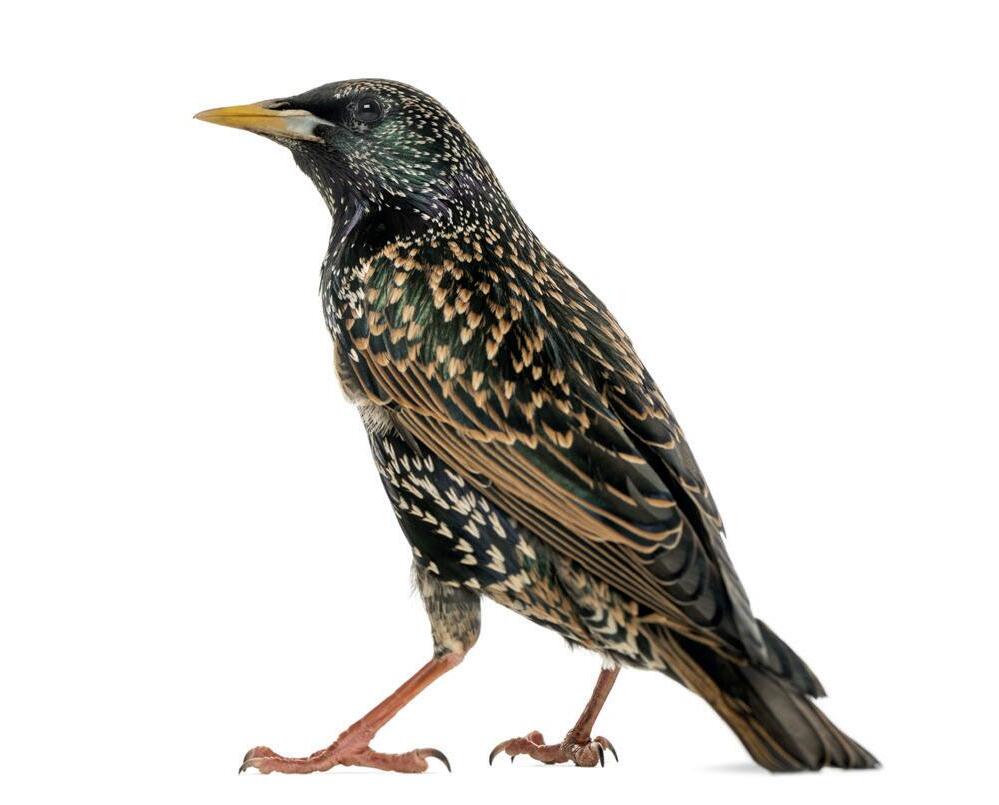




JANUARY 2024 17 VET’S VIEW Starling Control Reducing starling nuisance with a nutritional approach Protecting Ration Energy Preserving starch constituent for increased feed efficacy Disease Prevention Helps prevent the spread of avian-borne diseases Are starlings costing you money? Dairy Beef Anti-starling salt for maize and wholecrop feeding B2B Technical Dept: 01363 775 115 techteam@brinicombe.co.uk B2B Nutrition is the trade arm of the Denis Brinicombe Group
agricultural merchant
from your local
Will Gratwick says lameness should be treated within 48 hours.
September is a busy time at Highbury Holsteins, near Dromore, Co Tyrone, with 90 out of the 130-cow herd calving during this month and all the replacement heifer calves born within three weeks. is means that building design and calf rearing protocol has to be spot on.
Speaking at a recent CalfChat webinar, the calf rearing setup was explained in more detail by Dr Amanda Dunn, of Bonanza Calf Nutrition, who is married to Kyle Smyth, who runs the unit alongside his father Hugh and brother Adam.
Dr Dunn explained that sexed semen is used for heifer replacements on the herd, which yields an average of 11,200kg on twice-daily milking.
Beef cross calves are sold at three to four weeks old and the calves are housed together and reared on a strict protocol which kicks into action with the rst birth of the season.
Six years on from the installation of a new calf shed, the Smyth family is consistently managing to maintain mortality at below 2%. Wendy Short reports.
A clear focus on winter calf health
Dr Dunn said: “ ere are eight indoor calving pens for cows which are approaching calving and the accommodation is monitored by camera 24 hours a day.
Open-fronted housing
“ e dam and calf remain together for about 20 minutes, a er which the cow is milked in the pen using a portable milking system and the calf is moved into the open-fronted housing.
“ e purpose-built calf house is split into six bays, with a concrete block wall to a height of two metres



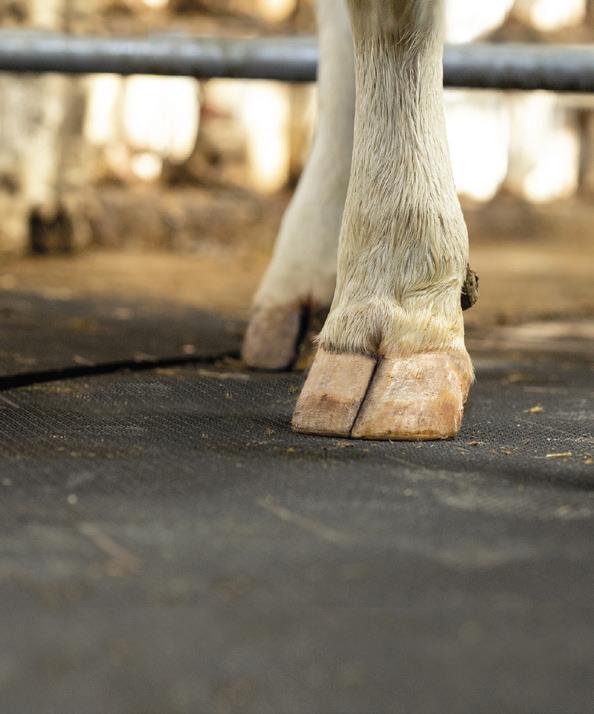
and topped by double-cladded Yorkshire boarding, which reduces draughts without limiting air ow.
“Full machinery access was another design feature, as this makes it more likely that it will be cleaned on a frequent basis.
“ e previous calf shed design made cleaning access di cult and ca le of varying ages were being kept under the same roof. Calf pneumonia cases are a very rare occurrence on-farm since the building of the new accommodation.”
Each bay is divided into two pens by gates which have stock board barriers added to reduce draughts, also preventing physical contact between neighbouring groups, which in turn minimises the risk of disease transfer, said Dr Dunn.
e building also has a human foot dip at the entrance, with the contents renewed regularly.
A one-in-20 slope has been built into the oor to provide adequate drainage and the calves are bedded on su cient straw to allow for nesting in low temperatures. Fresh straw is added daily to act as a barrier to any pathogens in the base layer.
Dr Dunn said correct building design and management is only one element of minimising calf mortality rates.
She said: “I cannot overemphasise the importance of colostrum. Every calf receives four litres of colostrum within one hour of birth. Ideally, it is taken direct from the dam, but otherwise there is a bank of frozen colostrum stored at in plastic bags.
Vaccination
“ e replacement heifer calves are further protected against disease through the vaccination of their dams against rotavirus and coronavirus, which is carried out eight weeks pre-calving.
“E orts are always made to persuade calves to take milk from a bo le as a priority. e sooner they get used to drinking from a teat, the be er.
“Any intake shortfall during the bo le-drinking process is topped up by stomach-tubing. At the next milking of its dam, the calf will be o ered two or three litres of her colostrum via a teated bucket.”






JANUARY 2024 18 YOUNGSTOCK
IN GERMANY
MADE
The new calf shed was installed six years ago.

Consistency is key with calf feeding, said Dr Amanda Dunn.

Calves are given a 12- to 14-day transition period from colostrum to transition milk to formula, to promote healthy gut development which helps to minimise the incidence of scours.
ey remain in individual pens which are set up within their group pen until they are drinking e ectively, a er which they are released into groups of six.
A er grouping, calves are fed from compartmentalised teat feeders which hang over the pen gate. ey are positioned at a height which will allow for the full opening of the oesophageal groove during drinking.
Dr Dunn said: “Consistency is key with calf feeding. e water mixer tap for the milk powder is set at 40degC to ensure the correct temperature. e milk goes into a 160-litre milk cart with a pump feature and the calves are fed to a rigid routine of 8am and 6pm, seven days a week.
Milk replacer
“Once calves are transitioned on to milk replacer at 14 days old, they receive four litres in the morning and four in the evening for the rst ve weeks. On day 35, they switch to once-a-day feeding and are very

gradually weaned over the following ve weeks to reach the 70-day weaning date.
“ e feeding equipment is thoroughly washed a er every session and the person feeding wears clean clothes and gloves
and feeds the youngest calves rst. A er washing, the equipment is stored on a rack to dry.”
All of the calves wear jackets from birth to about six weeks and these are washed between use at 60degC to kill o bugs such as cryptosporidia, said Dr Dunn.
Heat lamps are used in extreme cold conditions, but the feeding is not adjusted according to the weather, due to the aim of achieving feeding consistency.
Dr Dunn stressed the requirement for fresh dry feed and clean water for young calves.
She said: “Calves are encouraged to try solid food from the rst week of life to promote healthy rumen development.
“At eight weeks they have access to an ad-lib feeder at a ratio of 12 calves per feeder.
“A maximum of one change is introduced to the calves per week, as this goes a long way towards minimising stress and helping to prevent disease challenge.”

JANUARY 2024 19
YOUNGSTOCK
Kyle Smith
Issues facing farmers in Germany will be all too familiar to British dairy farmers, including low milk prices and increasing regulation. Chris McCullough reports.
Young farmer Rainer Boger is in the process of taking over the running of his family’s farm from his father, Reinhold, and is investing in just enough technology to make this a less labour-intensive unit.
e farm comprises 300 hectares (740 acres) near the town of Ruthen in the district of Soest, in Germany’s North Rhine-Westphalia region.
e farm’s 250 cows – 80% of which are Holstein, and the remainder Ayrshire – are housed all year round and milked using six Lely A4 robotic milking units, the rst of which was installed ten years ago.
Rainer explains that, over the last 12 years, the herd has expanded rapidly from its original 40 cows.
Growing most of the cereals they need to feed the cows, replacements and bull beef calves saves the Bogers a lot of money on concentrates and increases the farm’s sustainability.
“We grow cereals on around 150 hectares – mostly triticale, wheat and barley,” says Rainer.
“Other ingredients are purchased to include in the total mixed ration for the cows.
“Normally we take up to ve cuts of silage and one cut of
Building a less labour-intensive farming future
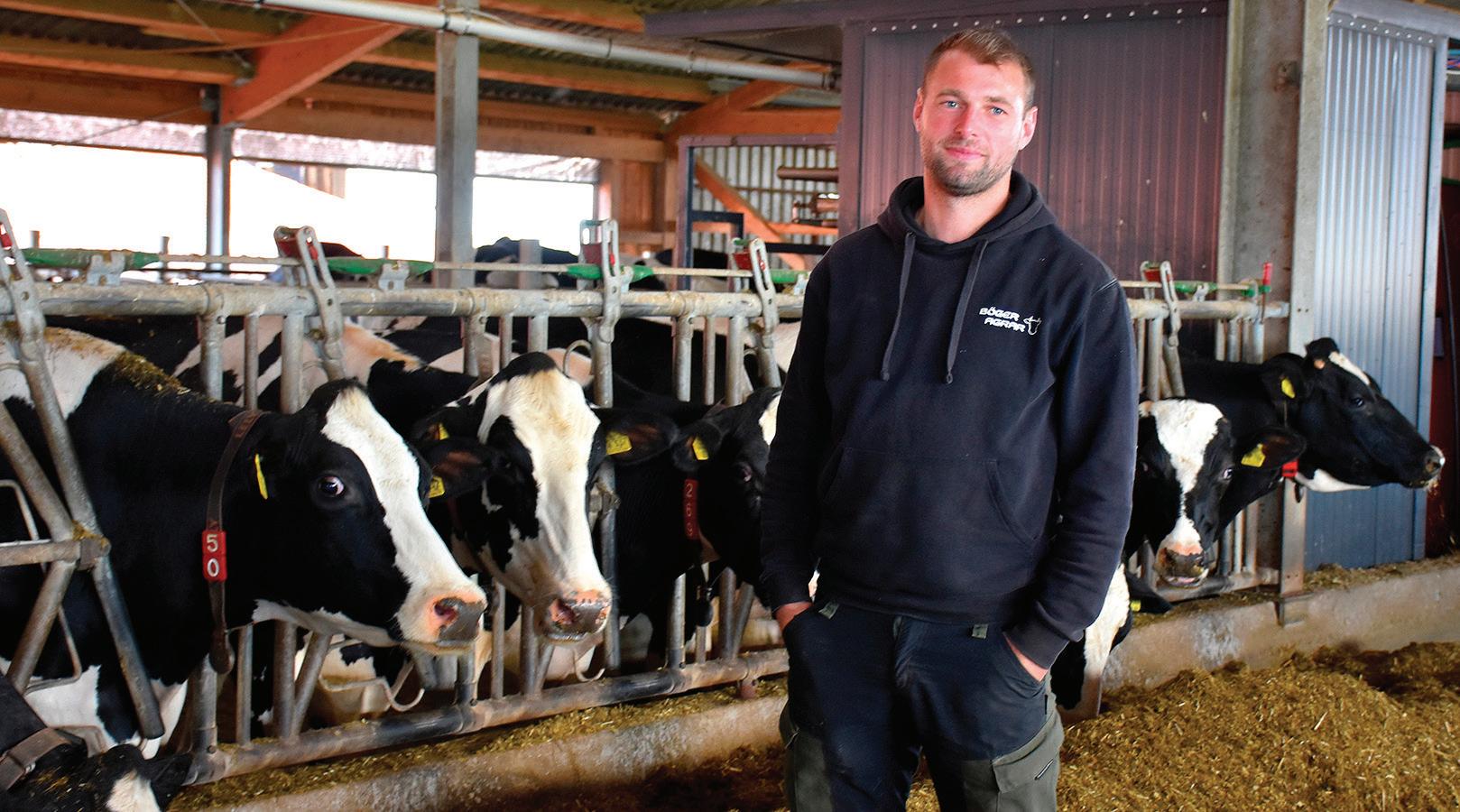

maize on the other 150ha to further boost the homegrown feed supplies for the cows. is also allows us to utilise our own manure from the cows, and we also run two
biogas plants selling energy to the grid.”
Rainer’s cows average three visits per day to the robotic milking units, and produce an average of 34 litres per day in

the summer time and up to 37 litres/day in the winter time.
Milk is sold to the Frischli processor for 38 euro cents per litre (33ppl).
Rainer says: “We need around 40 euro cents per litre to break even. is time last year, we received 60 euro cents per litre. Prices were quite good at 54 euro cents up until a couple of months ago, but now there is li le money to be made as a pro t, if any.”
Feed
Cows are fed once per day with a TMR consisting of 23kg corn, 25kg grass, 0.5kg straw, 8kg cereals and 600g of a mineral. Each cow eats 55kg TMR fresh weight per day and concentrates in the robotic milker.
JANUARY 2024 20 WORLD DAIRYING GERMANY
Rainer Boger
Rainer Boger uses two biogas plants to recycle the cattle waste and create energy.
GERMANY WORLD DAIRYING

Rainer says: “Every cow gets 1kg of concentrates, and the best-producing cows will receive a top up to a 3kg total per day.”
Rainer runs all the bull calves born on-farm as bull beef to about 19 to 20 months old, when they are ready for slaughter.
Rainer says: “ e aim is to add value to the bull calf while at the same time producing a top quality beef animal that consumers want.
“ e bulls are killed at about 20 months old and normally achieve a 55% kill out percentage. is results in a deadweight in the range of 360kg to 420kg, which we are happy with.
“Prices for the bull beef are normally pre y good and currently sit at 4.30 euros per kg carcase weight.
“ e bulls are kept in one side of our newest barn on the farm, which measures 34 metres by
Farm facts
rThe farm employs three members of staff who are mainly involved with looking after the livestock.
r The top 80% of the herd are bred to sexed semen and the remainder run with stock bulls.
r Average annual yields sits at 11,500 litres per cow, at 3.4% protein and 4.0% butterfat base levels
Extra technology is used to push up the feed for the cows.


To assess the health and fertility of high yielding dairy cows and accurately and reliably spot heats in cows and heifers, the SenseHub herd monitoring system uses a choice of neck collars or eartags.
B108m. is barn also houses dry cows and younger milking cows.”
ere are normally about 150 bulls on-farm at any one time. ey start o in pens at one end of the barn, and as they grow they move up the row to bigger pens until they reach the ideal weights.
Challenges
Rainer says the biggest challenges he faces milking cows in the region is regulation coming from both the German Government and the EU, and in particular highlights the nitrates issues.
In Rainer’s region of Germany, the slurry spreading ban runs from September 30 to February 1. erefore, a lot of storage is required for the slurry and manure produced by livestock during the winter months.
On Rainer’s farm there are two biogas plants: the rst being a 75kW/hour unit installed in 2017, and the second an 80kW per hour plant installed in 2019, built in partnership with a neighbouring pig farmer.
“E ectively, these biogas plants act as our storage tanks that are constantly being emptied and lled as they produce energy,” says Rainer.
“We produce electricity for the network and receive up to 23.4 euro cents per kW/hour from the plants. We also run PV panels on the barn to produce more electricity for the grid.”
oth the neck collars and eartags use advanced electronics to constantly monitor the subtle activity, behavioural and rumenation patterns associated with the various stages of the oestrus cycle and rumen function.
The SenseHub neck collar is fully weatherproof with an IP68 rating and has a battery life of up to seven years.
Likewise, the SenseHub eartag is also IP68 rated and has a battery life of up to five years.
The latter is ideal for use in growing animals and features a programmable flashing LED light which makes it quicker and easier to find which animals SenseHub has highlighted as needing attention for heat, health or routine examination purposes.
SenseHub collars and tags collect live data around the clock, with information automatically uploaded to the farm’s SenseHub antenna every 20 minutes.
This data is then analysed by the

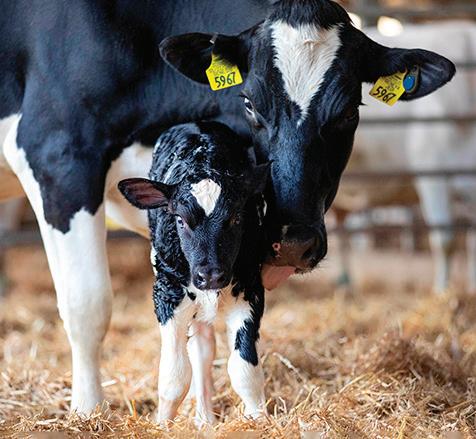
SenseHub app to provide an up-to-date picture of each tagged animal’s current health and fertility status.
The 500m range of the standard SenseHub antenna can be extended with additional booster antennae. Remote coverage also available via an optional solar powered antenna, which maintains connectivity via a 4G mobile data connection to monitor cows and heifers grazing away from the farm.
In addition to offering class-leading levels of heat detection accuracy and the ability to measure the subtlest of health and rumination indicators, the SenseHub collars and tags are also compatible with a wide range of third-party herd management software programs and can be used as ID tags in compatible parlour management systems, including MSD Animal Health’s own range of parlour equipment and automated sorting gates.
JANUARY 2024 21
To find out how more about how SenseHub’s intelligent collars and ear tags could help your herd please call the SenseHub team on 01207 529 000. Alternatively, to send us an email, please contact us at allflexuk@msd.com For more information, visit www.msd-animalhealth-hub.co.uk/farmers/livestock-monitoring
INTELLIGENT MONITORING WITH COLLARS OR TAGS SPONSORED CONTENT
SenseHub is not intended to diagnose, treat, cure or prevent any disease in animals. For the diagnosis, treatment, cure or prevention of disease in animals, you should consult your veterinarian. The accuracy of the data collected and presented through this product is not intended to match that of medical devices or scientific measurement devices.
BREEDING BULL PROOFS
Anew entrant in the shape of Peak AltaOrvar has hit the number one position on the genomic Holstein sires list, published in December by AHDB.
Ranked on Profitable Lifetime Index (£PLI), this young bull – sired by AltaZeolite and out of an AltaPlinko dam – is predicted to excel for daughter fertility, with a Fertility Index (FI) among the breed leaders at 12.8.
The bull also has high Predicted Transmitting Abilities (PTAs) for protein at 37.2kg and +0.12%, all contributing to a PLI of £925.
In taking the lead, AltaOrvar edges the former frontrunner, Denovo 2776 Leeds, into second position, now with a PLI of £901. Leeds’ PTAs of 1,308kg milk and 91.3kg fat plus protein combined, indicates daughters will have exceptional production.
Moving up into third position is Peak AltaMorpheus (PLI £897), also the highest lifespan transmitter in the top 10. Daughters of this bull are expected to live 168 days longer than average.
Another former leader, Wilra SSI Faneca Ebersol, retains a top five position, now ranking fourth, with a PLI of £889.
Ebersol transmits outstanding udder health (-3 Mastitis, -28 SCC), alongside other fitness attributes, making him the highest ranking of the top 10 bulls for the HealthyCow index (£270).
New entrant in genomic sires top list
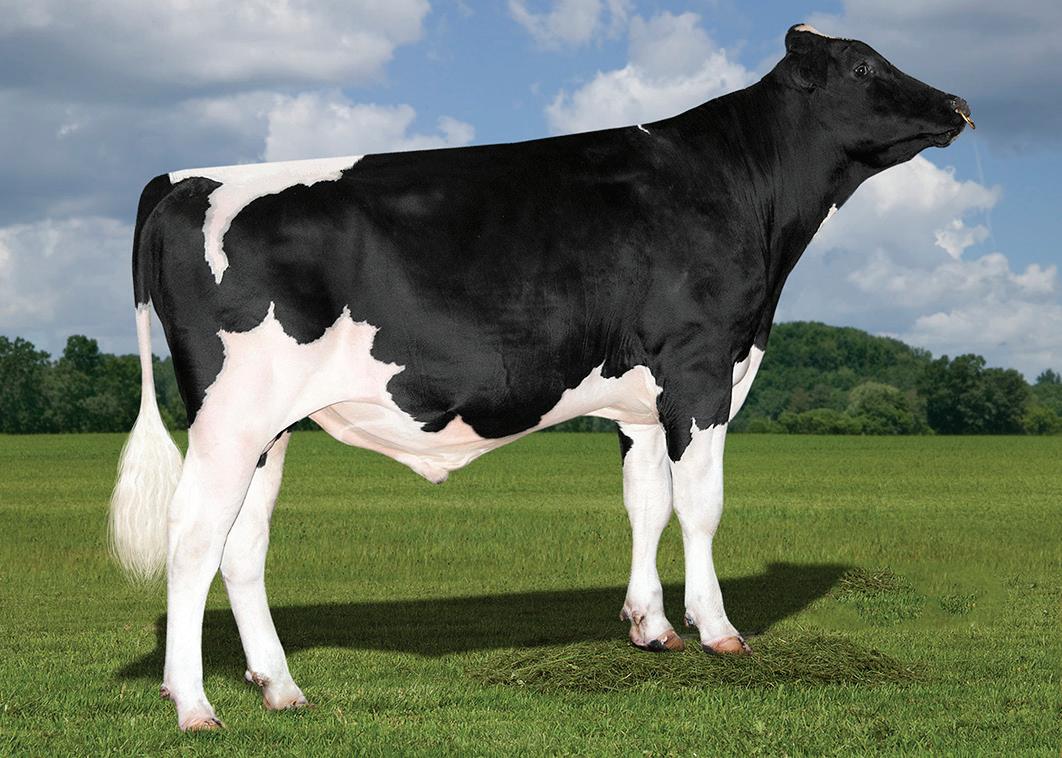
Progenesis AltaVandyke is a new entry in fifth position (PLI £887), transmitting exceptional weights of fat at 55.6kg, combined with 38.4kg protein.
Marco Winters, head of animal genetics for AHDB, says: “We know that using £PLI as your primary selection index is the best way to increase profitability on
Top 10 Holstein bulls with genomic indexes ranked on £PLI
a commercial dairy unit and the top 100 list shows the remarkable way in which many young sires can help achieve this.
“Most of these bulls transmit impressive production, but increasingly, they excel for health, fertility and lifespan, with the average daughter of the best bulls predicted to live
Most of these bulls transmit impressive production, but increasingly, they excel for health, fertility and lifespan
MARCO WINTERS
more than six months longer than those of an average bull.
“All of this contributes to continued improvements in their environmental credentials, seen as their EnviroCow indexes continue to climb, emphasising the role genetics can play in addressing the needs of the industry to cut carbon footprint.”
JANUARY 2024 22
£PLI Bull name Milk Fat Ptn SCC LS FI £HC Feed Env TM Supplier kg kg kg Adv Cow GB/NI 1 925 Peak AltaOrvar 804 44.8 37.2 -17 128 12.8 231 181 4.5 0.65 ALT 2 901 Denovo 2776 Leeds 1308 50.9 40.4 -19 146 5.1 205 208 4.7 0.65 GEN 3 897 Peak AltaMorpheus 695 46.5 30.5 -23 168 10.6 267 161 4.4 -0.18 ALT 4 889 Wilra SSI Faneca Ebersol 668 48.1 27.9 -28 119 10.1 270 198 4.1 0.7 WWS 5 887 Progenesis AltaVandyke 937 55.6 38.4 -26 110 2.3 171 129 4.4 0.69 ALT 6 886 DG Peace 1102 46 41.1 -15 95 4.4 158 260 4.6 0.59 CBL 7 885 Denovo 19495 Hargrove-P 758 50.7 38.4 2 82 4.1 103 276 4.9 0.42 GEN 8 880 Progenesis Pineapple 831 49.7 41.6 -16 98 1.5 141 112 4.3 1.38 SMX 9 877 Peak AltaKalon 595 40 32.8 -21 137 11.3 255 171 4.2 0.66 ALT 10 873 Peak AltaCalabria 819 51.4 40.6 -15 67 4.5 146 106 4.1 0.83 ALT/AIS Source: AHDB Dairy.
Servives; ALT = Alta; CBL = Cogent Breeding; GEN = Genus ABS; WWS = World Wide Sires UK; SMX =Semex; £PLI = Profitable Lifetime Index; SCC
Somatic Cell Count; CS = Calf Survival; LS = Lifespan; FI = Fertility Index; £HC = HealthyCow; Feed Adv = Feed Advantage; Env Cow = EnviroCow; TM = Type
Notes: AIS = AI
=
Merit.
For other dairy breed indexes, visit ahdb.org.uk/knowledge-library/dairy-breeding-and-genetics
Peak AltaOrvar is the new number one on the genomic Holstein sires list, published by AHDB this week.
Genosource Captain leads as UK daughters added to his tally
JGenosource Captain has been a long-term leader within the Holstein breed, both as a young, genomic sire and now that he has daughters of his own.
With 180 milking in the UK adding to his international figures, he weighs in at the top of the pack in December’s proven sire list.
With a PLI of £814, Captain is established as a leading production bull, with 1,219kg Predicted Transmitting Ability (PTA) for milk.
The sire also has good ratings for Calf Survival (2.4) and is the leading bull in these rankings for FeedAdvantage, meaning producers can except efficiency of feed conversion from daughters.
Second place is taken by FB Kenobi Targaryen (PLI £808), which graduates from the young genomic sire listings, with 134 UK milking daughters contributing to its figures.
High protein PTA of 39.6kg confirms this bull’s genomic prediction and it is a big somatic cell count (SCC) improver at SCC -25.
Udder health
Even more impressive for udder health is Westcoast River, which has a SCC Index of -30 and Mastitis at -3. With more than 100 new UK milking daughters bolstering this bull’s figures, it rises to third position and has a Lifespan Index of +134 days, outstanding Fertility Index (16.1) and earns a HealthyCow of £337.
Mr Winters says: “Most producers now use high £PLI genomic sires for breeding dairy replacements, but these proven


sires affirm the good sense of that choice. Although it is usually around fours year later that young, genomic sires graduate to the proven ranking, they are doing so with continuity across their daughter performance figures.
“And while many producers may not choose to return to them
once they are daughter-proven, these older bulls, which have stood the test of time, should give producers confidence in their use of genomic predictions on which to base their breeding choices.”
Continues over the page...




JANUARY 2024 23
Brought to you by Farmers Guardian, FGBuyandSell is the platform for you to sell your items to a responsive farming community. From dairy cattle, milking parlours, calving equipment and everything in between, you’re sure to find what you need on FGBuyandSell.com. Start listing your items FREE today! Browse. Sell. Buy at FGBuyandSell.com
BULL PROOFS BREEDING
Gensource Captain has 180 daughters milking in the UK.
BREEDING BULL PROOFS
Top 10 daughter-proven Holstein bulls ranked on £PLI
New genetic choices for spring grazing herds
JNew at the top of the latest Spring Calving Index (£SCI) is the high health and fertility Jersey sire, VJ Groenbjerg Lobo Lobster, which has 94 UK daughters contributing to excellent milk solids figures and earns an SCI of £583. The bull also has the highest daughter lifespan of the top 20 sires and high daughter fertility.
Equally impressive on daughter fertility is the Holstein sire, Progenesis Wimbledon (SCI £582), which ranks second.
A higher kg milk transmitter than the number one placed Jersey, this bull also rates well for udder health.
is on a par with Wimbledon for daughter fertility.
Retaining the number one spot in the Autumn Calving Index (£ACI) is Progenesis Wimledon (ACI £678). This bull has the highest combination of fat and protein percentages of the top 20 and leads for Lameness Advantage across this group.
few places to reach second position (ACI £677) and stands out for good udder health traits and daughter fertility.
Third
JDutch-bred Bloemplaat Hoeve Ewoud continues to move up the Friesian rankings to take the lead in this breed’s evaluations.
This son of Bernard transmits high milk solids, with Predicted Transmitting Abilities (PTAs) of 13.7kg fat and
Holstein sire, Denovo Invictus, stands third and 13.1kg protein, alongside cell count reduction (SCC -11), all of which helps earn a Profitable Lifetime Index (£PLI) of £303.
Fertility Index
Black and white breeders are reminded that Ewoud’s daughter Fertility Index of 3.7 represents better fertility

Westcoast River climbs a than that of a Holstein with the same score, because FI – as with all breed-specific evaluations – is calculated only within each breed, and in this case the Friesian genetic base (or average) is higher for this particular trait.
A new entry in third is FB Kenobi Targaryen (ACI £664), which becomes the highest protein transmitter of the group.
High milk solids rise to the top among non-Holstein breeds
A new leader has risen to the top of the Jersey rankings in the shape of Danish-bred, VJ Hoeholt Jern James, with a PLI of £442. This good udder health improver (-20 SCC, -1 Mastitis) also scores well for daughter fertility at 7.5.
VR Vilano is the new number one in the Ayrshire ranking, offering a favourable Lifespan of +82 days, high daughter Fertility Index (+9) and good all-round production. He now weighs in with a PLI of £442, edging the former number one sire, VR Venom, into second place.
JANUARY 2024 24
£PLI Bull name Milk Fat Ptn SCC LS FI £HC Feed Env TM Supplier kg kg kg Adv Cow GB/NI 1 814 Genosource Captain 1219 45.9 36.6 2 122 5 174 245 4.4 1.5 CBL 2 808 FB Kenobi Targaryen 940 38.2 39.6 -25 98 4.8 155 109 3.8 0.35 GEN 3 789 Westcoast River 797 32 28.6 -30 134 16.1 337 51 3.1 1.41 SMX 4 762 Bomaz Kettle 741 50.8 37.5 -15 61 -4 46 125 4 -0.31 GEN 5 759 Denovo 14744 Ginetta 832 51 35.6 -9 88 7 150 4 3.4 0.68 GEN 6 750 Silverridge V Eeinstein 897 41.7 35.6 -22 98 6.6 164 35 3.4 1.16 SMX 7 721 Progenesis Wimbledon 142 32.1 24.9 -24 101 14.2 243 -34 2.8 0.25 SMX 8 712 Aardema Pistolero 522 27.8 25.2 -21 128 10.3 254 112 3.2 0.37 SMX 9 710 Peak AltaPlinko 780 39.7 33.6 -15 64 8.6 124 137 3.5 -0.02 AIS 10 706 Genosource Johnboy 794 39 35.2 -18 76 0.2 139 62 3.3 2.29 CBL For other dairy breed indexes, visit ahdb.org.uk/knowledge-library/dairy-breeding-and-genetics
JERSEY 1 VJ Hoeholt Jern James DJHB 2 JX Cal-Mart Westport 3 JX River Valley Chief 4 VJ Groenbjerg Lobo Lobster DJHB 5 VJ Haugstedgaard Choko Chief FRIESIAN 1 Bloemplaat Hoeve Ewoud 2 Inch Hearty 3 Manorpark Google 4 Catlane Cromwell 5 Lakemead Jingle AYRSHIRE 1 VR Vilano 2 VR Venom 3 Troutbeck Progress 4 VR Solvarp Hjuve Hosea 5 VR Fabu
Dutch-bred Bloemplaat Hoeve Ewoud, which has taken the lead in the Friesian rankings.
Top five bulls for non-Holstein breeds ranked on £PLI
Accelerated genetic progress with the most fertile sexed semen available?

That’s Sexcel®. That’s Genus ABS.
Call us today on 01270 616681 or scan the QR code to discover how to profit from genetic progress
www.absglobal.com/uk
The scale of the host country’s dairy industry was highlighted by Will Loux, of the US Dairy Export Council, who explained that while the number of dairy cows in the country might ebb and ow, yields continued on an upward trajectory.
He said the US had ‘the most e cient milk production in the world’ in terms of individual cow production.
“ e US has 3% of the world’s cows, at about 9.4 million milking cows, making us the most productive dairy industry in the world. In 2022, we produced 24,000lb of milk per cow.
“We are the largest cow’s milk producer in the world, producing 11% of the global milk supply, which equates to 103m tonnes.”
He also said the US had the world’s lowest greenhouse gas emissions intensity in terms of emissions per litre of milk.
However, he was also keen to point out the diversity of the country’s dairy farmers with just more than half (55%) of the country’s dairy farmers having fewer than 50 cows in their herd. Herds of more than 1,000 cows account for 5% of the total number of dairy farms.
Mr Loux said: “It is not a onesize- ts-all scenario and that diversity is spread across the country.
“In the past three years we have continued to see growth in many
Dairy industry experts from around the world attended the International Dairy Federation’s World Dairy Summit, held in Chicago late last year, where the diversity of the global industry was highlighted. Katie Jones reports.
Global dairy industry is a diverse beast
states and this is being driven by investment and optimism about domestic consumption and a growing global market.”
He said at same time as this growth, the industry also continued to evolve.
He said: “Cheese and whey are a critical part of our industry and we are seeing growth in cheese consumption. is means we are seeing more milk move into cheese production.”
When questioned about the threat posed by alternative protein products, Mr Loux said demand for plant-based dairy products had ‘levelled o ’.
“Alternative protein products had



been growing particularly in terms of liquid alternatives, but the decline in liquid milk consumption is more to do with change in habits than growth in plant-based alternatives.”
e dairy industry in America was put into stark contrast by Margaret Munene, managing director of the dairy processing company Palmhouse Dairies, Kenya.
She explained that 90% of the 500 farmers which supplied her company had fewer than three cows.
She said: “ e dairy sector in Kenya is dominated by small-scale farmers with one or more cows, and 85% of our suppliers are women.”
Mrs Munene explained that Palmhouse Dairies evolved from her own dairy experience. She kept a single cow as she knew milk was good for the health of her own children.
facility using a loan from the European Investment Bank. e facility was opened in 1997, with a processing capacity of 300 litres a day. Now the company has the capacity to process 10,000 litres a day and produces fresh milk, yoghurt, cream and mala (a fermented milk).
Payment
Mrs Munene said she quickly realised that the women supplying the company with milk needed to be properly paid.
She said: “Land is mainly owned by men, and the women who work on the farms do the work unpaid as the land and cows are not theirs.”


Diversity is spread across


She said: “ e number of cows I kept grew and I started selling raw milk locally and also sourcing milk from other farmers around us.”
is coincided with the liberation of the milk industry in Kenya, and Mrs Munene and her husband decided to set up their own processing
She said it had not been easy to make sure the women receive a proper wage because most women did not have their own bank account.
She said: “It was not easy in the beginning to persuade women to open their own accounts, but over time this has happened. And this means the women are able to have their own
JANUARY 2024 26 WORLD DAIRY SUMMIT
JKatie Jones’ attendance at the World Dairy Summit in Chicago was sponsored by the International
Dairy Federation and was facilitated by the International Federation of Agricultural Journalists. Attendance
The US has 3% of the world’s cows, at about 9.4 million milking cows, says Will Loux.


money to help their children and improve their homes and farms.”
She added that Palmhouse Dairies also o ered training to its farmers, who it considered ‘partners’ in the business.
“We provide farmers with arti -
cial insemination services and have taught our farmers that through better breeding, a daughter will perform be er than its mother. It makes sense to have three cows which produce more than ve cows.” Palmhouse Dairies also connects


its farmers with micro-credit organisations so small loans of $300-£350 (£235-£275) can be accessed to allow the farmers to improve cow sheds and buy small biogas plants.
Mrs Munene said: “ e biogas can then be used for cooking and to heat water. is means they do not have to use rewood so there is no need to cut down trees and there is less smoke in their homes.”
Mrs Munene said in the period of time since Palmhouse Dairies was established, dairy farming has
REDUCE RATES OF LAMENESS TODAY!
Are you fed up with manual foot bathing?
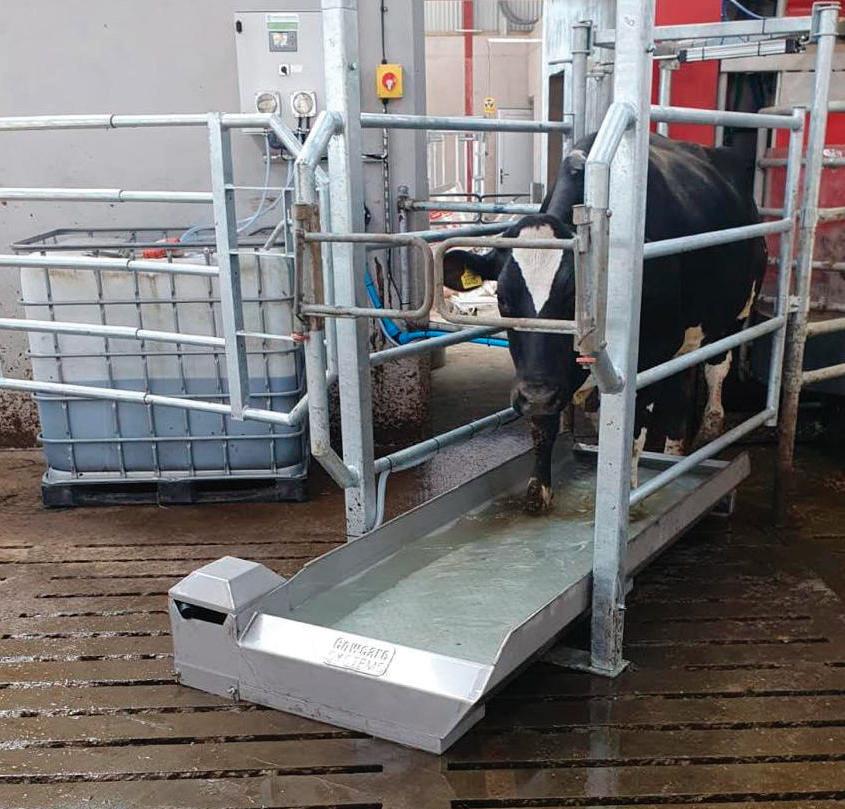
had a huge impact on the lives of its farmer supplies.
Livelihoods
She said: “We have seen dairy change livelihoods, empower women, and children can go to school and live in be er homes.
“Technology is now starting to become more important. We have some farmers who have 10 cows and they are starting to think about milking machines, but there are very few farmers in that range.”

D o you hate working with chemical ? Innovators
Pump
JANUARY 2024 27 Autoflush Footbath Benefits of the Autoflush Footbath Improved animal health Suitable for all chemicals Increases the herd performance
Minimises contact with chemical
Reduced labour costs
Reduced water consumption Efficient cleaning Cowcare SYSTEMS Features
positions: (left, right or centre)
length: 2 or 3 meter Non-slip flooring One Touch system programming Heavy-duty stainless steel construction For a no obligation quote or more information Wales/Midlands/S. England N.Ireland/ R.O.I John - 07732348225 Scotland/N. England 07591833853 Fred - 07762800149Andrew - 07803124235 info@cowcaresystems.com ✓ ✓ ✓ ✓ ✓
Standard
in Dairy Farming
Margaret Munene
Thoughts will soon turn towards the 2024 maize crop, so in this special feature, we offer some agronomy advice ahead of the growing season.
Growing maize in a changing UK climate
Growing maize in the UK presents its unique challenges, so what should growers be considering when planning the 2024 crop?
Having long been a popular crop for animal feed and recently gaining popularity as a rotational crop in regenerative farming, growing maize in the UK is not new.
However, the 2023 harvest, characterised by a notably wet autumn, with some areas receiving about 230mm of rain in October, underscores the challenges around successfully growing maize.
Dr Simon Pope, crop protection manager at Wynnstay, says last year’s maize harvest highlights the critical need for acute consideration of both sowing and harvest dates, soil types and crop nutrition. He says: “Many growers think the silver bullet to maize growing is the crop variety. But this is not the case. While plant breeders set the yield potential, agronomy dictates whether the crop will reach that potential. The time of sowing and harvesting, site choice and crop nutrition all play a key role in paving the way to a successful maize crop.”

Sowing and harvesting dates
JDr Pope says the sowing date does have an impact on the harvest date. He says: “A longer growing period equates to higher yields and the plants have greater opportunity to accumulate the heat units they require to reach maturity. But in recent seasons there has been a general trend to delay drilling.
“In order to maximise yields, we encourage growers to sow the crop as soon as the soil temperature reaches 8degC and is on a steadily rising plane.
“A minimum temperature of 10degC is necessary for rapid germination and establishment, typically this is achieved around April 20, yet we are finding many farmers are not planting until mid May, which is shortening the growing season.”
The timing of harvest is another important factor.
Dr Pope says: “The goal
for many is to harvest their maize from the end of September through to mid-October. But if harvested too early, before the crop has reached maturity, the quality of the forage will be reduced.
Late harvest
“Conversely, a late harvest could result in over-mature plants with high dry matter, bullet-hard grains and dead, brown leaves. This can impact on aerobic stability, forage quality and animal performance. Also, harvesting later increases the risk of poor weather, with associated issues of damage to soil structure from using heavy machinery on wet fields.”
But hope is not lost, Dr Pope says, as there are other management factors which growers can control to optimise their maize crop’s performance.
Choosing the right maize varieties
JDr Pope says for many years there has been a steady swing towards growers choosing earlier maturing varieties and this is certainly linked to the efforts of plant breeders to produce higher yielding material in this class.
He says: “Ultra early maturing varieties are now more widely grown than ever before and their shorter growing season means they can be sown later and harvested earlier.”
A further advantage of
JANUARY 2024 28
MAIZE
30 NEW VARIETIES Names to look out for 32 STRIP VS. MIN-TILL Pros and cons 34 LIFE AFTER MAIZE Post-harvest options
GRAIN MAIZE Could this be an option?
36
Maize has long been a popular crop for animal feed, but it has recently gaining popularity as a rotational crop in regenerative farming.

Site selection
JSite selection is important, as this encompasses both drainage, soil quality and type, says Dr Pope.
“Adequate drainage is crucial, as maize does not tolerate waterlogged conditions and at the other extreme, very light and free draining soils can expose the crop to drought stress during prolonged dry spells, which seem to be increasing in frequency.
“The UK’s changing weather pattern means careful decisions need to be made about where the crop is grown.
“Ensuring soil pH is within the optimal range [as close to 6.5 as possible] and the provision of adequate nutrition is essential for crops to reach their potential.
“Soil testing before sowing is the best way to understand the soil’s pH and nutrient status.”
Nutrient deficiencies can significantly impact crop yield and forage quality.
When provided with adequate macro and micronutrients, the maize crop is better able to reach its potential yield.
Many growers think the silver bullet to maize growing is the crop variety
DR SIMON POPE

FIT FOR THE FUTURE


The role of nitrogen, phosphate and potash for plant growth is widely recognised.
Dr Pope says: “Although often overlooked in maize crop nutrition, sulphur is also an essential macronutrient and required for normal growth and development of the plant.”
Biostimulants
Dr Pope says biostimulants have begun to play an increasingly important role in growing maize, offering a range of benefits which can enhance growth, yield and resilience to environmental stresses.
“Applying nitrogen-fixing bacteria can improve the efficiency of nutrient uptake in maize plants and reduce the dependence on manufactured fertiliser,” he says.
“Plant growth-promoting rhizobacteria significantly increase plant nutrient uptake while also fixing atmospheric nitrogen and, as a direct consequence, the nutrient use efficiency of soils is improved.”
early maturing varieties is the improved window of opportunity for establishing cover crops or following crops in the rotation. Early maturing maize varieties are harvested sooner, which leaves more time in the growing season for cover crops to be planted and established.
Dr Pope advises that when choosing the variety, farmers should look for strong all-round varieties and consider their local conditions.














FOXTROT FORAGE MAIZE
“We are using the best available varieties for our purpose and we’re not feeding any concentrates in the parlour.”
Richard Martin Cornish dairy farmer and Foxtrot maize grower



JANUARY 2024 29
lgseeds.co.uk/foxtrot
MAIZE
Three new maize varieties have been selected by Maize Growers Association technical agronomist Jon Myhill. Wendy Short reports.
New maize varieties for 2024 A
good all-rounder’ is how Jon Myhill of the Maize Growers Association (MGA) describes Faith; a new Grainseed variety which has been included in the 2024 forage maize descriptive list.
“Faith has a lot of potential, combining a high average yield with a good starch content figure,” says Mr Myhill.
“It falls into maturity group eight/nine, with an FAO of 165, and is classified by the breeder
Cover cropping
JCover crops are becoming more widely used ahead of maize planting, but growers should be mindful that they can remove soil moisture which is an essential element for successful maize establishment. Recommended cover crop species include cereals, rye, vetches, clover and radish.
Mr Myhill says: “Several options are available for destroying a cover crop prior to maize planting, including sheep grazing, a glyphosate application and mulching or ploughing in.
“Frost-vulnerable cover crop species may be a good choice in some regions, as they will


Jon Myhill
as an ultra-early variety. Faith is suitable for both favourable and less favourable sites.”
die off without intervention. If destruction is left too late in the spring, it can lead to the drying out of the topsoil.
“If sheep are used for grazing off cover crops the stocking rate should be kept low to minimise compaction.
“Bare soil visible in the sheep grazing is a signal to move the flock on to alternative area. If the plan is to use glyphosate, the cover crop should be assessed after Christmas, and bulky crops should be treated as soon as possible to allow plenty of time for the plants to break down.”
Cover crops can work well when combined with a plan for maize strip tilling, he suggests.
Another of Mr Myhill’s picks is SY Silverbull from Syngenta.
“It has a very high ME figure and has shown excellent dry matter yield potential in trials.
SY Silverbull also has good resistance to eyespot, which will interest growers in high disease situations,” he says.
“It is fairly early-maturing, classified as a maturity group eight/nine and carrying an FAO figure of 180. In my opinion, it is probably a better fit for a marginal maize-growing area, compared with a more favourable
“The cover crop can be retained between the strips allocated for maize planting. This will minimise the need for herbicide applications; a technique known as ‘planting green.’
“The sequence involves leaving the cover crop, planting the maize and taking out the cover crop soon after the maize drilling.
Weed prevention
“As the destroyed cover crop rots down, it will form a mat which helps to prevent weeds from growing between the rows. It will also protect the young maize plants and reduce the risk of soil erosion.”
Cover crops may not
farm location and soil type.”
He has also selected Skipper from Limagrain.
Mr Myhill says: “Skipper has been given a maturity group nine classification, with an FAO of 160.
“It is very high-yielding for an early-maturing variety and has attractive figures for starch and ME, although its eyespot rating is only 3.4, so growers will need to be vigilant.
“Skipper has performed well on both favourable and less favourable sites.”
be suitable for all rotations, he adds.
“Continuous maize sites are one of the exceptions where there may not be an opportunity for cover cropping.
“Therefore, I would always advise undersowing for continuous maize, because overwintered maize stubble can increase soil and water run-off.
“Another potential problem area with continuous maize is damage caused by the European corn borer.
“The insect can cause significant crop losses, although infestation to date has largely been confined to counties in southern England, including Essex,” says Mr Myhill.
JANUARY 2024 30
MAIZE
PICTURE : Tim Scrivener


NAVIGATe TO SUCCESS

Good seedbed preparation is key to establishing a successful crop.
Cultivation advice
JMaize strip tillage is becoming increasingly popular with growers, says Mr Myhill.
He says: “There has been a trend towards direct drilling in general. However, maize is unsuitable for direct-drilling because it requires good seed-to-soil contact to promote germination and it does not perform well in compacted soils.
“Strip-tillage offers a halfway house option between full ploughing and direct drilling, with most growers who have implemented the system sowing grass/clover leys in the strips between the maize rows.
“It can enhance soil moisture conservation compared with ploughing. Adequate soil moisture is crucial for good maize establishment and the change in weather patterns has led to increased drought risk in some regions.”
Mr Myhill explains maize strip tillage is a two-pass system, which is cheaper than plough-based preparation and also has potential environmental benefits.
He says: “It is less harmful to the environment compared with the plough, as limiting ground disturbance promotes the preservation of soil organic
matter and minimises erosion and nutrient losses.
“It is also associated with a reduction in fuel usage, and it reduces the wear and tear on machinery parts by comparison. The MGA will be looking at various strip tillage practices in 2024 trials.”
Soil issues
Despite the potential advantages offered by strip-tillage, Mr Myhill says that the unfavourable response of young maize plants to seedbed compaction means that soil issues must be addressed before the maize drill comes out of the shed.
“I would only recommend sub-soiling in cases where the soil is highly compacted. For minor issues, the cultivation tool should be set just under the compacted soil layer,” he says.
“The target for optimum maize seedbed preparation is to achieve a balance between ensuring good seed-to-soil contact and avoiding the creation of a very fine tilth, which can make the surface prone to capping.”
rFor more on strip tillage and min-till, see page 32.
















SKIPPER FORAGE MAIZE
Navigate to a successful maize crop, whatever the challenge. Choose Skipper for top starch yields from a very early harvest.


JANUARY 2024 31
lgseeds.co.uk/skipper
MAIZE
The results of a comparison between mintill and strip tillage for maize establishment were outlined in a recent webinar focusing on maize.
Maize strip-tillage came out on top overall in terms of nancial input and plant establishment rates, although yield results were slightly lower compared with the min-tilled crop, reported Edd Fanshawe, of machinery manufacturer Kuhn.
He said: “ e maize striptillage in our trial produced an £8.50/hectare saving in diesel costs compared with the crop established using min-till, with the strip-tillage also giving an average of 1.1 more plants per metre.
“However, the min-tilled crop outperformed the strip-tillage by 1.23 freshweight tonnes/ha, producing 55.1t, compared with 53.87t. Silage dry ma er percentages were the same for both crops at 33.”
e two trial plots received a pre-emergence herbicide application. Drilling conditions were favourable and the maize seed was sown on May 13, coupled with 95kg/ha of a monoammonium phosphate fertiliser at a depth se ing of 5-6cm.
e strip-tilled crop was established in two passes using a Striger 6m mounted machine with eight rows and 75cm spacings.
Meanwhile, the min-till technique


A 2023 maize trial explored how different establishment methods could greatly influence the economics of growing maize. Wendy Short reports.
Economics of different establishment methods
used one pass with the Cultimer; a mounted tine cultivator with 80mm points and a metal packer, followed by one pass with a power harrow.
e maize crops on the two systems were also given a postemergence application of herbicide on June 12.
Last year was the rst year of the trial and starch contents were



Strip-tillage is a relatively new concept for maize establishment in the UK


not analysed, although the data will be included in a larger scale comparison of the two systems which is being planned for the 2024 season, said Mr Fanshawe.
“Strip-tillage is a relatively new concept for maize establishment in the UK,” he said.
Potential
“It certainly has the potential to reduce input costs and there are some other potential advantages. Strip-tillage is known for improving ease of travel at harvest time, as machine wheels can run on uncultivated land.
“ is was borne out on the trial site, as the strip-tillage had fewer
Malpas, Cheshire, trial
ruts and there was a reduction in surface water, compared with the min-tilled area.
Useful
“ is e ect would be particularly useful in poor conditions and it also helps to reduce compaction. In addition, strip-tillage has a lower level of carbon release than min-till, as only the seeding lane has to be worked.
“While the strip-tilled crops got up and away more rapidly, the min-tilled maize caught up later in the season. Post-harvest, the striptilled area was noticeably drier and this made it easier to establish the following cereal crop.

EDD FANSHAWE
rFour hectares (10 acres) of min-till
r5ha (12 acres) of strip-till
rMaize variety was Echo (LG Seeds)
rHarvest date of October 3
rEnd use was maize silage for dairy cows
“I do not consider the yield result di erences between the two establishment systems to be highly signi cant. I would have expected the strip-tilled maize to outperform the min-tilled crop and it is not relevant to draw any rm conclusions, as the entire test area covered just 9ha.
“Many other factors could have a ected productivity and it will be interesting to see how the gures stack up for maize harvest 2024.”
JANUARY 2024 32
Strip-tilled maize.






WITH OUR HOW YOU FEED YOUR HER D 2.0 TRANSFORM NEXT GENERATION AP P







Feedlync is smart feed management software that reduces feed costs and increases milk yield by improving loading accuracy and monitoring of feed intake and usage.
Come and join us at Dairy Tech to talk saving money on your feed bill and to check out our new app and user interface.


CONTACT U S www.feedlync.co m 020 3966 906 3
FINDUSAT
Planting a crop after maize harvest is a good way to produce extra forage and benefit the land. Sarah Alderton looks at the different cropping options.
Options for crops post-maize harvest
Having a plan for maize ground post-harvest is essential to maximise productivity, prevent soil erosion and reduce nutrient leaching.
Cereals
JMr Myhill says: “The maturity of the maize variety you are growing will determine the approximate harvest date. If you are growing an early maturity variety, cereals such as wheat and barley are often the most popular cropping option to follow maize as it
Cover crops
JCover crops may provide a suitable cropping option where later maturing maize varieties are grown, says Mr Myhill.
Ideally, cover crops should be planted almost immediately post-harvest to benefit from day length, suitable seedbed temperatures and moisture. Most can be drilled straight into a stubble, keeping costs and time to a minimum.
COVER CROP OPTIONS
INCLUDE:
rMustard – Quick to establish, this crop can produce a good amount of biomass. White mustard is mostly used since it is quick to establish. It is good at preventing weeds and can help improve soil structure. However, it is not winter-hardy.
And with forage being in short supply for many over the last two years, establishing a crop a er maize provides the perfect opportunity for farmers to produce more while
gives them enough time to get well established.
“Cereals can be directly drilled between September and November, but the later in the season, the higher the seed rate. Farmers drilling cereals should start at about 220 plants/sq.m, increasing to 380 plants/sq.m later in autumn.”
safeguarding their land. However, deciding what crop to go in with a er harvest depends on the maize variety being grown, says Jon Myhill, agronomist at the Maize Growers Association.
Undersowing
JMr Myhill says more farmers are considering undersowing with maize, especially on high-risk fields prone to soil loss.
He says: “It is also popular for farmers wishing to graze their sheep or cattle the following spring.”
No additional nutrients

are required, with grass mopping up any excess nutrients left behind from the maize. Crops should be drilled ideally 20cm away from maize rows to avoid competition.
Date
rForage rye – Where farmers are looking to grow wholecrop for feed, rye is a good option as it offers steady growth throughout winter and is frost-hardy. Its good growth means it can help prevent soil erosion and leaching quickly and is excellent at assisting soil structure and preventing weeds.
rItalian ryegrass and Westerwolds – Short-term annual Italian ryegrass or Westerwolds should be sown immediately after harvest and well before conditions deteriorate.
This can provide a light bite of grass later in winter, but is best left until early spring for grazing. Westerwolds establish quickly in lower temperatures and are high yielding, providing a useful feed source in spring, but they are not the hardiest grass over winter.
Italian ryegrass offers better longevity and gives comparable yields to Westerwolds. Both should be drilled or broadcasted as soon after maize is harvested and before the middle of October. Alternatively, if travelling on the field is a problem, then Italian ryegrass and Westerwolds can be undersown with maize at a seed rate of 12kg/hectare (4.8kg/acre) in between the rows when the crop is at the four- to six-leaf stage.
Mr Myhill says: “The good news is Italian ryegrass and Westerwolds also qualify as a companion crop under the Sustainable Farm Incentive, so payment is there to cover the cost of the seed and the establishment.”
The type of crop grown will depend on sowing date. Early drilled crops (typically first week in June) should be less competitive, such as a fescue.
Crops drilled towards the mid to end of June need to establish rapidly. Examples include perennial ryegrass and Italian ryegrass.
Recommended seeds rates vary between 12-16kg/hectare (4.8-6.5kg/acre).
These should be drilled and not broadcast to increase the chance of the crop establishing.
However, for growers of maize under film, undersowing is not an option, says Mr Myhill.
“In this case, growers may need to think about an autumn cereal or grass sown after maize harvest.”
MAIZE JANUARY 2024 34


Establishing a crop after maize provides the perfect opportunity for farmers to produce more while safeguarding their land.









Grain maize considerations
JThe options for those growing grain maize are slightly different due to the crop being harvested later.
Mr Myhill says: “Grain maize is becoming more popular because it provides an alternative break crop to sugar beet or spring barley, and the gross profits are respectable too.
“However, because the cob needs to dry, harvesting does not usually begin until mid to late October when the cob is at about 30% moisture.
“Farmers can direct drill into winter stubble with wheat, but they must be mindful of fusarium in the following crop because they are leaving so much of the maize crop residue in the ground. A robust fungicide programme may be needed for the cereal crop.”
Mr Myhill says that as a last resort, if farmers cannot undersow or get a crop in after maize, they are to pull through headlands or any compacted areas to minimise areas of standing water.
Bare soil
He says: “The risks of leaving bare soil over winter are well documented and, ideally, everyone should be considering a crop after maize to prevent further damage and to consider the soil’s long-term health. Also, consider reducing damage during harvest by reducing tyre pressure on machinery.
“If your maize land is on a slope, it is always best to cultivate across the slope rather than up and down, to slow down the water.”

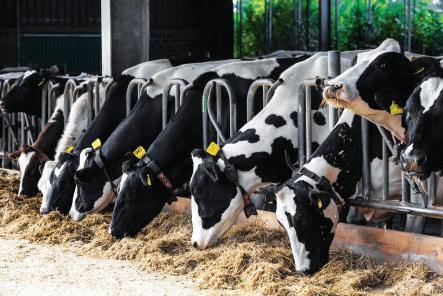


















































































































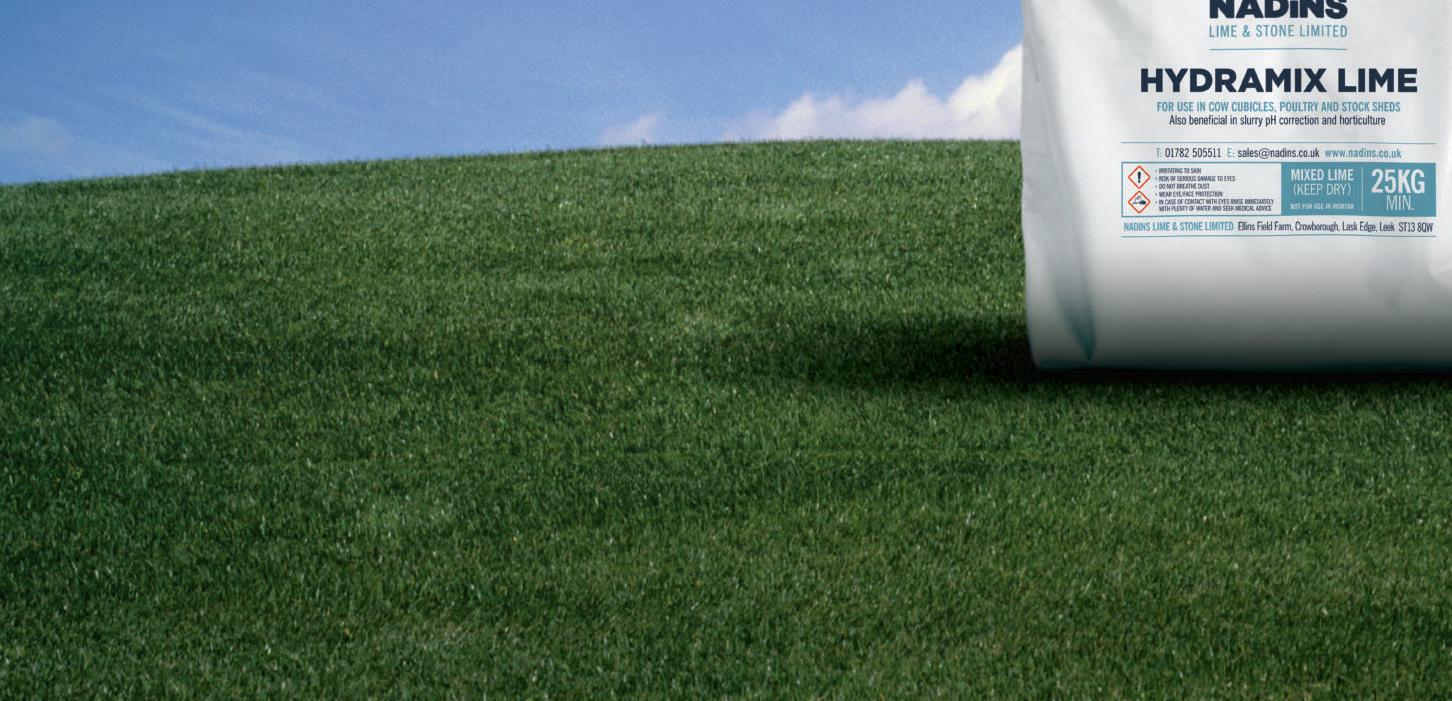







JANUARY 2024 35
MAIZE
For more on growing maize for grain, see p36.
Producers looking to reduce costs and boost output could do well to team up with arable growers planning to grow maize this spring following a difficult autumn drilling programme. Dairy Farmer reports.
Grain maize becoming increasingly popular dairy feed
Challenging winter drilling conditions, the failure of many oilseed rape crops and a shortage of spring cereal seed could result in many arable producers turning to maize in 2024, resulting in signi cant opportunities for milk producers, says Angus Fox of Grainseed.
He says: “We are seeing a considerable upli in requests for information on maize seed availability from arable producers, many of whom are considering growing the crop for the rst time in 2024.
Varieties
JWhen growing maize for grain, Mr Fox says the variety profile is important because crops need to keep standing completely upright until the crop is combined.
He says: “We advise growers to consider the variety Crosbey on lighter soils or where droughts may occur. It is a big strong plant featuring well-filled cobs and its early starch lay down enables crops
“One of the most frequently asked questions is about markets available for the crop and we are quick to point out one of the best options is to work with local dairy producers and see if they are interested in taking the crop.
“Dairy farms are o en limited in the acreage of maize which can be grown, especially if they are grazing grass too, and a partnership where maize silage is grown and muck or slurry is swapped for nutrient supply can work well for both parties.”
Mr Fox says silage ideally needs to be grown within 10 miles of the clamp to reduce road travel at harvest
to be harvested in relatively good conditions. Crosbey has an exceptionally high grain yield with good drought tolerance and when grown at the lower plant population of 90,000 per hectare, recommended for grain crops, has massive cobs.
“The group eight variety Constance is another strong grain contender. It is a week earlier to harvest than Crosbey and suits soils which are more bodied in structure.”


with trailers, but for larger volumes and longer distances, lorries can be used. In addition to forage, grain maize is a great source of energy for dairy cows and an ideal component of total mixed rations, he says.
Attractive
“Grain maize is usually the alternative most suited to arable producers’ mindset and it is also a highly a ractive option for milk producers looking to replace bought-in concentrate with home-grown feed sources.
“Grain maize contains more starch and energy than other cereal grains



and has a relatively high level of bypass starch which travels through the rumen undegraded and is digested further down the digestive tract.
“ is reduces the speed of fermentation and minimises possible dietary upsets, such as acidosis, in mixed cereal diets.
“As with maize silage, additional protein, in particular e ective rumen degradable protein, is required to provide a well-balanced diet, along with a source of ‘long’ bre to promote healthy rumen function, but grain maize is a great source of energy.”
Crimping benefits
JCrimped maize is usually a better option than dried, whether you are producing it yourself or buying it in, says Mr Fox. He says: “With crimping, freshly harvested grain is processed through a crimping machine to crush the kernels and an additive applied to preserve the grain.
“The process reduces the cost and environmental impact of livestock feed production by eliminating the need for grain
drying and minimising feed transport distances.
“Moisture content aside, the nutritional analysis of crimped maize does not differ significantly from the dried product. Crimped maize can generally be fed at much higher levels than rolled or ground cereals and allows a higher overall proportion of grains to be fed in rations without the increased risk of acidosis and other rumen issues.”
JANUARY 2024 36
MAIZE
Angus Fox (inset) says grain maize is a highly attractive option for milk producers looking to replace bought-in concentrate with home-grown feed sources.
IT’S A BUMPER YEAR FOR BRITISH SUGAR BEET

WHICH IS GREAT NEWS FOR OUR PRICES!






RESERVE THE NATION’S FAVOURITE FEEDCALL YOUR MERCHANT TODAY WITHOUT DELAY
Dairy-Tech 2024 will be taking place at Stoneleigh Park on Wednesday, February 7. Dairy Farmer takes a look at what is in store for visitors.
What to expect from Dairy-Tech 2024
New products, innovation and ground-breaking technology will be on show at this year’s Dairy-Tech, with organisers se ing out to bring dairy farmers an event which recognises the needs of modern dairy professionals.
As well as the latest in services and concepts, there will also be speaker sessions in the Dairy and Innovation Hubs. Here, topics will

range from dairy market updates, achieving carbon neutrality and looking at how your levy is spent.
Technology giant Google will open the Dairy Hub with a keynote address, looking at future consumer dynamics, what changes we are likely to see, and answering the questions around why it is important for businesses to stay aligned with the ever-changing needs and requirements of the consumer.
Other top experts will feature
on the Dairy Hub discussing the environment, how to achieve carbon neutrality and the role of diversity in agriculture.
ere will also be a dairy market update debate, hosted by Chris Walkland.
e Dairy Hub will also host Hillary Curnow, counsellor for the New Zealand minister of foreign a airs and trade, who will detail how New Zealand’s journey to net zero and look at how it compares to
what we are doing and the progress we are making in the UK.
As part of this year’s session on animal health and welfare, Defra’s policy lead Martin Jenkins will give a Government update on driving down disease.
is session will conclude with the presentation of the Royal Association Of British Dairy Farmers’ farm health management award – a competition open to vet and agricultural students based on proactive farm

JANUARY 2024 38 DAIRY-TECH PREVIEW
Last year’s Dairy-Tech drew impressive crowds.
Healthy Feet Zone
JVisit the Healthy Feet Zone to find out about the prevention and treatment of lameness on-farm. The zone will include demonstrations from experienced cattle lameness vets, vet technicians and foot trimmers, who will be able to identify and explain the causes of lameness, possible treatments and how to prevent these problems from occurring on your farm.
Two demonstrations will take place at 12 noon and 2pm,
health management practices.
e Innovation Hub will be dedicated to showcasing the latest technologies available to help the modern dairy farmer.
is will include on-farm diagnostic testing for mastitis and a session on the current grants available for those investing in technol-
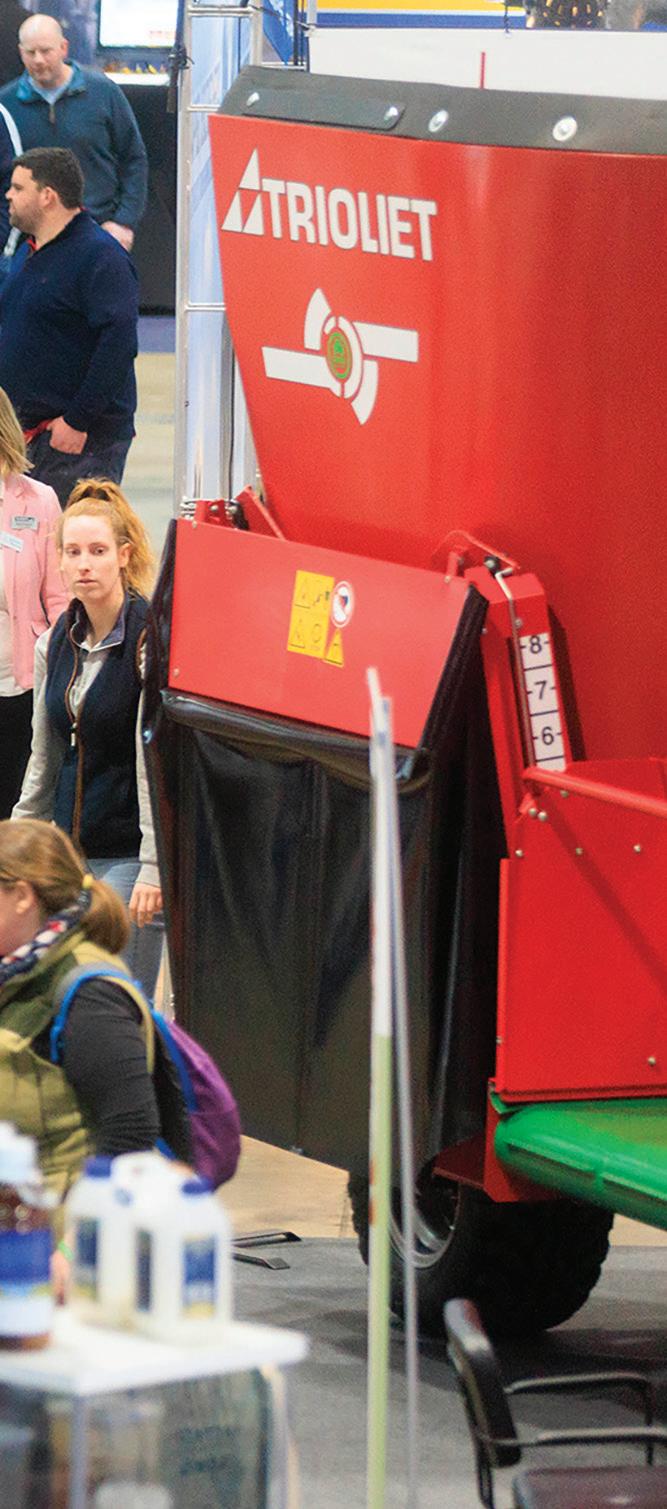
using real feet, to show both common and more unusual causes of lameness, where visitors will have the opportunity to discuss the practical ways to prevent them from occurring. A team of experts will be on hand to answer questions and outline how correctly identifying lesions and their causes, alongside best practice foot trimming, is the most effective way of being able to appropriately treat different types of lameness.
ogy, infrastructure and equipment.
e event will also host a newly branded ‘Healthy Feet Zone’ in hall 2A, and new for this year’s event will be a training area, which is being led by training provider LANT , where there will be demonstrations focusing on topics such as farm safety and livestock handling.
Dairy-Tech
rWhen: Wednesday, February 7, 2024, from 8am to 5.30pm
rWhere: Stoneleigh Park, Coventry, CV8 2LG
rTickets: All visitor tickets booked in advance are sold at a discounted rate of £20, with free tickets and further concessions for Royal Association Of British Dairy Farmers members; tickets purchased on the gate are £25; discounted tickets are also available for students and Young Farmers
SCAN NOW FOR TICKETS

rMore information: dairy-tech. uk or office@rabdf.co.uk
Cold Weather Calls for Top Teat Care




JANUARY 2024 39 PREVIEW DAIRY-TECH
Autumn
Winter Care
Healthy Teats
Neogen's
Teat Dips Scan to Learn More and for Your Chance to Win! Visit Neogen® at Dairy Tech 2024, 7th February, Stand No. T64 Join Neogen EMEA – Animal Safety & Genomics
our form to enter our grand prize draw, where you could win one of three Sonos ROAM Portable Waterproof Wireless Speakers, along with Neogen's autumn and winter teat dip range. T&Cs available online Worth over £100!
and
for
with
Range of
Complete
Four UK dairy businesses have been named as finalists in the 2023 National Milk Records and Royal Association Of British Dairy Farmers Gold Cup. Dairy Farmer looks at each of the finalists.
Meet the Gold Cup finalists
Bisterne Farms Sandford, Ringwood, Hampshire
JA collaborative approach has been the foundation for a new contract farming agreement (CFA) on the Bisterne Estate, Hampshire.
In 2019, when estate owner Hallam Mills was reviewing the direction of his dairy enterprise, it was decided that a CFA would best facilitate the business’ next chapter.
With George Brown brought on board as his contract farming partner, they have reshaped their dairy enterprise, investing in infrastructure to make the dairy resilient for the next 20 years.
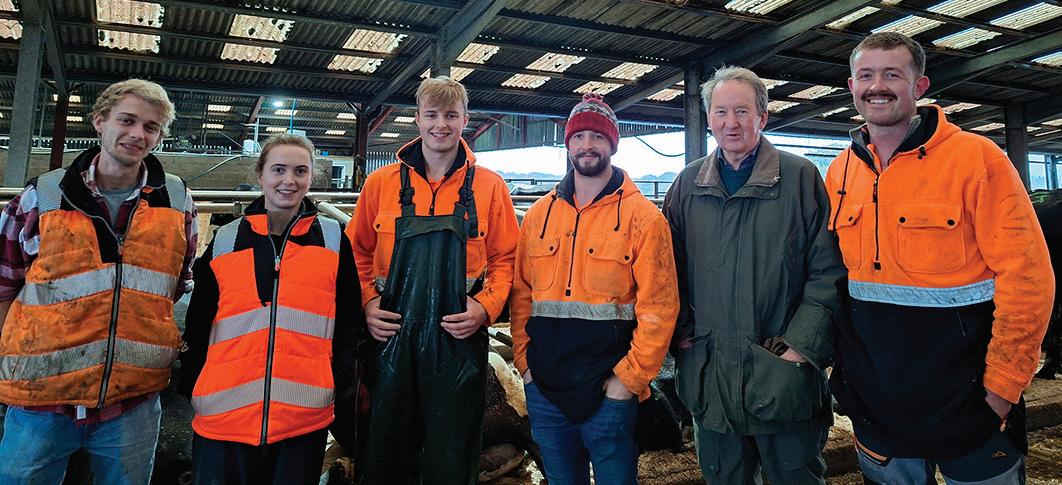
Ringwood, the focus is on producing milk from grazed grass.
Their target is to reach 4,000 litres from forage and they are currently achieving 3,730 litres.
gains which will enable them to hit 600kg without compromising herd fertility.
the most of forage. Cows graze across a 190ha (470acre) grazing platform from February 4 to December 21.
The herd was originally predominantly spring calving and out-wintered on fodder beet. However, with the farm being on freedraining soils, they have struggled for grass in summer and have resorted to feeding silage, so they have now transitioned to a 350/250 autumn/spring split.
Now milking 600 predominantly cross-bred cows within the 1,500-hectare (3,700-acre) estate near JSustainability is the name of the game when it comes to Worthy Farm, Somerset, which is famous as the site of Glastonbury Festival. A previous Gold Cup winner back in 2014, the dairy business is back in the limelight.
This farm has changed considerably in the past decade, thanks to the adoption of technology, including solar panels, rainwater harvesting and an anaerobic digester, with a long-term innovative ambition to dry slurry to a prilled, exportable fertiliser.
The real headliners of this farm are, however, the 500 Holstein dairy cows, which are producing more than six million litres of milk a year, from an average of 12,000kg per cow,
Cows yield 550kg of milk solids per cow per lactation, with attention now turning to the genetic and management all through a robotic rotary milking parlour.
They mostly use New Zealand Friesian sires, with some use of Irish and Kiwi cross bulls. Grassland management is key to helping cows express their genetic ability and make
Michael Eavis Pilton, Shepton Mallet, Somerset
Milk goes to cheesemaker Wyke Farms and one-third of the farm’s supplies are made into Worthy Reserve Cheddar and sold to retail outlets.
Management
Managed by John Taylor and wife Pam, the focus is on maximising milk from forage, with cows grazing for more than 100 days in the year. They only take one cut of grass silage a year from 315ha (780 acres) in mid-May, with slurry being the only fertiliser used.
Breeding and achieving a highhealth herd is key in the farm’s quest for sustainability. Cows are artificially inseminated to Holstein Friesian and all
The fine attention to detail is only possible thanks to the strong, ambitious team supporting George, with five full-time staff members and three students working on-farm.

heifers are served by selected Aberdeen-Angus bulls.
Herd health is a key focus in this herd. Johne’s disease screening is carried out quarterly via National Milk Records’

HerdWise service, using the milk sample collected at recording. They have also worked hard to reduce the use of injectable antibiotics for mastitis over the past few years.
Continues over the page...
JANUARY 2024 40 DAIRY-TECH PREVIEW
Left to right: James Dunning, Charlotte Lawder, Adam Reddish, Oli Mears, Hallam Mills and George Brown.
John Taylor (left) and Michael Eavis.








R Animal Nutrition For consistently better silage Visit | www.ecosyl.com Offer ends 31st January 2024 Copyright © 2023 Volac International Ltd. All rights reserved.
DAIRY-TECH PREVIEW
Graham Farms Drumgoon Manor, Maguiresbridge, Co Fermanagh
JAttention to detail in all aspects of their dairy business has seen the Graham family from Northern Ireland shortlisted.
The family operation, run by father William and sons Jason and Stuart, sees them milking 600 pedigree Holstein cows all year round with milk sold to Glanbia.
Production is outstanding from this all-year-roundhoused herd. Undoubtedly, the family’s skills, experience, enthusiasm
and hard work have been a significant part of the success of the business now and in the future.
Herd health is unrivalled, with mastitis cases averaging seven in 100 cows and lameness is down to five in 100 cows.
The family is renowned for its top-quality breeding stock, with about 250 heifers and in-milk cows sold off the farm each year. This forms a large part of the business’ success, with
the income outweighing the total cost of rearing the heifer replacements.
Animals are fed to yield in the parlour, with a push to increase the amount of milk from forage by adopting a multi-cut silage system.
Clover
This year, they also started introducing clover into the grass swards for extra protein and its ability to fix nitrogen into the soil.
The business is also

More about the Gold Cup
JThese four herds are selected from UK dairy herds meeting the Gold Cup 2023 criteria for the year ending September 2022 of:
rMore than 100 cows/heifers with qualifying lactations in the milking herd
rAnnual somatic cell count average of 200,000 cells/ml or less, or 250,000 cells/ml for organic herds
r Minimum Profitable Lifetime Index value specific to the breed, or minimum Spring Calving
Index or Autumn Calving Index value
All entrants completed a detailed entry form.
Finalists are selected and undergo an on-farm inspection by judges: Robert Craig, Royal Association Of British Dairy Farmers (RABDF) chair and Cumbrian dairy farmer; immediate past chair of RABDF and Devon dairy farmer Di Wastenage; National Milk Records’ (NMR’s) veterinary adviser Dr Karen Bond; and 2020 Gold
Cup winner, Essex dairy farmer
John Torrance.
Winners of the NMR Silver Salver, The Lilyhill Cup and The Chairman’s Cup, awarded to qualifying Gold Cup herds with the highest combined fat and protein production for their breed, and the Chris May Memorial award for the herd with the highest lifetime daily yield, will be announced alongside the presentation of the 2023 NMR RABDF Gold Cup at Dairy-Tech on February 7 on the NMR stand at 4pm.
targeting slurry use by using low-emission slurry spreading equipment to effectively use slurry and reduce the use of purchased fertiliser.
The use of slurry additives is also helping them to increase the available nitrogen and reduce the need for bagged fertiliser.
They have signed up to Daera’s Soil Nutrient Health System and the entire farm is being soil sampled to determine a starting point for carbon sequestration.
Joe Ives W. and P. Ives,
JJoe and Claire Ives are not newcomers to the top line-up; they were finalists in 2020 and winners of the Chris May Memorial Cup in 2019. But this time they hope to appeal to the judges with new developments to future-proof the business and improvements to ensure they produce top-quality milk in a sustainable way.
This 206-hectare (510-acre) tenanted dairy farm dedicates 160ha (295 acres) to the dairy unit, home to the 250-cow Gladwake pedigree Holstein herd, founded


Last year’s Gold Cup winners, the Logan family, Ayrshire.
JANUARY 2024 42


Herriard, Basingstoke, Hampshire
by Joe’s parents Bill and Peggy. This all-year-round-calving herd is milked through four Lely robots and supported by five full-time employees working alongside Joe.
In the past four years, they have upgraded the dairy farm infrastructure and introduced technology to improve housing, so cows have the right environment for fulfilling their potential.
They have recently completed a far-off dry cow building and serving barn for heifers with locking yokes and a robotic cleaner.
With the help of genomic
proofs, the aim is to breed efficient, profitable, long-life heifers from the best-bred cows using sexed semen.
Herd health is monitored carefully and the Gladwake herd is screened for Johne’s disease, BVD, IBR and leptospirosis through the Premium Cattle Health Scheme.
Technology also helps them monitor body condition with weights recorded at every milking. The nutritionist and vet will investigate any worrying trends.

FBP BALEPACK
Fixed chamber baler-wrapper combination


MAXIMISE FORAGE QUALITY
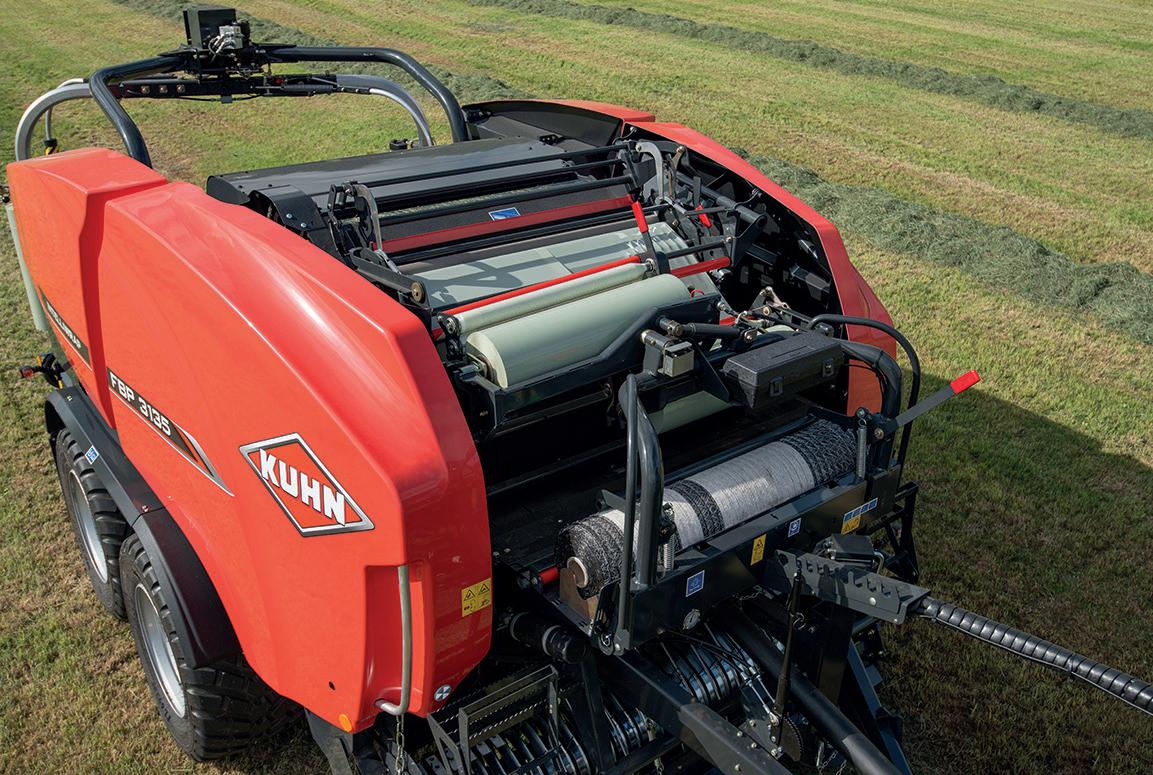
FILM BINDING
Patented award winning technology
Reduces costs, enhances bale quality and simplifies wrap recycling.

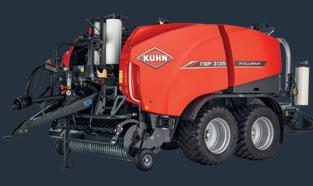

VBP

JANUARY 2024 43
The KUHN baler-wrapper combination range
FBP i-BIO+
Left to right: Stuart, William and Jason Graham.
Some of the latest dairy technology, products and innovations will be on show at this year’s Dairy-Tech event. Katie Jones takes an early look at some of them.
New products being launched at Dairy-Tech
Managing transition cow risk
JUsing your farm’s existing management software, the AI tool Predicta Guardian, from Dairy Data Warehouse, analyses milk recording or milk meter data, along with reproduction data from a cow’s previous lactation, to determine whether a dry cow is at risk of transition diseases.
The tool generates health alarms for individual animals during the dry period so early intervention can be made.
Producers are offered a twomonth free trial of the product, which usually costs about £350£400 for a 180- to 200-cow herd.
rMore details at dairydatawarehouse.com
Tool to manage dairy emissions
JA web tool, MCi Dairy Emissions Manager, has been designed by The Dairy Group to help dairy farmers understand and manage their dairy emissions.
Key data can be entered monthly to enable reporting of dairy emissions for any time period and the system uses the same data as used for monthly dairy costings to save the duplication of data recording.
Data collection is flexible and can be done either via web entry, via an app or via a bureau service.
The Dairy Group also
provides additional tools to help with the understanding of dairy emissions, including a Relative Feed Value calculator, which provides both the monetary value together with the emissions value for the different feeds.
This development is the culmination of a threeyear Innovate UK project, in conjunction with Nottingham University and Quality Milk Management Services.
There is a £30/month cost for the MCi Dairy Emissions Manager.
rMore details at thedairygroup.co.uk
Testing calves for antibodies
JA penside test, ImmunIGY Bovine IgG, to determine the level of antibodies present in calves up to 42 days of age, is now available.
Developed by Bimeda, the test uses blood from
a small prick to the calf’s nose, which is then used in a lateral flow test to give a result within 10 minutes.
rMore details at calf-immunity.co.uk

Slurry inoculant cuts crust formation
JA new slurry inoculant containing specialised strains of bacteria and fungi, which has been found to reduce crust formation on slurry stores by almost one-third, will be on show from EnviroSystems.
The inoculant comes in two forms – SlurryBugs and SlurryBugs Maintenance –and should be used in a two-step process.
New customers and those with a crusting issue are advised to use SlurryBugs to break down any existing crust and prevent any fibrous material added to the store from accumulating.
Each sachet (1.5kg) will treat 500cu.m of slurry for the duration of its storage.
Customers are advised to treat for the duration of the storage.
Once a homogeneous slurry has been achieved and the crust is under control, SlurryBugs Maintenance is a lower-concentration product which can help prevent further problems. It can also be used over summer to top up the bacteria content and prevent dry crusts from forming ahead of the next storage season. There is also an opportunity for farmers to apply for a free year’s supply of SlurryBugs in exchange for data collection. Spaces are limited and terms and conditions apply.
rFor more information, visit the stand at Dairy-Tech or email the team at info@envirosystems.co.uk; the closing date for applications is February 28; more details at envirosystems.co.uk
JANUARY 2024 44 DAIRY-TECH PREVIEW
Continues over the page...





hether

Explore the wide range of career opportunities beyond farming



Whether you are seeking a new career path or aiming to further develop in your current role Jobs In Agriculture can help.



We are dedicated to connecting the right individuals with the right opportunities. With a diverse range of opportunities available, including on-farm positions, exciting roles in science and technology, engaging marketing and sales positions and more.
Ready to explore beyond farming?


It is time to open the gate to your growing career








The agriculture industry provides roles that cater to every interest and skill set. Whether you enjoy working outdoors in the fields, prefer the company of machines and technology, or like working with numbers and science, there’s a role for you in this industry.
All you need to do is connect with the right people... It’s never too late to explore a career in agriculture! That’s why we will be there to help you find the right path for your future at LAMMA 2024.
Begin your journey with Jobs In Agriculture by joining us at the brand new LAMMA 2024 Career Zone.
Scan the QR code below or visit, LAMMAShow.com/career-zone






Scan here
is a
of endless
opportunities
the improved website
Checkitout!
Agriculture
world
career
Discover your next step. Introducing
For more information scan the QR code or visit, jobs.farmersguardian.com
DAIRY-TECH PREVIEW
Hoofcount launches Multi-Bath
JA system enabling producers to cost-effectively invest in and run up to five individual automated footbaths from one control box is being launched by Hoofcount.
Hoofcount Multi-Bath uses a central control box to monitor and control each bath, while the system features a valve unit installed alongside each footbath to control and correctly dose with chemical solution and enable it to run independently.
The footbath solution can be stored in one central location. Each footbath can be monitored and controlled via a mobile app. The Multi-Bath system
was originally designed for North American farms with significantly larger herds and where distances between baths and chemical store are greater than UK farms.
However, with the trend towards larger UK dairy units and multiple automated milking systems, coupled with producers adopting a whole herd approach towards footbathing, the company says this system enables UK farmers to cost-effectively invest in just one control box to manage up to five footbaths installed on-farm.
rMore details at hoofcount.com


Spread-a-Bale launches Micro ST
JSpread-a-Bale is launching a new option to its ‘M’ range of straw spreading machines for dairy producers with onetonne to 2t lift capacity loaders and designed for bedding calf
Healthy and optimal calf rearing from Holm and Laue
JA group of three electronic weighing scales for calves, part of the WeightControl family, is now available from Holm and Laue.
Three products
The three products – the WeightControl Base (platform scale), WeightControl Single (mobile individual scale) and WeightControl Multiple (mobile group scale for front loader transport) – have all
been designed to make the weighing of calves easier so a database can be created to aid management decisions such as selection and feeding strategies.
Each of the weight scales is fitted with a Radio Frequency Identification reader, which automatically recognises the calf’s eartag.
Costs range from £4,500 to £7,600.
rMore details at holm-laue.com
Disease detection from in-line milk analyser
JAn in-line milk analyser, Brolis HerdLine, has been developed by the high-tech company Brolis Sensor Technology.
It is based on a nextgeneration infrared laser sensor, which enables exceptional accuracy in real-time measurements.
It is compatible with a wide range of milking parlours and can operate with both new and old milking systems.
The data provided at
the individual animal level is used for the early detection of diseases and can also be used to help make decisions on genetic selection.
Information
The summarised information about the health and productivity of the dairy herd can be viewed using the Brolis HerdLine software on a computer screen, tablet or smartphone.
rMore details at brolisherdline.com
hutches and buildings with narrow access points.
Called the Micro ST (Side Throw), the machine combines a 695kg lightweight steel chassis and bracketing


system and measures 1.78 metres wide.
The Micro ST, which has a starting price of £15,750,
is available from Spreada-Bale’s dealer network.
rMore details at spread-a-bale.com
JANUARY 2024 46
Retro-fit clean-tech system
JA new retro-fit clean-tech system for existing automated milking systems is now available from UK-based innovation company Oxi-Tech.
Called Pulse Oxidation Dairy (POD) for Robotic Systems, the technology can be integrated into existing robotic systems and features next generation software with secure cloud data and remote phone app monitoring, which optimises Oxi-Tech’s unique chemicalfree disinfection system.
The technology uses low voltage electricity in a process called pulse oxidation to disinfect the water. Pulse oxidation energises cold water to create a clean but powerful disinfectant which includes a range of activated oxygen molecules which are recognised as powerful microbial biocides,
killing bacteria, viruses, fungi and protozoa, including chlorineresistant cryptosporidium.
Once the activated oxygen has undertaken disinfection, any remaining molecules simply revert to oxygen and water, so there are no side effects to the milk or water.
Energy

and protozoa, including chlorine-

The company says that when compared with an automated milking system’s existing cleaning system, requiring energy to heat the cleaning water, this new technology uses about 50 times less energy.


The system has a start-up cost of £30,000 and a typical return on investment is estimated to be three years based on two milking robots.
POD for Robotic Systems is estimated to reduce a
250-cow herd’s carbon footprint by more than five tonnes per
by more than five tonnes per year. The figure includes the carbon associated in producing and transporting cleaning chemicals in blue plastic barrels and their disposal. The system is installed by connecting the existing wash

components accommodated in a standalone one-metre by 1.5m slimline black steel box, either wall mounted or mobile. POD requires one bi-annual service.
rMore details at info@oxitechsolutions.com


Winter Teat Dip Selection
How can Kersia help to protect teat skin condition?
• An excellent post teat dip product
• Chlorhexidine and lactic acid
• A broad spectrum teat disinfectant
• Provides a barrier dip for extended protection between milkings
• Low consumption - economical to use
• Formulated with skin-kind ingredients to improve skin teat condition www.kersia.uk
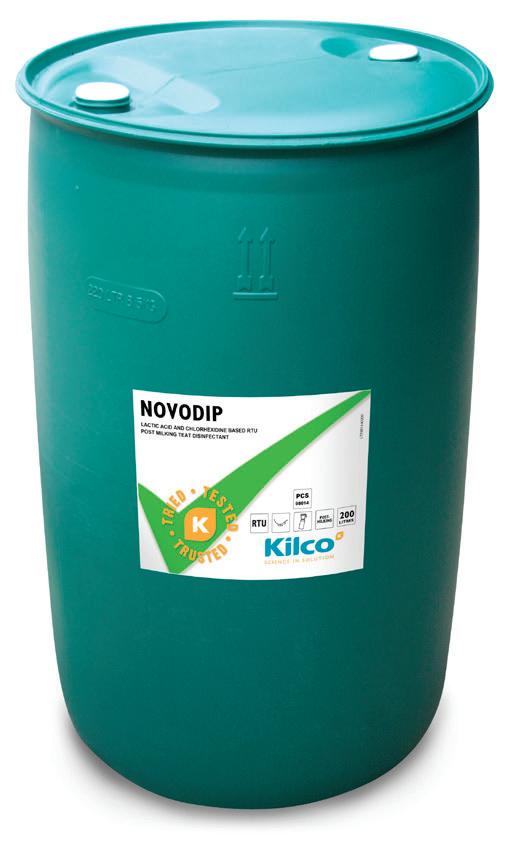


JANUARY 2024 47
NOVODIP
the QR code to learn more from the Kersia team AVAILABLE AS: 25L, 200L & l000L (IBC) T: 01576 205 480 E: enquiries.uk@kersia-group.com
Scan
By James Huyton
Utility vehicles (UTVs) have become a popular choice for many farms looking for more capacity over an ATV.
However, the burdensome drone of a diesel powered engine o en leaves considerable room for improvement in many vehicles.
Even manufacturers opting for petrol alternatives leave questions over fuel consumption and noise levels.
With the increasing cost of petrol and diesel, alongside environmental pressures, a ba ery-powered electric vehicle may provide a viable alternative in the UTV marketplace.
Polaris has developed an electric vehicle (EV) version of its popular Ranger UTV to o er that solution, on test we see if it can live up to the hype.
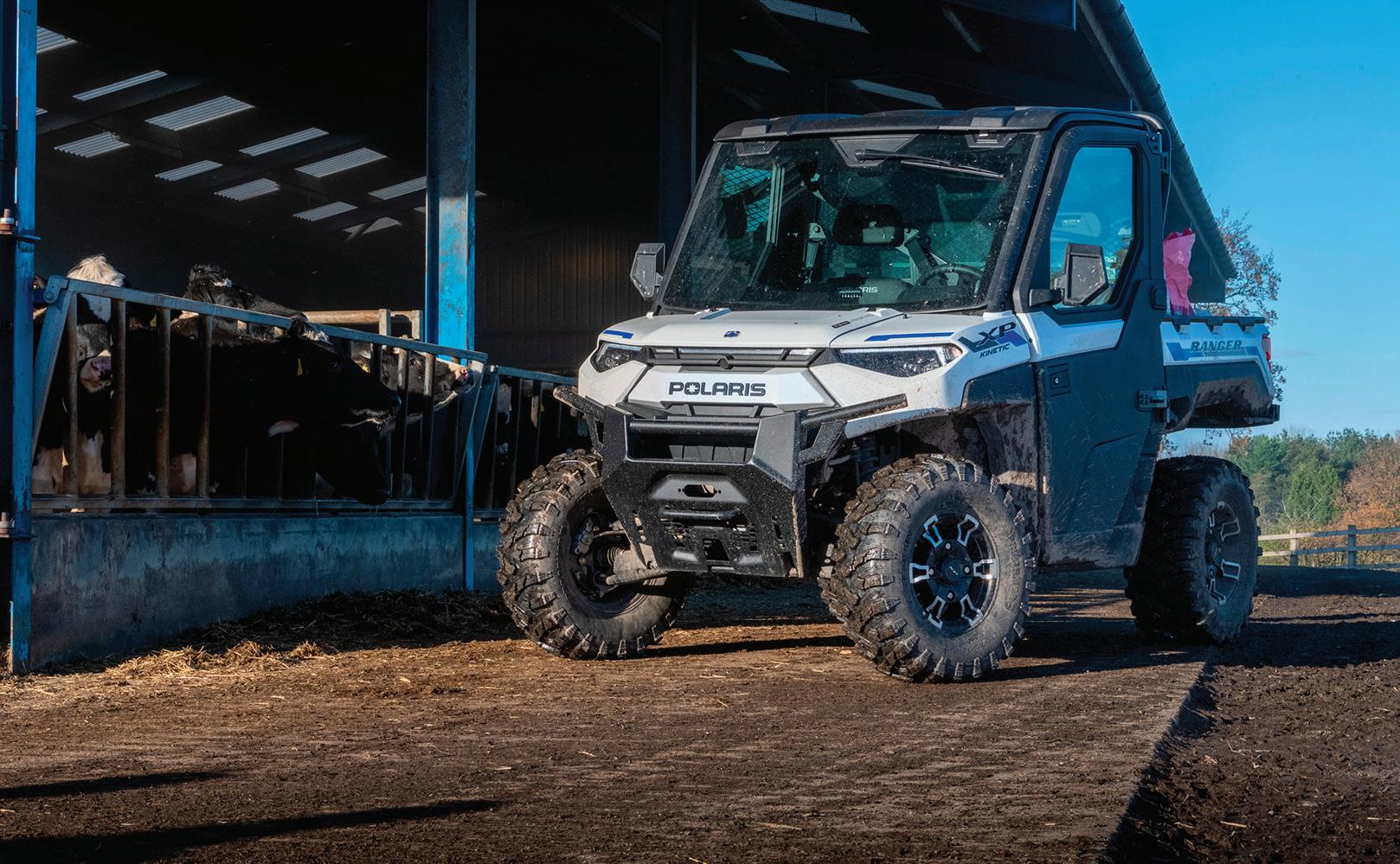
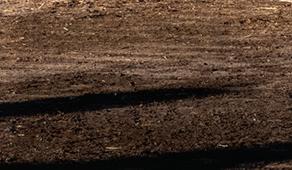
Silence is golden with the Polaris Ranger Kinetic
Motor and drivetrain
JProspective buyers can choose from two power options, with the test vehicle being in a premium format, offering 14.9kWh from an lithium-ion battery.
The higher specification ultimate variant is powered by a 29.8kWh lithium-ion battery.
The overriding performance
difference between the two vehicles is the manufacturer’s claimed travel range.
Polaris has opted for an in-house automotive style platform, with power delivered from the battery powering the drive motor, which in turn, powers the drive train via a toothed belt.
This removes the need for a continuously variable transmission in this particular variant, as with other electric vehicles, the rpm of the motor takes care of forward speed.
Three power modes can be selected via a rocker switch on the dashboard – sport, standard and eco-plus.


Exterior
JFrom the exterior, you would be forgiven for thinking the Kinetic is just another in a long line of diesel vehicles, with little change in body styling against the existing line-up.
But subtle changes in lighting and body colour indicate this is not your average UTV, with the Kinetic’s standard lighting package enhanced by LED strip lighting along the front grill.
The manufacturer has specified the unit with larger 29/9 R14 front tyres and 29/11 R14 rear tyres, giving the electric variant 25mm (oneinch) greater ground clearance as standard over its combustion engine counterparts.
A new chassis design has been formed to better incorporate battery and motor mounting. Effort has been made by the manufacturer to ensure sensitive components are well protected and the ingress of debris is kept to a minimum with moulded panelling.
JANUARY 2024 48 MACHINERY
The new Polaris Ranger Kinetic is a full electric UTV. PICTURES : Marcello Garbagnoli
The redesigned chassis neatly holds the battery and motor.
Cab
JUsers familiar with the existing Ranger lineup will feel at home in the Kinetic with little difference in fit, finish and trim.
Minor changes with gear selection now mean forward and reverse are selectable through an electric switch positioned on the gear lever.
From there, a choice of park, neutral and low/high range can be selected through the singular sliding lever –much the same as the petrol and diesel variants.
One of the most considerable changes to the dashboard, is the digital display now indicating battery load rather than a rpm tachometer and battery level rather than a fuel gauge. General cabin storage has remained plentiful, including stowage bins underneath the passenger seat.

Depending on the locality of the charging points, prospective buyers may wish to have a secondary charging cable or carry it permanently within the vehicle.
Supplied with a bag, the six-metre automotive-style charging cable can be neatly contained, but did make the optional under-seat storage box better suited to charging cable than general cabin storage.
Heating system
Operator comfort aside, the optional in-cabin heating system was seen as a missing necessity on-test, particularly when working in freezing temperatures.
Windscreen visibility soon became compromised by ice build-up, as no additional heat
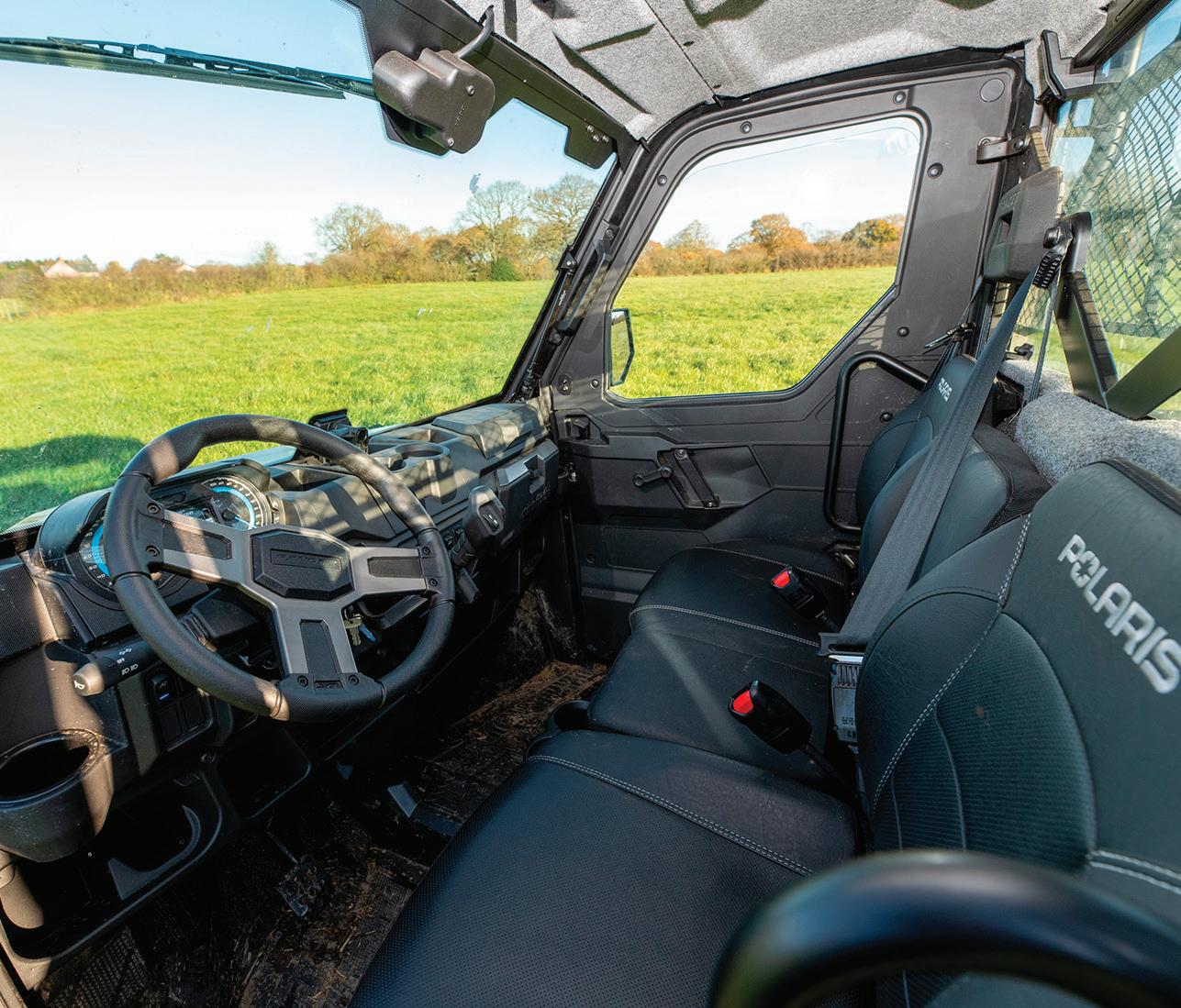

of the Kinetic was its quiet cab, barely reaching 41dB in the cab for general yard use. Road surfaces did give the inevitable tyre drone expected from the well-shod off-road tyres, which transferred to an 80dB reading travelling at 30mph, but considerably less on field surfaces at 64dB at equivalent was generated due to the lack of any combustion engine.
One of the major benefits
speeds. Notably, the tone of the road noise still made operator comfort on the road surfaces considerably better than combustion engine variants.
This allowed both operator and passenger to speak and hear normally in the cabin during operation.
Continues over the page...


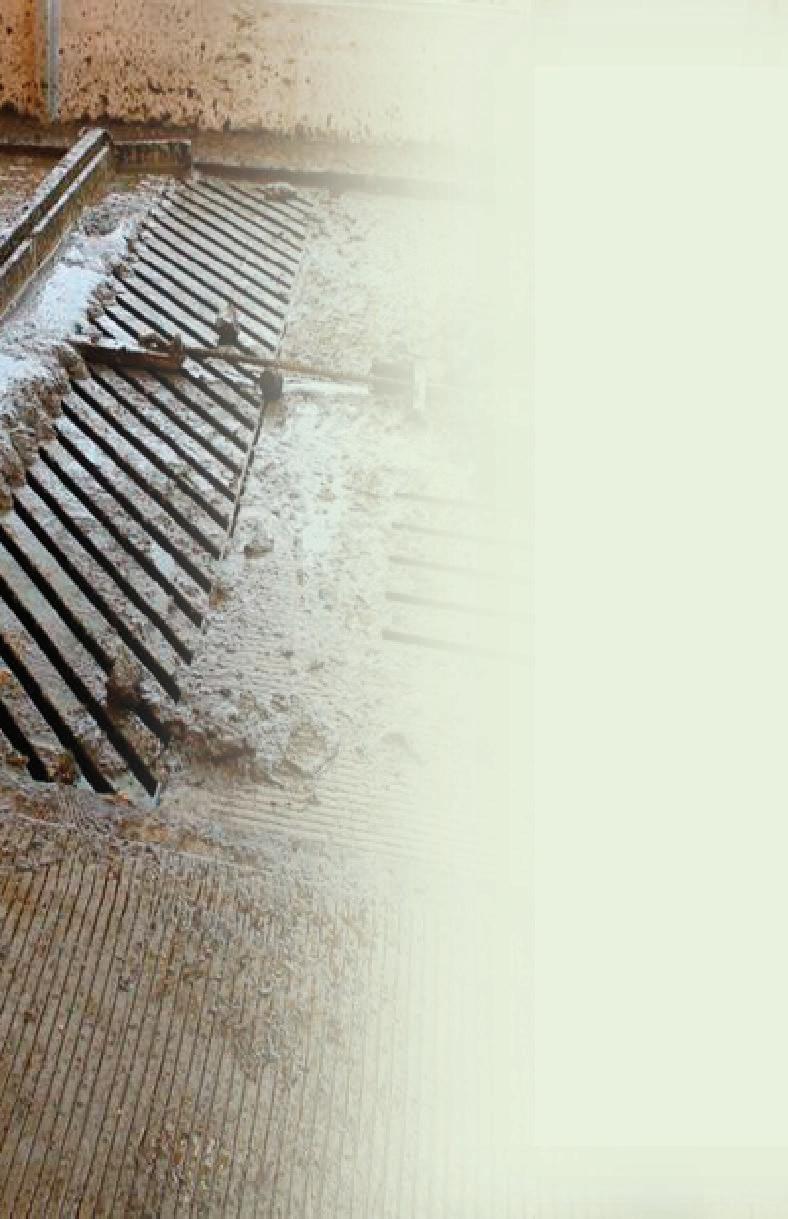


JANUARY 2024 49 Rope Scraper Key features of the Control System ✓ Future proof expandable up to 3 individual systems (6 winch)
Individual me clock and switching for each winch system
Selectable shunt program for robo c milking
Inbuilt bedding cycle Benefits of the Rope System Ideal for sand laden slurry Lowest cost replacement parts Rope replacement cost £3 per metre Easy touch screen control 5 years extended warranty available Manufacturing and installing rope scrapers for over 20 years Feature rich control Time control Winch control Cow care SYSTEMS Innovators in Dairy Farming Wales/Midlands/S. England Fred - 07762800149 N. Ireland/ R.O.I John - 07732348225 Scotland/N. England
Andrew - 07803124235 info@cowcaresystems.com
✓
✓
✓
07591833853
The vehicle has a familiar operator environment to users of existing petrol and diesel variants.
MACHINERY
Carrying and capacity
JExceeding the load bed carrying capacity of the manufacturer’s current offering, the Kinetic presents no compromise to prospective buyers.
Boasting a 567kg capacity, the Kinetic can carry 113kg more than the manufacturer’s existing platform.
Although the Ranger may not be required to carry such loads on a regular basis, for the purposes of the test, a 500kg bag of seed was transported around the test yard with ease.
Range and battery performance under varying conditions can be frequent concerns for many regular users considering the
switch from a combustion engine to an electric vehicle.
With that in mind, the Kinetic was loaded with 150kg in the load bed and with the operator and passenger taken on a 14.3-mile journey averaging 48kph (30mph).
During this it encountered mixed terrain, temperatures
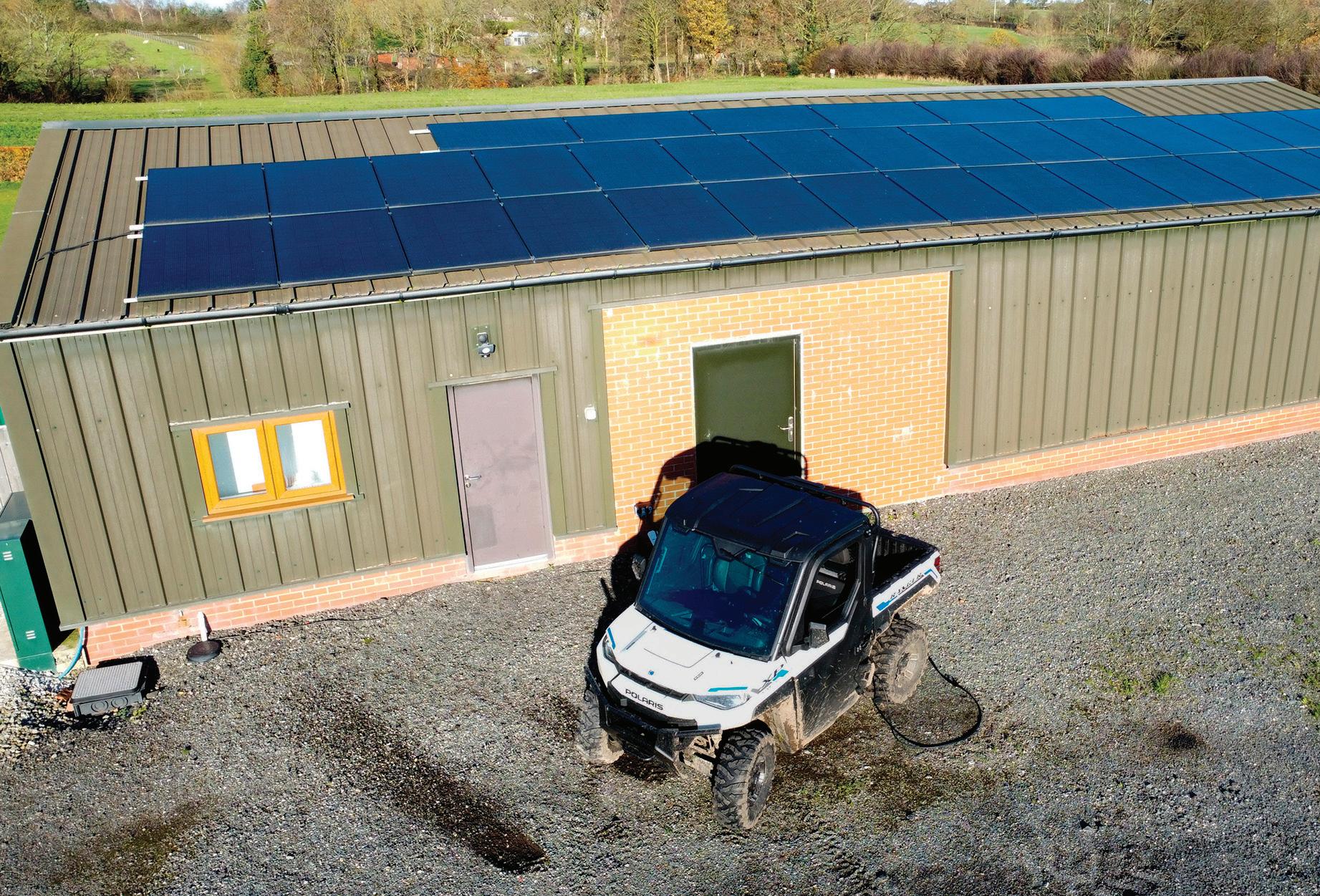
Our verdict
JMixed-use considerably extended battery longevity over continual high speed and load work, but it would be important to point out that regular users should consider their typical daily use.
As most vehicles may only encounter high-intensity usage for three to four hours a day, the rest of the time they traditionally would be idling or carrying out low-intensity duties.
Mindset change is certainly important when considering an electric UTV. Although daytime

It comes supplied with a six-metre automotive-style charger, optional fast chargers can reduce charge times from five hours to three hours.
of -4degC and a 12.4% incline during 1,000 metres of the journey.
Starting at 97% battery, the journey concluded with 55% battery remaining on standard performance mode.
This equated to a 0.54km (0.34-mile) usage per battery percentage consumed. In real-world terms, this would give the vehicle a comfortable 54km (34-mile) range based on the test parameters.
Notably during the test, the Kinetic did achieve the manufacturer’s estimated 72km (45-mile) range with a single operator and no cargo.
This was deemed ample for most daily activities, but users requiring greater range may wish to consider the Ultimate variant supplying a claimed 136km (85-mile) range.
Vehicle stability and ability to carry load during conditions remained consistent through the test, impressing with instant and continuous torque under load.
This was particularly recognisable during inclines carrying cargo, with an unyielding response to load.
charging was not deemed a necessity to get through the working day, it was a sensible option to do so at times of vehicle standing, to ensure ample capacity was available if needed.
With the test vehicle requiring a five-hour charge time from zero to 100%, higher capacity charging variants can offer reductions down to three-hour charge times.
Offered as a direct competitor to its petrol and diesel counterparts, the electric vehicle impresses on many levels, with reductions in noise levels and
improvements in operator comfort, as well as working in enclosed spaces with zero emissions emitted from the vehicle.
Battery
Power and performance matched and at times exceeded combustion engine counterparts, undoubtedly battery longevity in use may not suit the needs of some operators, but in those circumstances, the higher capacity battery would be a certain consideration.
Undoubtedly the Kinetic is a very capable vehicle often exceeding the performance of its combustion engine counterparts.
But with an on test price of £32,531.50 it has a considerable price difference over its petrol and diesel variants with prices hovering in the region of £25,000.
With this in mind prospective buyers would have to consider, whether the whole life running costs prove enough of a saving to justify the upfront cost.
JANUARY 2024 50
Handling and performance
JOn test, each drive mode was selected for various tasks.
The different modes gave the operator varying levels of throttle control and performance.
Light yard duties feeding youngstock and moving calves benefited from the lighter throttle response in eco-plus mode.
In towing and carrying weight across rough terrain, the standard mode offered the best performance in mixed duties.
Standard mode offered ample performance on road surfaces, but sport mode was the preferred choice on-test, giving the vehicle acceleration far beyond any diesel comparative.
The manufacturer claims an estimated range of 72km (45 miles) on the 14.9kWh variant.
Although considerable differences in battery longevity were noted in the different performance modes. Even with sport mode making a considerable dent in battery levels, with access to a full 100% of battery load, it still managed to achieve a 65km (40 miles) range on test.
Following existing Ranger sales trends, most farm users would opt for the non-homologated unit allowing operating speeds up to 96kph (60mph).
Homologation
With the on-test tractor unit having full road homologation, top speeds were limited to 64kph (40mph) which was deemed more than ample throughout the test.
Polaris incorporates a pin code secure limiter to both variants, allowing owners to limit



vehicle speed based on operator experience and the environment.
The dual A-arm suspension front and rear with anti-roll bars give the Kinetic a planted feel, which almost gives the UTV the feel of a car when cornering, with limited wallow and good
directional control when steering.
Suspension spring tension can be adjusted with a collar and sliding scale on the suspension arm, which allows changes to suit operation and weight on the load bed.
3

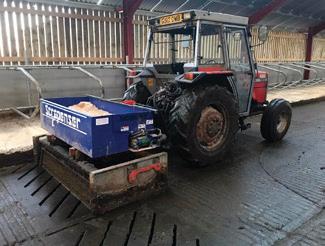













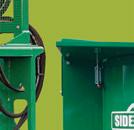











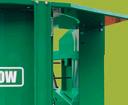

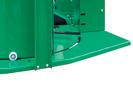

JANUARY 2024 51 VISIT OUR WEBSITE FOR MORE INFO WWW.SPREAD-A-BALE.COM Tube You FOLLOW US MADE IN GREAT BRITAIN Spread-a-Bale ® • No chopping, saves straw and lowers dust levels • Spreads any bale in under one minute • Self-loading, requires only one tractor / loader • Improves both efficiency and profitability Micro ST Spreading to left, right and front For calf hutches and buildings with narrow access doors and passageways from 2m wide M: 07904 899289 - Dave Bull M: 07903 012054 - Stuart Henry (Northern England & Scotland) T: 01244 394258 - Office E: sales@spread-a-bale.com 2024 STAND B84 NEW 1m 6-7m 1m 6-7m SPREAD PATTERN Sawdust Dispenser
out!
Time saving
two jobs in one trip 3 Fuel saving - always have your dispenser with your scraper 3 Low investment - scraper tractor does both jobs
Better husbandry for your cattle - spending more time in clean beds
Easy adoption - bolts onto you existing scraper
Retrofit to box or flip-over slurry scrapers With the Scrapenser, now you can spread sawdust into your cubicles while you scrape
3
-
3
3
Yes, it can spread both sides
892027 / 07866 775858
info@iancleasbyagri.co.uk
Scan the QR code to see the Scrapenser in action DEALER ENQUIRIES WELCOME
01768
•
www.iancleasbyagri.co.uk
Prices from £2,900
The Kinetic has a 113kg greater carrying capacity than its existing Ranger counterparts.
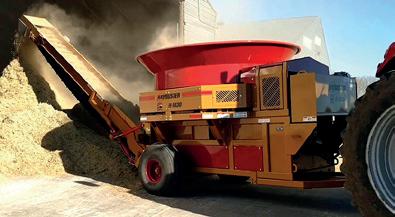


-
Root Choppers & Cleaners
- Loader, 3 point linkage, free standing PTO and electric drive available
- UK Distributor of VDW range of choppers, cleaners & feed dispensing equipment
- Output from 10t/hour to over 120t/hour available
Diet Feeders


- Largest stock of mixers in the UKover 50 machines in current stock
- Refurbished, used & nearly new units available
- New Mini Mixer available
- Diet feeder parts available- Blades, Conveyor belts, gearboxes, weigh cells.
- All feeders undergo 30 point service
- Finance available subject to terms
- Nationwide delivery available
MILKprices
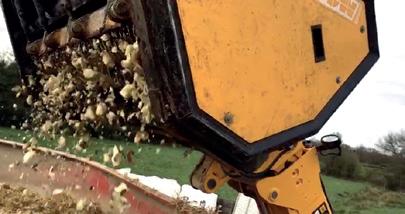
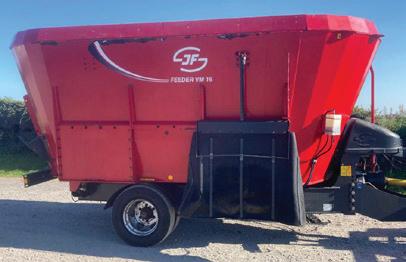

Current Used Stock:
- Trioliet 18, 20, 24
- Strautmann 10, 14 Duo
- BvL 12, 17, 20, 24
- Kongskilde 12, 16, 22 x 3
- Kuhn 12, 14, 27
- Keenan 320, 340
- Siloking 10, 14 x 4, 16, 18, 22
- Shelbourne 13 x 2
- Abbey 30
- Hi Spec 12
- Redrock 16, 20
- Keenan 320, 340
- VdW Mini mixer 2022
- Rotogrind 760 2018
- Haybuster H1000
- Teagle C12 tub grinder with grain processor, 2021


Milk prices start to ease upwards
JWhereas last month we were reporting a situation of increasing milk price stability, it is welcome news that some milk buyers have found themselves in a position to be able to increase milk prices either for December or the start of the New Year.
is is certainly a far cry from the picture being painted by the market back in summer.
While the recent autumn dairy commodity rally has done a great job in stopping the milk price rot, overall market demand is reported to be weak with li le clear signals to prove the contrary.
milk production remaining below last year, this is certainly helping to reinforce the picture of some stocks (especially on the fat side) running tighter. is combined is making buyers stop and think before trying to force prices lower.
Overall, the market situation could be described as fragile or hanging in the balance, especially while milk production sits the wrong side of spring next year.
In other words, the rally we have seen is not so much demand led rather more supply led and, with


For those producers who believe the small number of price increases to date are a prelude to what should be consistent across the board monthly increases over the next ve to six months, the market certainly needs to demonstrate be er levels of demand.


JAs Muller’s confirmation of a January price hold for its direct price pretty much sealed a ‘lock-in’ for most other liquid milk processor milk prices, it was down to a few cheesemakers to make some positive moves. Following its last price reduction of 4.75ppl back in May of this year, Leprino Foods increases by 1ppl for January, to take our manufacturing price up to 35ppl and by 0.97ppl to 33.83ppl (liquid standard). Saputo Dairy UK also
increased its Davidstow milk price by 1ppl, taking our manufacturing price up to 36.5ppl and by 0.96ppl to 35.2ppl on our liquid standard.
Barber’s Cheesemakers and Wyke Farms also increased their milk price for January, with increases of 1.04ppl and 1.14ppl to 37.18ppl and 37.25ppl, respectively, for our manufacturing standard.
Belton Farm also increases by 1ppl to 36.3ppl and Parkham Farms holds on 37.25ppl.
52
Cheesemakers turn positive on milk price JANUARY 2024 YOUR DEPENDABLE PARTNER FOR SLURRY STORAGE SOLUTIONS enquiries@enviroseal.co.uk t: 01695 228626 www.enviroseal.co.uk SLURRY LAGOON FLOATING COVERS Keeps rainwater out of slurry Reduces odour from lagoons Covers comply with EA and SSAFO legislation SLURRY LAGOON LINERS Comprehensive 25 year warranty Materials meet EA and SEPA requirements Installed and tested by certified technicians Enviroseal provide a complete range of products for slurry storage Feed Processing Specialists Please visit www.enegis.co.uk for more photos or call 01789 205132 or 07721 442979 Used Diet Feeders always wanted
Grinders
Exclusive UK Distributor of Haybuster & Rotogrind Grinders.
Range of models from
25t / hour output.
Tub
-
-
5t -
- New, used & refurbished machines available.
Ideal
for straw, hay, green waste, roots, biogas feeds etc.
Milk price analyst
Stephen Bradley on the latest milk industry developments.
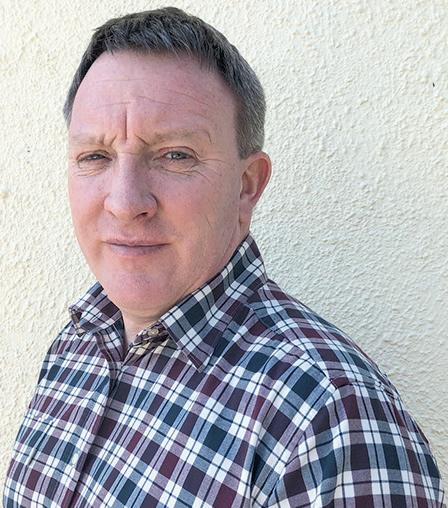
Arla Foods amba increase
JArla Foods increasing its on-account milk price for both conventional and organic milk by 1 euro cent/kg (0.86p/ kg) for December has helped with milk price consolidation.
The company reports that as global milk supplies continue to slow down, commodity markets on recovery and retail sales continuing to pick up after the turnaround in Q3, it sees the outlook is positive.
Price hold
The increase follows the company price hold for November and 0.09ppl increase for October to take our manufacturing standard litre* up 0.89ppl to 36.1ppl.
This price includes the guaranteed minimum supplementary payment
for the second half of the year (forecast 13th payment) holding unchanged on 1.29p/kg (1.329ppl), as well as the sustainability incentive of 1.417p/kg (1.46ppl).
End of year
This end of year price for 2023 compares with the company’s peak price of 52.24ppl paid for December last year and is 1.01ppl below the company’s five-year December average price of 37.17ppl.


Meadow adds 0.75ppl
JMeadow has increased its milk price across all its milk fields by 0.75ppl from the start of 2024. This is the first price move since the 1ppl reduction from
Our liquid standard litre* increases by 0.85ppl to 34.68ppl. This price including the sustainability incentive of 1.359p/kg (1.4ppl), as well as the guaranteed minimum supplementary payment remaining unchanged on 1.24p/kg (1.277ppl). October and takes our manufacturing price up to 34.38ppl, while our liquid standard moves up by the same amount to 33.75ppl.
* Our Liquid standard litre is 4%b/f & 3.3% protein, for our Manufacturing 4.2%b/f & 3.4% protein and in both cases Bactoscans of 30,000/ml & SCCs of 200,000/ml, with Thermodurics of 500/ml, 1mltrs/yr on EODC (max vehicle accessibility) based on level supply and therefore, before seasonality, (but includes the winter premiums paid in NI) as well as monthly profile adjustments, balancing charges, capital deductions or annual/part annual growth incentive schemes or supplements not directly linked to dairy market price movement.








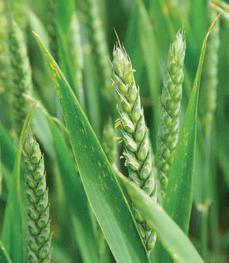
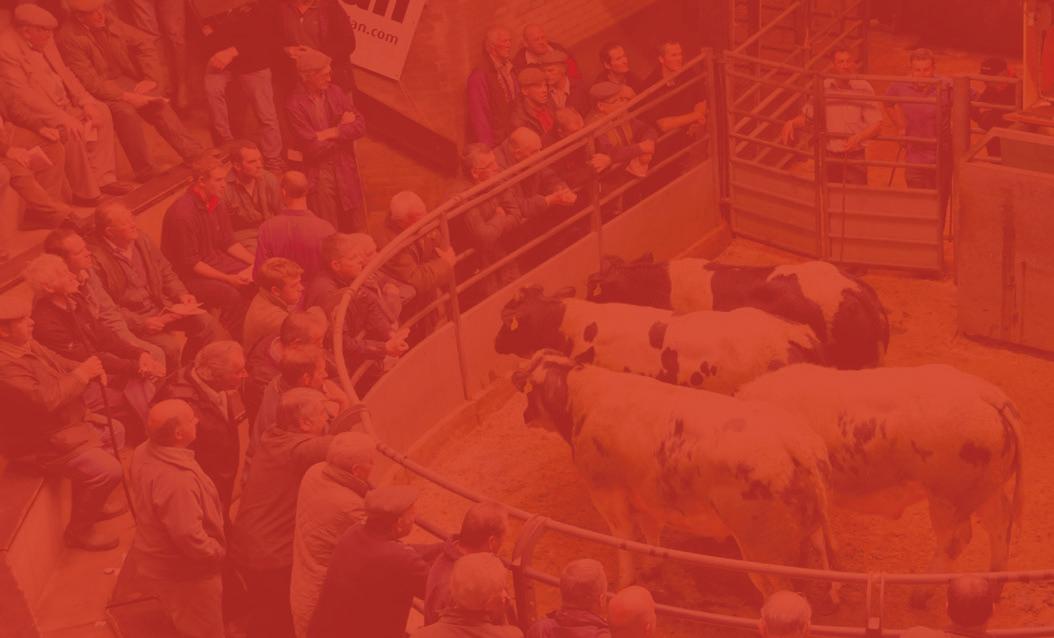


























53
JANUARY 2024
www.auctionfinder.co.uk Your one stop shop for all agricultural sales
Call us on 01258 817372 email: info@tractorsuk.co.uk TRACTORS UK SOLE UK IMPORTER OF TAFE TRACTORS FROM THE BEST PEDIGREE BASIC, SIMPLE & RELIABLE TRIED & TESTED FOR GENERATIONS 08R04B � Drum or oil immersed brakes � Roll bar or cab � 2wd or 4wd � 2 Years’ warranty
Comprehensive parts backup www.tractorsuk.co.uk ✆ 01258 817372 ✉ info@tractorsuk.co.uk BASIC, SIMPLE & RELIABLE www.tractorsuk.co.uk • • 2 Years’ warranty Comprehensive parts backup • • Oil immersed brakes 2WD or 4WD
Search by sale type, mart, auctioneer or region
�
Latest milk prices from
Notes to table
Prices for both Liquid & Manufacturing tables paid for a producer sending 1mltrs/yr on EODC (max vehicle size accessibility) with Bactoscans of 30,000/ml and SCC’s of 200,000/ml with Thermodurics of 500/ml. Excludes capital retentions or AHDB levies, profile adjustments from level supply, seasonality, balancing and A&B price schemes (includes the winter premiums paid in NI). Excludes annual / part annual growth incentive schemes or supplements not directly linked to dairy market price movement. Liquid price for milk contains 4% b/f and 3.3% protein. Manufacturing price for milk containing 4.2%/b/f and 3.4% prot. All prices for non-aligned prices are before monthly retail supplements. (i) Aug’23 prices before seasonality or B pricing (ii) Sept’23 prices before seasonality or B pricing (iii) Table ranked on simple rolling 12mth average of monthly prices Oct’22 to Sept’23). (i) v (ii) The difference Sept’23 compared with Aug’23. UK Arla Farmers hold for Aug & Sept’23 includes the 1.185ppkg Sustainability Incentive and forecast 13th payment of
testing and margin. (iv) Latest confirmed milk price at the time of going to press. UK Arla Farmers 0.09ppl increase from Oct’23 includes 1.359ppkg (1.400ppl) Sustainability Incentive and forecast 13th payment of 1.24ppkg (1.277ppl) based on our liquid std litre. UK Arla Farmers 0.09ppl increase for Oct’23 includes 1.417ppkg (1.460ppl) Sustainability Incentive and forecast 13th payment of 1.29ppkg (1.329ppl) based on our manufacturing std litre. UK Arla Farmers hold for Nov’23 includes 1.359ppkg (1.400ppl) Sustainability Incentive and forecast 13th payment of 1.24ppkg (1.277ppl) based on our liquid std litre. UK Arla Farmers hold for Nov’23 includes 1.417ppkg (1.460ppl) Sustainability Incentive and forecast 13th payment of 1.29ppkg (1.329ppl) based on our manufacturing std litre.
54
MILK PRICES
First Milk price includes 0.5ppl Member Premium accrued as a 13th payment paid Apr’24. First Milk Haverfordwest Tesco Cheese Group includes 2ppl retailer premium averaged as 1.5ppl based on seasonal profile. Fresh Milk Company price before Morrisons monthly cheese supplement (last payment made in Aug’23 of 0.011ppl for first half of 2023). MMG Direct price includes 1ppl Premium paid annually in arrears to Direct/Organic farms meeting specific Müller Direct criteria (Quarterly payments from Apr’22). Crediton Dairy price includes FarmMetrics Scheme Bonus of 0.5ppl paid monthly. South Caernarfon price includes flat 0.4ppl annual member bonus paid monthly. ‡ Price includes 12mth average rolling profile fixed at 0.57ppl. * UK Milk Futures Equivalent (UKMFE) net to producer includes 5% processor margin and allowing 2.44ppl
haulage Aug’23 and 2.45ppl for Sept’23 + milk testing. ** Ave delivered spot milk net to producer allows 3ppl covering haulage + milk
UK Arla Farmers 0.85ppl increase for Dec’23 includes 1.359ppkg (1.400ppl) Sustainability Incentive and forecast 13th payment of 1.24ppkg (1.277ppl) based on our liquid std litre. UK Arla Farmers 0.89ppl increase for Dec’23 includes 1.417ppkg (1.460ppl) Sustainability Incentive and forecast 13th payment of 1.29ppkg (1.329ppl) based on our manufacturing std litre. Dale Farm NI 2ppl Winter Premium paid for Oct, Nov & Dec. Direct Premium for Direct/Organic farms meeting specific Müller Direct criteria confirmed as 1ppl for 2023 and paid quarterly, Apr’23, Jul’23, Oct’23 & Jan’24. All prices are before any additional monthly retail supplements. Milkprices.com cannot take any responsibility for losses arising. Copyright: Milkprices.com Aug’23 Sept’23 12mth Diff Latest 4.0/3.3 4.0/3.3 Ave Sept’23 Confirmed Before Before Oct’22 v Milk Seas’lty Seas’lty Sept’23 Aug’23 Price LIQUID PRICES (4% b/f & 3.3% prot) (i) (ii) (iii) (i) v (ii) (iv) Müller Milk Group – M&S E&W 47.16 46.00 50.63 -1.16 44.80 Müller Milk Group – M&S Scotland & NI 47.16 45.74 50.61 -1.42 44.54 Müller Milk Group – Waitrose 45.30 45.30 48.21 N/C 44.05 Müller Milk Group – Tesco 41.83 41.83 44.97 N/C 41.73 Arla Foods – Tesco 41.58 41.58 44.72 N/C 41.48 Müller Milk Group – Sainsbury’s 40.76 40.55 44.29 -0.21 40.57 Arla Foods – Sainsbury’s 40.64 40.43 44.17 -0.21 40.45 Müller Milk Group – The Co-op Dairy Group 39.86 39.79 44.13 -0.07 39.60 Blackmore Vale Dairy 38.03 38.03 43.47 N/C 37.00 Müller Milk Group – Müller Direct 37.00 37.00 43.13 N/C 36.50 Crediton Dairy 37.00 37.00 43.08 N/C 37.00 UK Arla Farmers – Morrisons (Grazing) 35.36 35.36 43.03 N/C 36.30 Freshways 36.00 36.00 43.00 N/C 35.00 Müller Milk Group – Müller Direct (Scotland) 36.79 36.79 42.92 N/C 36.29 UK Arla Farmers – Tesco 35.16 35.16 42.83 N/C 36.10 UK Arla Farmers – Morrisons 35.13 35.13 42.80 N/C 36.07 Dale Farm GB (Kendal) 36.43 36.43 42.77 N/C 35.47 Yew Tree Dairy 36.00 36.00 42.58 N/C 36.00 Paynes Farms Dairies 36.00 36.00 42.33 N/C 35.00 UK Arla Farmers 33.74 33.74 41.42 N/C 34.68 Meadow Foods Lakes 34.00 34.00 40.79 N/C 33.75 Meadow Foods 34.00 34.00 40.79 N/C 33.75 Grahams Dairies 36.00 36.00 40.67 N/C 35.00 Dale Farm NI 31.43 31.43 39.39 N/C 33.45 Simple Average 38.01 37.89 43.61 -0.13 Simple Average (excl. retail contracts) 35.57 35.57 42.03 N/C MANUFACTURING PRICES (4.2% b/f & 3.4% prot) First Milk – Haverfordwest Tesco Cheese Group 38.35 38.35 45.19 N/C 37.50 Barber’s Cheesemakers 37.79 37.79 44.05 N/C 36.15 The Fresh Milk Company – Level Profile ‡ 37.51 37.51 43.92 N/C 35.96 Wyke Farms 37.77 37.77 43.90 N/C 37.25 Saputo Dairy UK – Davidstow 37.50 37.50 43.87 N/C 36.50 Wensleydale Dairy Products 36.96 36.79 43.76 -0.17 35.74 First Milk 36.85 36.85 43.69 N/C 36.00 Parkham Farms Tesco 37.25 37.25 43.42 N/C 37.25 The Fresh Milk Company (Lactalis) 36.94 36.94 43.35 N/C 35.39 UK Arla Farmers 35.12 35.12 43.10 N/C 36.10 Belton Farm 37.05 37.05 42.72 N/C 36.30 South Caernarfon 35.50 34.75 42.50 -0.75 34.00 Arla Foods – Direct Manufacturing 32.67 32.67 41.86 N/C 33.47 Leprino Foods (formerly Glanbia Cheese) 34.00 34.00 41.35 N/C 35.00 Dale Farm NI 32.42 32.42 40.33 N/C 34.42 Simple Average 36.25 36.18 43.13 -0.06 Simple Average (excl. retail contracts) 36.01 35.94 42.95 -0.07 ‘B’ Price Indicators StoneXMilkprices.com UKMFE (gross) 31.51 31.55 36.09 0.04 *StoneXMilkprices.com UKMFE (net) 27.50 27.52 31.75 0.02 **Delivered spot milk (net to the producer) 33.62 31.69 -1.93
1.24ppkg (1.277ppl) based on our liquid std litre. UK Arla Farmers hold for Aug & Sept’23 includes the 1.236ppkg Sustainability Incentive and forecast 13th payment of 1.29ppkg (1.329ppl) based on our manufacturing std litre.
ex-farm
JANUARY 2024




LET THE COMMENCE



The UK’s first Farming Simulator League is coming to LAMMA 2024
8 teams will battle it out to win a prize pot of 15,000€

DO YOU HAVE WHAT IT TAKES?
Scan the QR code (bottom right) to register for the UK Farming Simulator League




BE PART OF THE ACTION!














Scan the QR code to register for your FREE LAMMA 2024 ticket.


Find out more at LAMMAShow.com/farming-simulator-league












ENTER HERE
The climate in the barn is the key!


THE SOLUTION: ABBIFAN 140-XXP-2
The latest motor technology now applied on our fans! Direct drive.
DC-permanent magnetic motor
40-70% energy savings
No frequency control needed
No motor protection switch needed
No special wiring needed
Mains: 230/400V 50Hz

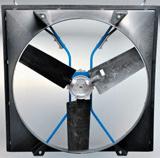
CROSS VENTILATION blows fresh outside air in your barn!
Simpler installation
Less electric wiring
No obstacles inside
No restlessness when doing maintenance
Shorter suspension of the fans
Lower total investment
Airflow in length of cubicles
www.abbi-aerotech.com
www.rumitechs.co.uk
Ph: 07714 846987 HEATSTRESS?
Prices lift on rising tide of sentiment, but will it last?
First the good news – several processors have lifted their milk prices for December or January (and for November in the case of Northern Ireland, which prices retrospectively).
So far six processors have increased for January, with five of them being cheesemakers – Wyke, Saputo, Barber’s, Belton and Leprino. Meadow also increased, with Arla doing so for December.
In Northern Ireland, all of
Difference between start and end prices each year
the major processors increased for November, but from a very low sub-30p base for most.
The increases take the average non-aligned price, weighted for processor milk volumes, to a fraction below 35p, which rises above it if Northern Ireland prices are taken out.
With the final prices in for December, it can be seen that prices dropped by 27% from the start of the year to the end, representing the biggest drop on record, but this follows the 2022 milk year, which saw prices rise by the biggest amount – 44%.
EU prices take a pause as concerns remain for Q1
JMuch of the buying has been done for Q1, and that, plus the fact that demand is never particularly good at this time of year – especially on cheese – means that market sentiment has weakened in the last few weeks.
Demand is still lacklustre and buyers do not seem worried about volumes as they are rising towards the flush.
Cream and butter prices slipped towards Christmas, although shortages of butter and decent demand mean the UK market was not as bad as on the continent.
EU spot bids for butter were coming in a low price of €4,900 (£4,224), which will definitely not keep the milk flowing.
A more balanced price, including contracted sales, puts the price at €5,400 (£4,655).
In the UK, traders say it is at £4,700-£4,750, although bids are starting to come in lower.
Salted butter is still in extremely short supply though, and stocks of any type are said to be tight for Q1, so some sellers are expecting January to be quite stable.
UK cream prices are also firmer than in the EU, with tight availability. Most traders said
the price was £2.08-£2.10 in mid-December, with prices dropping into the £1.80 zone for Christmas to New Year.
With SMP as low as £2,225, the farmgate equivalent is less than 35p, having dropped from a recent peak of more than 35p. The average price over the year was just more than 30p on an AMPE basis.
EU butter and SMP prices in AMPE (ppl)
Note: AMPE after transport, processor margin and cost allowance
JANUARY 2024 56 MILK ANALYSIS
NEW! NEW!
No maintenance
Jan Dec Diff Diff (%) 2018 30.23 29.65 -0.58 -1.91 2019 28.65 27.18 -1.46 -5.11 2020 25.72 27.36 1.64 6.38 2021 27.75 31.02 3.27 11.78 2022 32.92 47.31 14.38 43.69 2023 47.84 34.75 -13.10 -27.37 2024 34.96
Jan 23 Jan Feb Feb Mar Mar Mar Apr Apr May May Jun Jun Jul Jul Aug Aug Aug Sep Sep Oct Oct Nov Nov Dec Average 40 38 36 34 32 30 28 26 24 22 20

Prices in 2023 dropped by 27% from the start of the year to the end – the biggest drop on record.

Are you fed up with manual foot bathing

EU futures dip
JThe futures rallied in the last trading week of December, after a crash at the end of November and the first week of December.
EU butter increased by €120 (£103) to take the price at the year-end to more than €5,500 (£4,741), but it was still €240 (£207) down on a month ago.
New Zealand butter gained €70 (£60), but it was still €600 (£517) less than EU prices. This gap is too wide and either the EU will lift New Zealand prices or New Zealand will pull the EU’s down.
EU SMP increased €20 (£17) to €2,665 (£2,297), but this was still €100 (£86) down on November’s prices.
In milk price terms, the futures convert into a price of 33.5p for December, but increase to 35.5p for May.

JANUARY 2024 57 MILK ANALYSIS Autoflush Footbath Benefits of the Autoflush Footbath Improved animal health Suitable for all chemicals Increases the herd performance Minimises contact with chemical Reduced labour costs Reduced water consumption Efficient cleaning Cowcare SYSTEMS Features
positions: (left, right or centre) Standard length: 2 or 3 meter Non-slip flooring One Touch system programming Heavy-duty stainless steel construction For a no obligation quote or more information Wales/Midlands/S. England N.Ireland/ R.O.I John - 07732348225 Scotland/N. England 07591833853 Fred - 07762800149Andrew - 07803124235 info@cowcaresystems.com ✓ ✓ ✓ ✓ ✓
Pump
REDUCE RATES OF LAMENESS TODAY!
?
Innovators in Dairy Farming
D o you hate working with chemical ?
NEWProducts
This month, we feature a new bovine coronavirus vaccine, the latest disinfectant formulation from DeLaval, a transition calf milk powder and the launch of a new mycotoxin mitigation technology from Agriking.
New fertiliser formulation from OCI Global
JA new fertiliser called Dynamon, with nitrogen and sulphur has been launched by OCI Global.
The new formulation has been developed to improve nitrogen use, efficiency and result in higher crop yields and quality.
Suitability
The product contains 24% nitrogen and 7% sulphur and is suitable for all agricultural crops.
The addition of sulphur into the product’s composition helps to optimise nitrogen use efficiency and ensures nutrition is available in the most effective way.
rMore information from meg@pinstone.co.uk, or 07747 452 061.
Got a new product?
JNew products are featured in each issue of Dairy Farmer. Please send details and pictures to Katie Fallon at katie.fallon@ agriconnect.com, or call 07815 003 227.
Bovine coronavirus vaccine
MSD Animal Health UK has launched a new vaccine for bovine coronavirus to improve the control of bovine respiratory disease (BRD).
Bovilis Nasalgen-C is an intranasal live vaccine which can be used for the active immunisation of calves from birth to reduce clinical signs of upper respiratory tract disease and nasal viral shedding from infection with bovine coronavirus.
e new vaccine will allow farmers to administer protection for young calves via a single 2ml intranasal dose which can quickly reach the site of action.
is will support the development of immunity against bovine coronavirus early in life, the onset of which starts ve days a er administration and has a 12-week duration.
e vaccine comes with administration exibility and can be used on the same day with Bovilis INtranasal RSP


Live, stored for up to 24 hours at room temperature a er reconstitution, given to ca le using a syringe or applicator device and is available in one-,
Mycotoxin mitigator
JA new mycotoxin mitigation technology which not only binds but destroys the mycotoxin has been launched by Agriking.
Called AKMC, the nutritional supplement uses new enzyme technology and
has been formulated with antioxidants, vitamins and trace elements to enhance the total ration and maximise herd performance potential.
The product is said to be a straightforward way to capture the nutritional value of this
ve- and 20-dose packs, suitable for both small and large herds.
rMore information from ploy.radford@msd.com, or 07890 916 752.
season’s maize and cereal silages which have suffered from harvesting conditions, resulting in an exceptional toxin challenge.
rMore information from Grace@agriking.co.uk, or 07974 678 833.
58
JANUARY 2024
Transition calf milk
JA new calf milk powder specifically designed for the transition from colostrum to powered milk feeding has been introduced by Britmilk.
With the ability to also be fed through the entire milk feeding period for maximum performance, Calf Defender is an energised skim-based calf milk replacer containing 100% all milk protein with low osmolality.
Oils and fats are fully homogenised, with each fat molecule less than two microns in diameter and encapsulated with milk solids for maximum digestibility. Suitable for bucket feeding and most automatic feeders which do not require a free-flowing powder.
The powder contains high levels of functional proteins, including egg powder, which the company says lines the
Teat disinfectant
JDeLaval has expanded its udder health range with two new teat disinfectants containing glycolic acid in a unique GlyTec formulation.
The new formulation can reduce somatic cell counts and the threat of mastitis, while also improving udder skin condition.
The OceanBlu range includes a spray and a barrier which offer protection to dairy units using any type of milking equipment. Both products have a vivid blue colour to visually show which

calf’s gut to help prevent harmful organisms and viruses from attaching to the gut lining and causing damage.
Calves can be fed Calf Defender from 10 days old to weaning age, at a quantity of two-and-a-half to three litres per feed, depending on the performance required.
rMore information from info@britmilk.co.uk, or 07860 416 590.

cows have been sprayed and dipped. The spray is a multi-purpose product which can be sprayed before and after milking and can also be foamed pre-milking during the udder preparation routine.
The products have been designed to be used with automated systems, but the spray can also be applied using a handheld spray bottle and the teat dip can also be manually applied.
rMore information from lisa.harris@delaval.com or tom@abccomms.co.uk




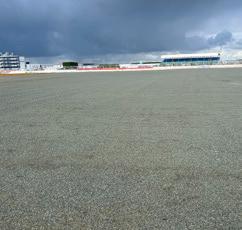

• Specialists in earthworks and stabilisation.
• Lime and Cement Stabilisation • Earthworks • Drainage
• Reservoir and Pond Construction • 3D Site models
• Surveys for level design, Cut and Fill works.
• Road and track construction, Regrading and reclamation.
With ever increasing costs, Cement stabilisation provides a cost efficient alternative to Concrete for Roads, Tracks, Yards, Cow Tracks, and more. All provided with a full design and Professional Indemnity cover.
35 years experience Passion creates progress
Nationwide coverage
All enquiries welcome • Telephone





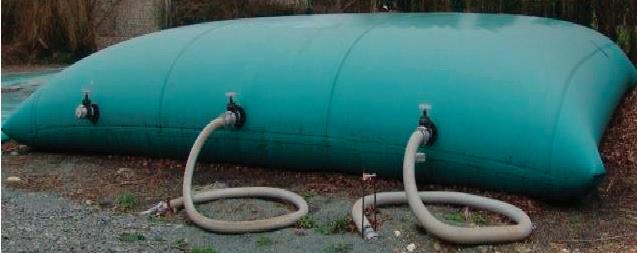
59
info@pfc-eu.com
(0) 1805 603 363
NEW PRODUCTS
www.pfc-eu.com +44
Slurry bags are an important piece of the sustainable agriculture puzzle. By investing in solutions that are energy e cient, e ective and long-lasting, we can help ensure a better future for generations to come. Whether used to store and transport liquids, fertilisers or other materials, slurry bags o er the potential to reduce environmental impacts while remaining cost-e ective in the long run. Securing a Sustainable Future
JANUARY 2024
07875 299669 02476 395209 • Email agriplantsolutionsltd@live.co.uk














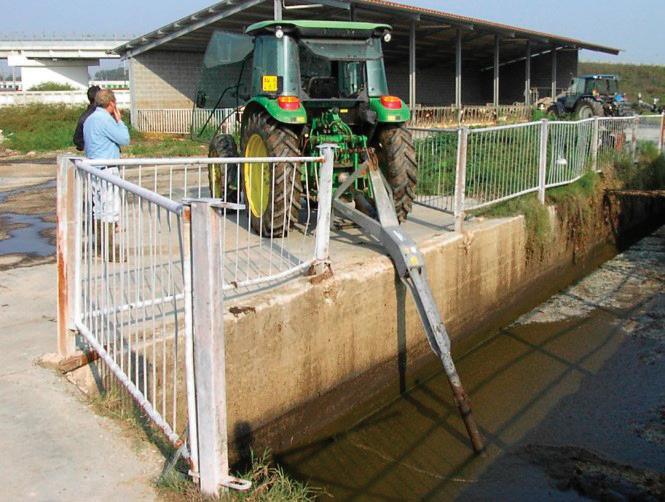

Equipment & Accessories SEPCOM The unique separator Slurry pumps & lagoon mixers 01328 701992 | enquiries@greencrop.co.uk | www.greencrop.co.uk Multicam dirty water irrigator Slurry pump Pump in a box CLASSIFIED TELEPHONE: 01772 799400 Livestock Services FARM HEALTH SOLUTIONS Ask about Herd Health Analysis T . 01756 749444 W . www.crossgateshealth.co.uk APPLE CIDER VINEGAR (ACV) - ACTS AS A RUMEN TONIC - IMPROVES BUTTER FAT AND MILK PRODUCTION - ACV ACTS AS A FANTASTIC IMMUNE ENHANCER - REDUCES HIGH CELL COUNTS - PREVENTS MASTITIS Nationwide (01948) 662910/663143 george@greenfieldsrise.f9.co.uk Building Services Professional Services JANUARY 2024 60 WELL ESTABLISHED AND PROFITABLE CONCRETE GROOVING BUSINESS OVER THIRTY YEARS. With a nationwide client base, including farms, markets, show grounds, institutional government organisations; having earned a fine reputation for quality and service. Possible to run from any location, an exciting opportunity to expand the business for an existing agricultural contractor or those looking to run their own business. Existing and ongoing order book. For sale as a going concern For further details contact Anthony Mosley Tel (01822) 833 204 CLASSIFIED TELEPHONE: 01772 799400 SPRAY FOAM INSULATION To Crop & Livestock Stores, Poultry Sheds, Cattle & Pig Buildings, Workshops & Barns. Frost & Condensation Protection. Temperature Control Energy Saving Tel: 01405 812682 www.webstersinsulation.com info@webstersinsulation.com


















61 JANUARY 2024 Published February 16, 2024 Advertising opportunities now available in our Forthcoming Events 69 DECEMBER 2023 Livestock Services FARM HEALTH SOLUTIONS Ask about Herd Health Analysis T . 01756 749444 W . www.crossgateshealth.co.uk APPLE CIDER VINEGAR (ACV) - ACTS AS A RUMEN TONIC -IMPROVES BUTTER FAT AND MILK PRODUCTION -ACV ACTS AS A FANTASTIC IMMUNE ENHANCER -REDUCES HIGH CELL COUNTS - PREVENTS MASTITIS Nationwide (01948) 662910/663143 george@greenfieldsrise.f9.co.uk CALF DEFENDER is an energised Calf Milk with anextensive package of health promoting ingredients tostimulate the immune system and promote a health gut. For further information contact Speak to Katie Robinson today and start converting our readers to your customers. 01772 799500 | fgclassified@farmersguardian.com Published February 16, 2024 Advertising opportunities now available in our DAIRY SUPPLEMENT Dairy Tel +44 (0)1387 750459 E: info@britmilk co uk | W: www britmilk co uk Calf Jacket Calf Jacket BRITMILK “Qu alit y wit h ou t Comp romis e” f rom • Quality breathable/ water repellent materials to maintain body heat • Strong metal buckles for Longer life • Crossover straps for secure fit • Machine washable
‘It isn’t the diagnosis that’s the problem, it’s access to the drugs’
This month, Roger Evans regales us with his experiences of trying to make a doctors appointment, and the importance of having the right diagnosis from mechanics.
One of the most important words in our vocabulary is the word ‘diagnosis’ and the most important diagnosis of all comes from our doctors.
I don’t go to the doctors very often.
There are said to be six doctors in the practice we use, but I only know the name of one of them.
Years ago our doctors lived locally and we were on first name terms with all of them.
It’s quite difficult to get to see a doctor, our family have never bothered the doctors much and you would think that they would take that into account when you need to see one.
A couple of years ago, I phoned up and tried to make an appointment. You have to phone at 8 o’clock to get through.
The conversation went something like this:
Receptionist: “Which doctor do you want to see”.
Me “Not bothered.”
Receptionist: “The first appointment I can offer you is Friday next week.”
Me: “That’s fine, it isn’t urgent I’ll come then.”
Receptionist: “It doesn’t work like that, you have to phone every day to see if that’s still OK.”
Me: “But I’ve got this thing called a diary and if you tell me a time and a date, I’ll write it down.”
Sarcasm
The receptionist is now very wary, she can spot sarcasm, and she says: “I’ve got another call waiting,” and she goes.
If you finally get an appointment you rarely get to see the doctor, you get a nurse.
And if the issue you have is beyond the nurse’s pay grade, they go off to ask a doctor that you never see. Such is progress.
The next important diagnosis is that from our vets. Dairy farmers are quite good at diagnosis. When was the last time you phoned the vet for a visit and you said you didn’t know what was wrong with the animal? Bet you can’t remember.
It isn’t the diagnosis that’s the problem, it’s the access to the drugs.
I know some farmers who are married to vets.
To me, this would be a match made in heaven. I’ve always wondered if they leave their car boots unlocked.
To my mind the next important diagnosis comes from the people who look after our kit.
Some of the labour charges on the invoices we receive are eye-watering. Bet you all wished you earned that sort of money from farming.
This is a very old story, but it goes a long way to illustrating what I mean.
I had a nagging worry about a car I had, I don’t mind driving old cars, but I can’t do with unreliability. So I took it to a local mechanic who recommended a job that I knew would cost four figures.
That didn’t sound quite right so I took it to another garage.
They recommended a completely different job, but one that was equally expensive.
I knew both men quite well and knew them to be honest. They both could be right, but then again, they both could be wrong. So I phoned the man I bought the car off, he lives about 60 miles away so I never used him on mechanical issues, but he was brilliant on diagnosis.
I’m no mechanic, but I described what I thought was wrong. He said: “Okay I can easily fix that, next time you are anywhere near, I will meet you and take it home.”
I asked how much it would cost, and he replied
GOODEvans
62 JANUARY 2024

“ Marry a vet whose father is a doctor and who has a patient who is a good mechanic.
I could buy him a drink. I never discovered what he drank, but apparently it was £50 a glass.
Anyway, a week later I met him in a layby.
Over the years he had lent me lots of cars, from big Jags to motorhomes and everything you can think of in between.
I don’t know if any of them had an MOT or insurance and I never asked.
He was waiting for me, which was good, and he was in a big Volvo car which was also good. is Volvo had the unmistakable plates that said it was of Irish origin, which was not so good.
I think the rear plate was red.
is was at the height of the I ’s bombing campaign and everyone was nervous and trigger-happy


(I told you it was an old story). As luck would have it, a bomb had gone o that day and I drove within ve miles of where it went o .
You can’t really keep your head down when you are driving, but to my amazement I wasn’t stopped.
I took the Volvo back. I try not to think about what could have happened, but if I do, a wrong diagnosis that could have cost four gures doesn’t seem so bad.
To be fair, I kept that car another two years and never had any trouble with it.
So what’s the answer?
Marry a vet whose father is a doctor and who has a patient who is a good mechanic. Simple.




Find your next career move Get the latest jobs in your inbox with our free email alert service and never miss a great job! Scan the QR code or visit: JobsInAgriculture.com 63 JANUARY 2024
Simple
There are more dairy farms for sale, but the market is certainly not over-supplied and there are still keen buyers, despite higher interest rates. Cedric Porter reports.
Dairy land market still strong
Anecdotally, there have been more farms on the market, says Will Whi aker, director in Stru and Parker’s national estates and farm agency department.
For example, he says there have been a number of 60- to 120-hectare (150- to 300-acre) farms marketed in South Cheshire and North Shropshire.
Stru and Parker’s analysis of the overall English farmland market showed that 26,547ha (65,600 acres) of land was sold in the rst nine months of 2023, which was 9% more than the ve-year average, although still historically low.
Mr Whi aker says: “Margins are being squeezed, which means some
producers are questioning their future in dairying.
“However, lack of successors is still the primary reason for farmers deciding to sell, especially among those who would need to invest in new systems if they were to carry on, and that is what we have seen recently.”
He reported there are still buyers for land which comes on to the market, with purchases being driven by larger dairy businesses looking to expand their operations and some lifestyle buyers.
Stru and Parker estimates that of the land sales across England last year, 40% have been from traditional farming buyers, which compares to 50-60% historically.
e property consultancy


says: “We have seen prices of up to £16,000/acre for exceptional dairy land which appeals to a number of buyers, although most transactions are in the range of £8,000-£12,000/acre.
West Midlands
“
ere is also some demand from arable farmers for dairy land in the West Midlands, which is supporting the market. Although a lot is spoken about land being sold for carbon sequestration or to meet biodiversity net gain targets, we are yet to see that making a di erence in the dairy farmland market.”
In Scotland last year, there has not been a large volume of dairy farms coming on to the market. However, there has been a regular supply of acres to the market, according to Sian Houston, rural agency director at Savills’ Dumfries o ce.
Savills estimates there was a 7% increase in Sco ish acres of all types at 9,308ha (23,000 acres) in the rst nine months of 2023, compared to the same period in 2022.
Ms Houston says: “Most dairy farms which come on to the market are those in need of reinvestment in the dairy infrastructure, which is o en one of the reasons they are being sold. It is rare for farms with modern dairy setups to come on to the market.
“
ere are regional di erences in demand and prices. For example,
farms in areas where there are a number of milk buyers are inevitably more sought a er than those where there is only one player in the market.”
Ms Houston says established Sco ish dairy farm buyers are having to compete with those from outwith Scotland. For example, Northern Ireland, England and even some interest from the Netherlands.
High land prices there, as well as environmental restrictions on production, mean buyers from those countries are looking further a eld. e average price of Dutch dairy (equipped) farmland in 2021 was €62,800/ha (£53,400/ ha or £21,600/acre), compared to £19,770-£29,650/ha (£8,000£12,000/acre) in Scotland.
Wales saw a 46% increase in farmland sales to 5,260ha (13,000 acres) in the rst nine months of 2023, according to Savills. Dairy farms are particularly sought a er.
Rural agency director Daniel Rees says: “Current sellers are o en retirees with no successors and if this trend continues there will be more land o ered for sale.
“Furthermore, rising input costs could a ect decisions, as everyone is waiting on the economy. But my long-term view is that values will keep rising on the back of steady supply and continued interest.”
Rising interest rates have inevitably impacted on farmland, as well
JANUARY 2024 64 BUSINESS CLINIC
Bank of England percentage base rate 2020 2021 2022 2023 6 5 4 3 2 1 0 SOURCE : Bank of England
Strutt and Parker’s analysis of the overall English farmland market showed that 26,547 hectares (65,600 acres) of land was sold in the first nine months of 2023.

as other property markets, with the jump in base rates from 0.1% at the end of 2021 to 5.25% now.
Rates have not changed since August and there is an agreement that they will not rise so fast as they have done, but people should not expect a fall anytime soon.
e latest Bank of England Monetary Policy report said base rates were expected to remain at about 5.25% until the second half of 2024 and then slowly fall to 4.25% by the end of 2026.
Funding
Martin Waite is a business development consultant with Ashbridge Partners, a nance advisory business which specialises in funding for farms and estates.
He says: “ e rise in interest rates, along with the fall in milk prices, has inevitably had an impact on the market, with land prices easing but certainly not tumbling.
“Higher rates have made investment plans una ordable for some, but when we do see dairy farmers give up, for whatever reason, there are still buyers out here.”
He has seen an increased interest in farmers selling or developing some assets, such as barns or yards which are not vital to the running of the main farming operation, with
strong demand in the right location for industrial units.
Mr Waite urges those buying or selling farmland to get good advice and develop plans which either maximise the value of a property being sold or gives a buyer the greatest opportunity to secure the property they want at the best possible price.
He says the hurdle to securing
Current sellers are often retirees with no successors and if this trend continues there will be more land offered for sale
DANIEL REES




nance can be higher than it was in the past and not just because of higher interest rates.
He says: “Farmers who are borrowing can fall foul of automated borrowing checks by banks or a lack of farming experience and knowledge among bank sta , so understanding how to present the best case and convince a lender to fund your borrowing is very important.”
Mr Waite says farmers borrowing money should view it as another input cost which helps the business operate.
He says: “We get farmers who are very keen to pay o a loan over a very short period, so it is not hanging over them or their successors.
“But xing it over a longer period or even borrowing on an interest-only basis might make the loan more a ordable or make more business sense. Currently, two-year xed loans have higher interest rates than longer ones, because lenders believe borrowing costs will fall over the long-term.”
Farmers Guardian delivered directly to your door every week including full digital access. Plus, check out our brand-new features exclusive to Farm Futures members. A one membershipyear is only £289







Insight – Quarterly, in-depth, analytical reports into the latest agricultural trends to optimise your farming practices Exchange – A series of digital events focused on learning from real case studies and exchanging knowledge with agricultural thought leaders Weekly Digest email – From the desk of FG’s editor every Sunday morning, discover exclusive insights which impact the business of profitable farming Members’ Lounge – Enjoy an exclusive space for members to network at leading events, such as LAMMA, CropTec, Future Farming Expo Scotland and Farm Business Innovation. Included in your membership:



JANUARY 2024 65 BUSINESS CLINIC
Become an FG Farm Futures member today Visit farmersguardian.com/membership Call 0330 333 0056 and quote H302
Future-proof your farm business, gain insight and exchange knowledge with a Farmers Guardian Farm Futures membership.
Different rates of slurry and artificial fertiliser have been trialled by dairy farmer John Kerr to see how yields can be optimised and costs reduced. Dairy Farmer reports.
Slurry trials help inform decisions
With input prices remaining high, John Kerr, of Woodhead Farm, Ayrshire, wanted to see if he could maximise use of the slurry from his 180-head dairy herd to improve soil health and grass growth, which would at the same time help reduce his carbon footprint.
Mr Kerr, who farms 141 hectares (348 acres) of predominantly grass, in partnership with his mother Anne, says: “Grass and slurry are our cheapest and easiest resources to produce on-farm and we wanted to make sure we have the basics right so we can tweak what we are doing at di erent stages to get the most out of both.
“Slurry may have traditionally been regarded as a waste product we needed to get rid of, but we are now seeing it as a very valuable nutrient-dense asset.
“If the slurry is used properly,
the soil thrives, the grass grows well and we can make best use of our biggest asset – grass. We are also conscious of the pressure to produce with less impact on the environment, which all this also helps us to do.”
Like most dairy farms, Woodhead Farm applies slurry prior to each cut of silage using manufactured fertiliser to balance the nitrogen, phosphorus and potassium required.
Running the trials with Farming for a Be er Climate (FFBC), an initiative run by SAC Consulting, Mr Kerr has created four trial plots on the farm, applying each with 28,086 litres/ha (11,366 litres/acre) plus di ering amounts of arti cial fertiliser, as well as one with no fertiliser. Woodhead Farm’s slurry and soil was analysed at the start of the project and fertiliser was bought to rectify any de ciency.
As well as adding nitrogen to the soil through arti cial fertiliser, the application method and timing in uen-
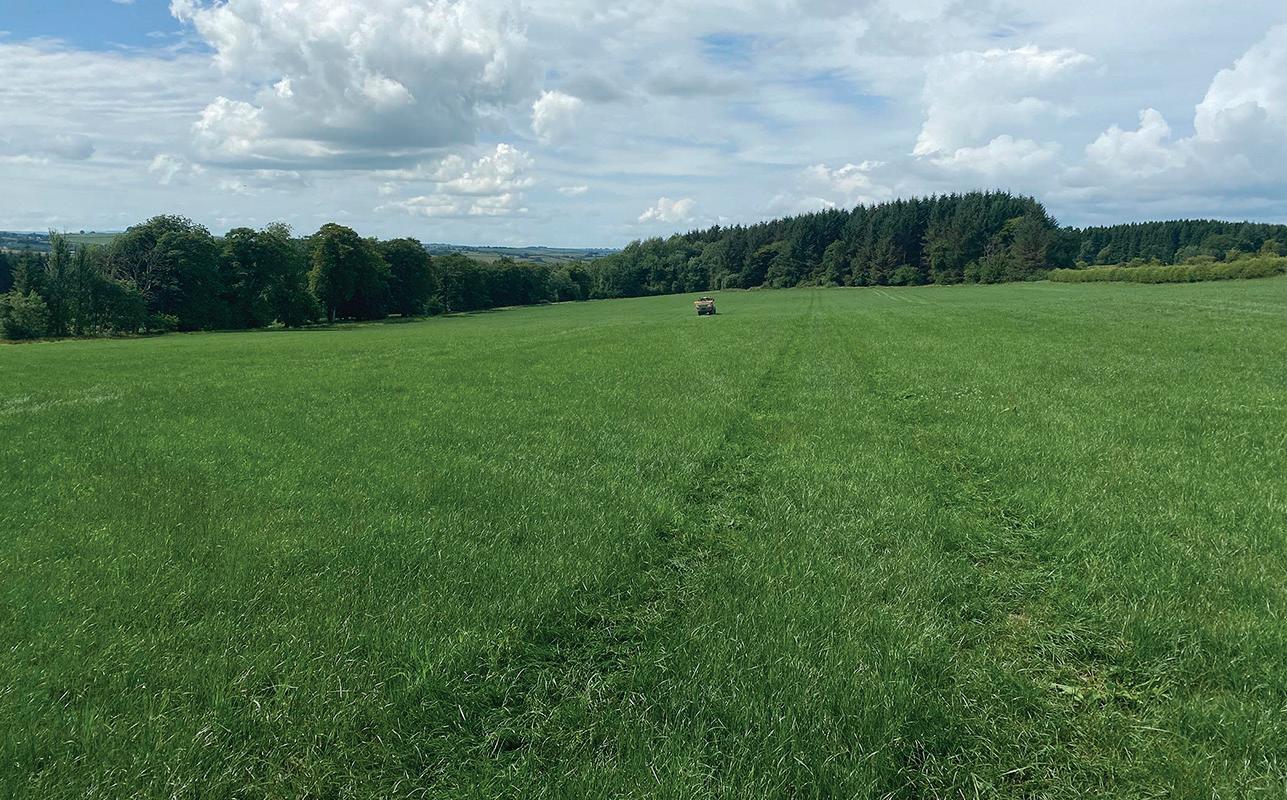


ces nitrogen availability to the grass.
By using a dribble bar with a ow meter and a tractor with autosteer, all part-funded through a previous Sco ish Government Sustainable Agriculture Capital Grant Scheme, accuracy of application is the key to success in terms of soil health.
SAC consultant Robert Ramsay, who is working with Mr Kerr on the project, says: “Where before, accuracy was a challenge for slurry and fertiliser applications, it can now be done with ease, with the system also keeping a record of applications, which is useful both for compliance and farm management purposes.
“By using the best application method at the correct time, nitrogen uptake is maximised and applications in spring achieve best utilisation of slurry nutrients.
“When it is applied between February and April, which coincides with the natural grass growth pa ern, there is good nitrogen e ciency.”
In the trials, when more arti cial nitrogen was applied, the silage yield was inevitably higher. However, Mr Ramsay adds it is important to see costs and returns in the round rather than in silos.
He says: “ ese trials have given some valuable insights to help Mr Kerr make management decisions around his silage crops and allowed him to do a cost analysis per tonne of fresh grass for each scenario. It is important to look at it holistically.
“If you can reduce fertiliser applications by even a small amount, when multiplied over many acres and several cuts, a signi cant saving can
It is not about making major changes, but small shifts: getting soil analysed
ROBERT RAMSAY
be achieved in your total fertiliser bill. Conversely, that extra load could ll the pit for much needed organic fertiliser, which makes it worth the spend.”
As a farmer himself, Mr Ramsay says, the FFBC trials are deliberately farmer-friendly and can be replicated on any farm.
He says: “We are o en guilty of not challenging our systems or ourselves, but it is something we could all be doing. By checking whether the soil is limiting the yield potential or using data to inform nutrient applications, we can be savvier with where we spend and save.
Basic questions
“It is not about making major changes, but small shi s: ge ing soil analysed, asking some basic questions and trying out di erent rates across one eld. e bene ts for the environment will naturally come with these changes.”
FFBC supports farmers to integrate pragmatic changes to reduce their environmental footprint, as well as improve nancial margins. is project at Woodhead Farm has highlighted the advantages of using more slurry to not only boost soil biology and the retention of nitrogen, but the o se ing of synthetic inputs keeps emissions down.
e project has also raised other questions on where nancial and environmental gains could be made. For example, could increasing yield save money on contractor costs and farm carbon emissions by cu ing less acres?
JANUARY 2024 66 RESEARCH
John Kerr farms 141 hectares (348 acres) of predominantly grass at Woodhead Farm, Ayrshire.
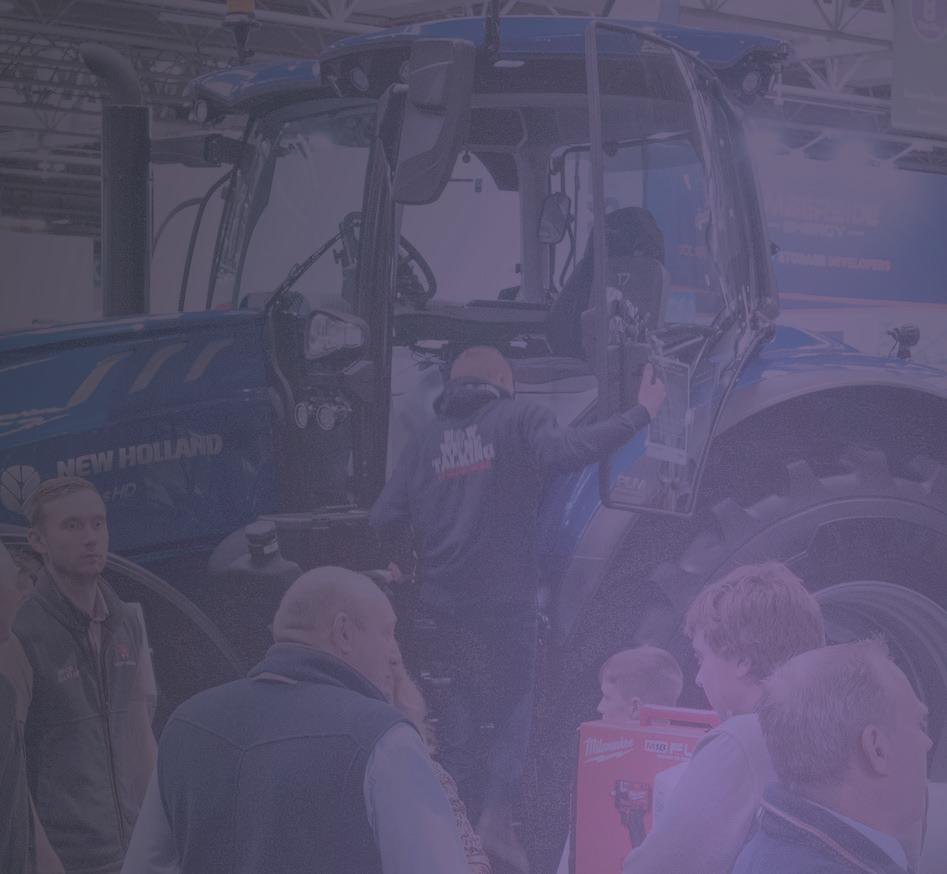
WIN A POLARIS POWERHOUSE ATV
To enter, register for LAMMA show by midnight on Tuesday 16th January 2024 to be entered into the prize draw to win a Polaris Powerhouse ATV. Entrants must be aged over 17 years and hold a full UK driving licence.

BE PART OF THE ACTION!















































LAMMAShow.com
Read the LAMMA ATV full terms & conditions at www.lammashow.com/polaris-atv-competition-terms-conditions
ADVANCING PROTECTION AGAINST CALF SCOUR

HELPING END THE NIGHTMARE OF CALF SCOUR FOR A FAIRYTALE START
FENCOVIS®
Stimulates immunity against Rotavirus, Coronavirus and E.coli K99 in pregnant cows and heifers, so that calves receive added protection via the colostrum.
• Prevents scour caused by Rotavirus and E. coli K99
• Inactivated vaccine with an oil-free adjuvant
• 2 ml single dose intramuscular injection
• Administered to the dam 12-3 weeks before calving
• Ready to use injections available in 1, 5, and 25 dose packs
• Available from your veterinary surgeon
To find out more scan the QR code or find us at calfmatters.co.uk and calfmatters.ie
Fencovis® suspension for injection contains inactivated E. coli expressing F5 (K99) adhesin, strain O8:K35; inactivated bovine rotavirus, serotype G6P1, strain TM-91; inactivated bovine coronavirus, strain C-197. Fencovis® is indicated for active immunisation of pregnant heifers and cows in order to stimulate the development of antibodies against bovine rotavirus, bovine coronavirus and E. coli expressing F5 (K99) adhesin and to increase the level of passive immunity of calves against neonatal diarrhoea caused by bovine rotavirus, bovine coronavirus and E. coli expressing F5 (K99) adhesin. Fencovis® has been shown to prevent neonatal diarrhoea caused by bovine rotavirus and E. coli expressing F5 (K99) adhesin, reduce the incidence and severity of neonatal diarrhoea caused by bovine coronavirus and reduce faecal shedding of virus in calves infected with bovine rotavirus and bovine coronavirus. UK: POM-V IE: POM. For information about side effects, precautions, warnings and contraindications please refer to the product packaging and package leaflet. Advice should be sought from the prescriber. Further information available in the SPC or from Boehringer Ingelheim Animal Health UK Ltd, RG12 8YS, UK. UK Tel:01344 746957 IE Tel: 01 291 3985. Email: vetenquiries@boehringer-ingelheim.com. Fencovis® is a registered trademark of Boehringer Ingelheim Vetmedica GmbH, used under licence. ©2023 Boehringer Ingelheim Animal Health UK Ltd. All rights reserved. Date of preparation: Nov 2023. BOV-0114-2023. Use Medicines Responsibly.














































 Ifan Roberts
Ifan Roberts


























 Phil Christopher
Phil Christopher














































































































































































































































































































































































































































































